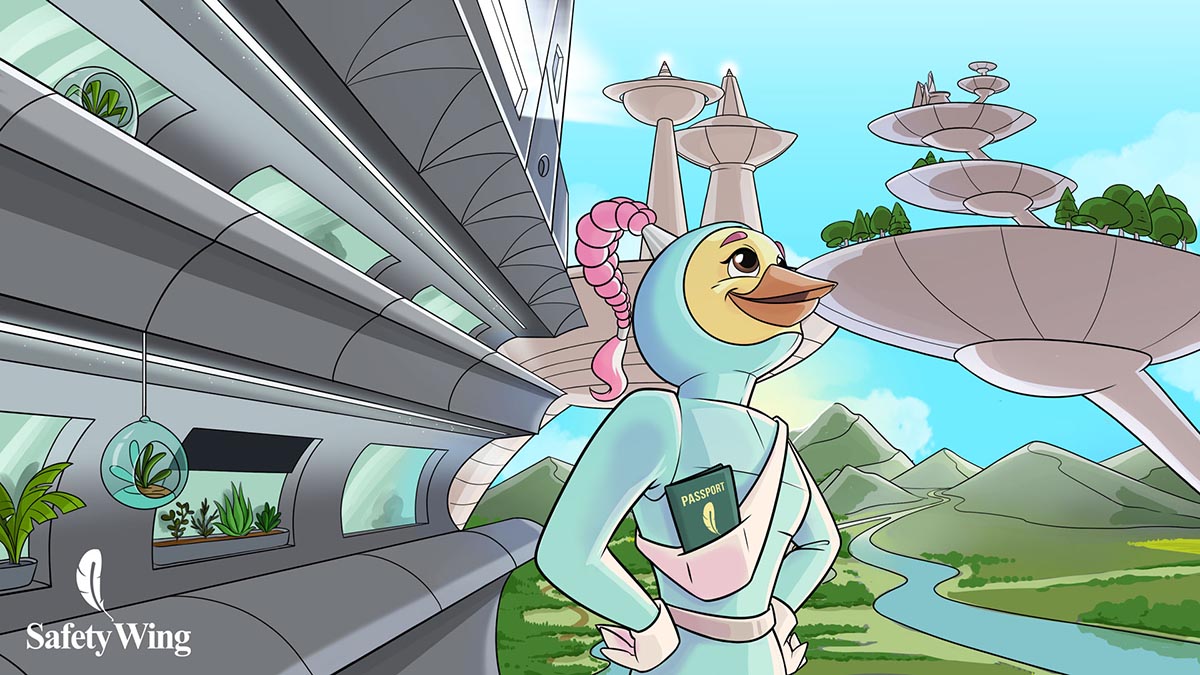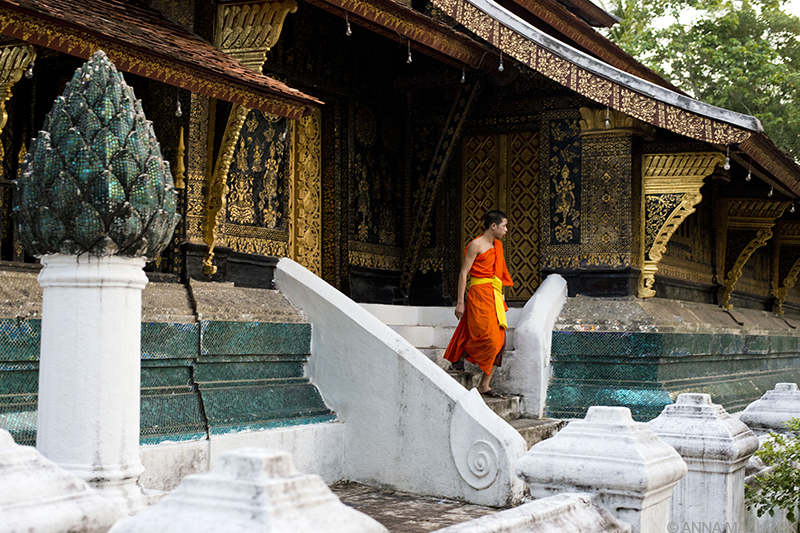
Where to Go in Southeast Asia
 Tat Kuang Si Waterfall is a good day trip from Luang Prabang, Laos!
Tat Kuang Si Waterfall is a good day trip from Luang Prabang, Laos!
Southeast Asia is the perfect travel destination – it’s cheap, safe and beautiful. Plus, it’s always flip-flop weather!
There’s no place I love more than Asia. I’ve spent years managing photo trips for a travel company in Southeast Asia and live in Chiang Mai every winter. From jungle treks to ancient ruins, keep reading for my favorite places to visit and things to do in Southeast Asia.
Affiliate links are used in this post. If you make a purchase, I earn a small commission at no cost to you, which goes toward the cost of maintaining this blog.
Plan Your Trip
Travel Insurance: Protect yourself with SafetyWing travel medical insurance to cover accidents and travel delays.
Mobile eSIM Card: Get seamless connectivity worldwide with Airalo minus the hassle of physical SIM card. (Save 10% with code AIRALOESIM10!)
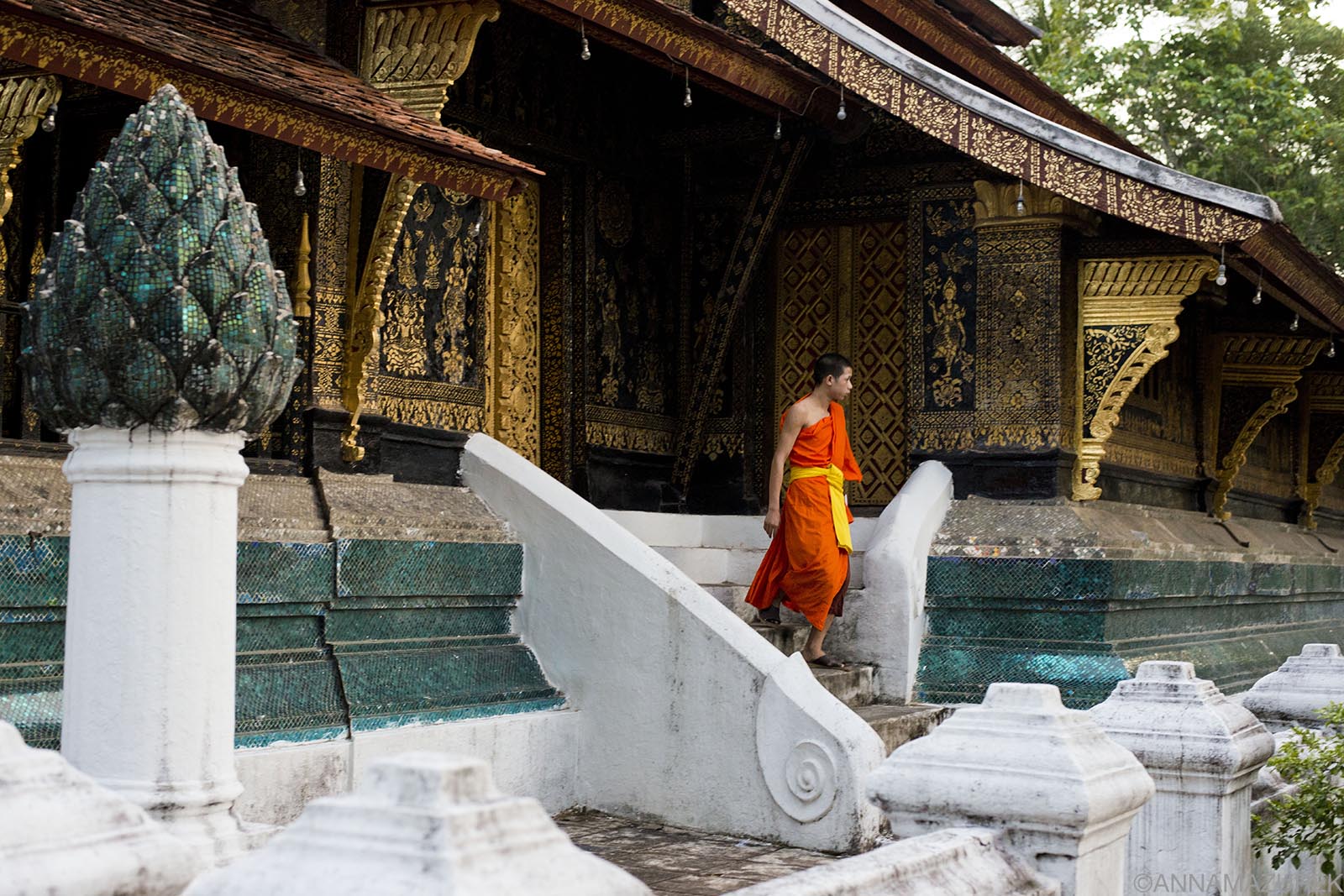 Built in 1560, Wat Xieng Thong in Luang Prabang is one of the most important Buddhist temples in Laos.
Built in 1560, Wat Xieng Thong in Luang Prabang is one of the most important Buddhist temples in Laos.
Luang Prabang, Laos
Luang Prabang is one of my favorite cities in the world and a traveler’s dream. The entire city is a UNESCO World Heritage site surrounded by lush mountains and sliced in half by the mighty Mekong River. The former French colony opened for tourism in 1989 making it one of Southeast Asia’s best-kept secrets.
The former royal capital is known for well-preserved golden temples and the daily morning procession of monks who walk the streets collecting alms from locals. The town center is lined with delicious French restaurants, cafes and bakeries like JOMA, Popolo, Bamboo Garden, Family Bakery Restaurant and Le Banneton Café & French Bakery.
Don’t miss the local street market one block over – fresh crepes, fish and local stir-fries are available every morning for cheap. Be sure to hike the impressive Tat Kuang Si Waterfall and take a boat trip down the Mekong to visit the Buddha-filled Pak Ou Caves. (Price tours with local agencies and Klook to find the best options.)
IMPORTANT TIP: If you go to the monk alms ceremony, be respectful of the monks! Take photos from a distance and not directly in their faces. Dress conservatively, and do not stand higher than the monks. (You’ll notice most locals are seated.) Avoid giving the monks food because there’s been a huge issue with on-site street vendors selling foreigners old food that makes the monks sick. Let only the locals give food.
Where to Stay in Luang Prabang
I like Meunna Boutique Hotel ($70 USD/night) because it’s a quiet location with a pool that’s walkable to any spot in the city. It’s hard to find a room with a good desk for working so that’s also why I love this post.
Cheaper options include the rooms at Maison Barn Laos for $39/night or the $8/night dorms at La Casa Hostel.
For a fancier waterfront spot, I like the Belle Rive Boutique Hotel ($117/night). Its riverside restaurant is my favorite sunset spot.
How to get to Luang Prabang
The easiest way is to fly—I recommend either Bangkok Airways or Vietnam Airways. There’s a new high-speed train that makes the journey from the capital of Vientiane in less than 2.5 hours. Tickets sell out fast days in advance, so ask your accommodation for help. Check out my Instagram story about my experience! You can take boats downstream from the upper Mekong but a new dam built above Luang Prabang means you’ll be take by van for the last few kilometers. The roads are windy so avoid buses if you can.
When to go to Luang Prabang
I prefer the rainy season which lasts roughly from April to October, which usually means brief showers daily. It’s much lusher. March is the hottest month. November to January are the coolest months and most crowded. The bamboo bridges are up this time of year, which is fun. I either go in August or January.
 Two angles of the giant Buddha statue at Wat Si Chum in Sukhothai Historical Park.
Two angles of the giant Buddha statue at Wat Si Chum in Sukhothai Historical Park.
Sukhothai Historical Park, Thailand
My favorite place in Thailand is Sukhothai Historical Park, the site of the 13th- and 14th-century capital of Siam. Within the old city walls of the UNESCO World Heritage site, there are 21 sets of gorgeous ruins and another 70 in a five-kilometer radius, which are best visited by bike or motorbike. (I always rent a bike by the park entrance for less than $1 USD.)
The size of the park makes it easy to escape the crowds. The ruins are more centralized and much less crowded than Ayutthaya, whose sites are spread across the town and surrounded by pushy street vendors.
My favorite ruins are Wat Si Chum featuring a famous giant Buddha statue above; Wat Mahathat, the largest ruin and former royal palace, and the Khmer style temple, Wat Si Sawai, that is reminiscent of Angkor Wat.
For a very local experience, visit the nearby site of Si Satchanalai, which is part of the same UNESCO designation. (Sukhothai was the political head of the first kingdom of Thailand while Si Satchanalai was the spiritual headquarters.) For details on how to visit, check out my Instagram highlight on Si Satchanalai.
Where to Stay in Sukhothai
On my last visit, I stayed at TR Guesthouse ($14 USD/night for a private room) and really liked it. Free breakfast is included.
How to get to Sukhothai
The park is a few hours north of Bangkok and the perfect stop enroute to Chiang Mai. Catch a bus from Bangkok’s northern bus station, Mo Chit. The closet train station is Phitsanulok, an hour away. The park is 12 km from the new town of Sukhothai and easily accessible by tuk tuk or a songthaew (pickup truck style bus). The entrance fee for foreigners is 100 Baht ($2.80 USD) for each zone or 350 Baht ($10 USD) for all five zones.
When to go to Sukhothai
Avoid March and April when it’s steaming hot. The dry season, from November to February, has best weather while June to October is monsoon season. I prefer the rainy season when the trees are a vibrant green and the puddles make for great photos.
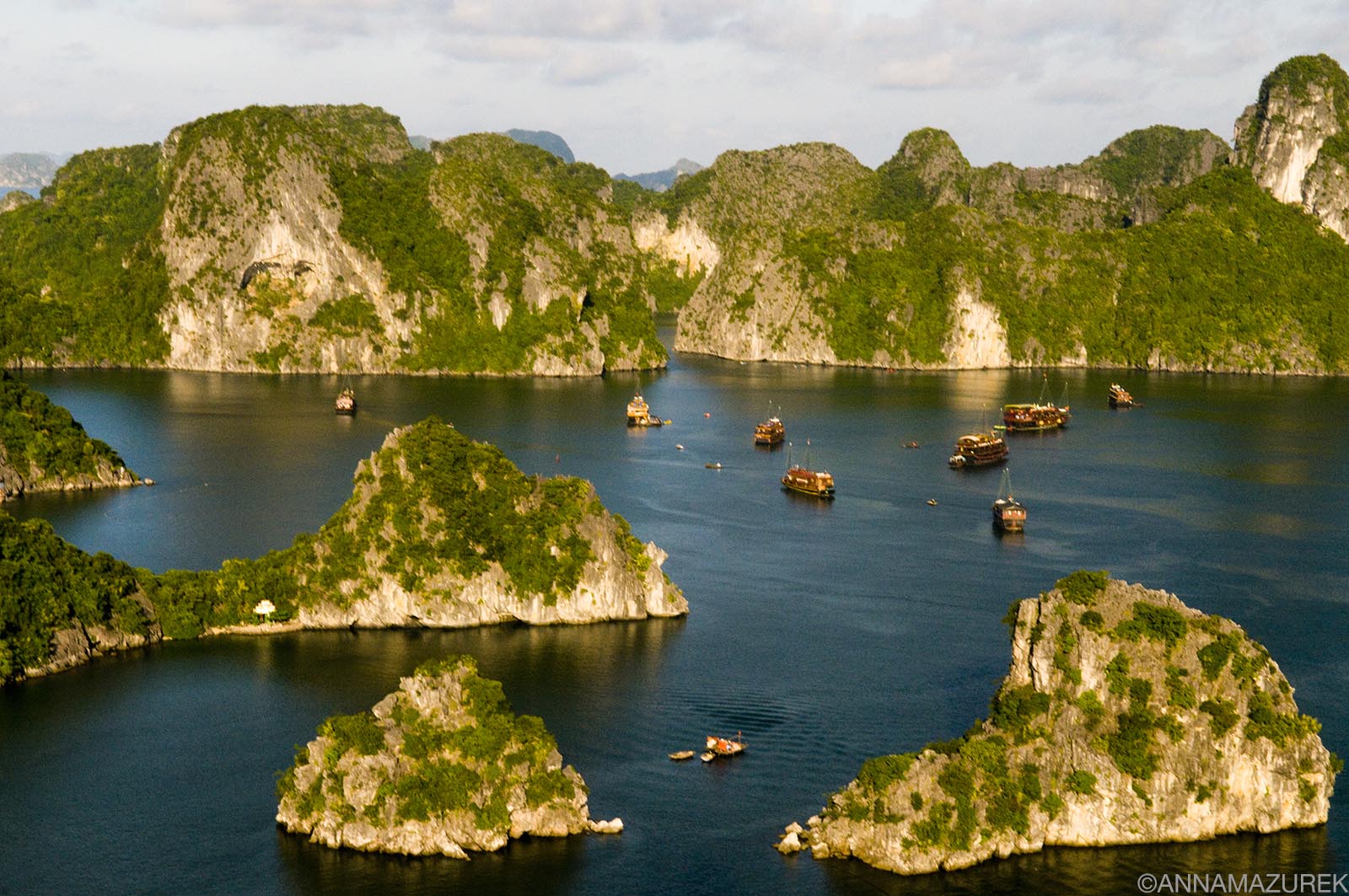 A bird’s eye view of Ha Long Bay, Vietnam.
A bird’s eye view of Ha Long Bay, Vietnam.
Ha Long Bay, Vietnam
Ha Long Bay is one of those places like Machu Picchu that you must visit once in your life. The scenery is postcard-perfect: limestone pillars and tiny islands scattered through the Gulf of Tonkin’s emerald waters. It is the number one attraction in Vietnam.
The best way to experience the bay is to do a multiple-day cruise on a houseboat to explore the islands, swim and eat year weight in fresh seafood! There are short boat trips and overnight cruises for every budget. I recommend spending a night or two on a houseboat!
How to Get to Ha Long Bay, Vietnam
Boats depart from the less-appealing port town of Halong City. It’s four hours north of Hanoi by car or bus. Klook offers budget-friendly transfers and tours.
When to go to Ha Long Bay
Avoid February to April when it’s cool and drizzly. Peak season is June to mid-August, which also corresponds with tropical storm season. November is best for blue skies and calm seas. (I’ve been in July and January.)
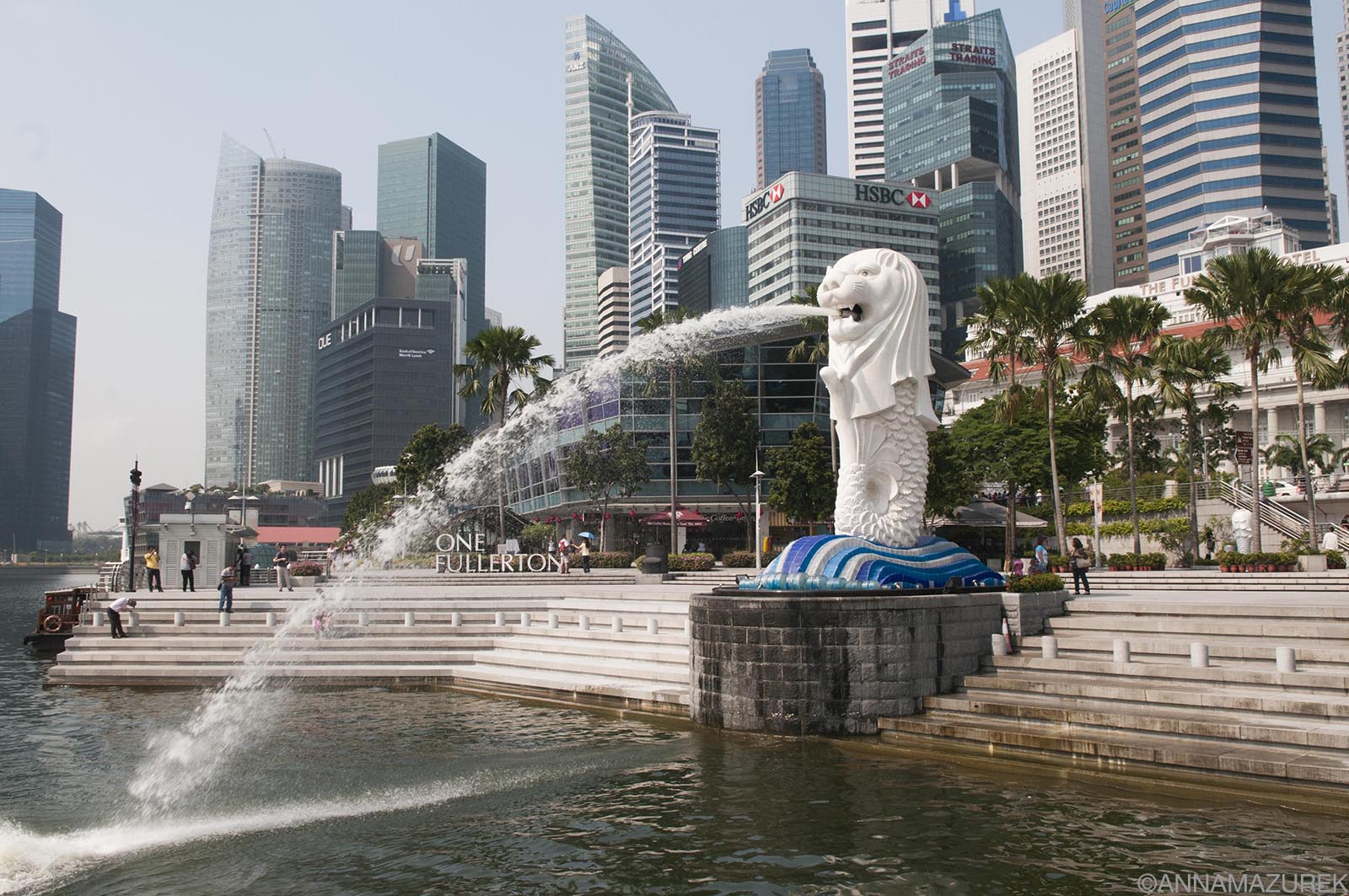 Singapore’s famous Merlion, a half-lion and half-fish statue guards Marina Bay.
Singapore’s famous Merlion, a half-lion and half-fish statue guards Marina Bay.
Singapore
Singapore is the New York City of Southeast Asia, filled with sleek skyscrapers, world-class museums and culinary delights.
The only way to fully understand Singapore’s kaleidoscope of cultures (Chinese, Malay, Indian and Western) is to explore the museums, including The National Museum of Singapore and the Peranakan Museum. Other highlights include the famous Supertree Grove of vertical gardens at the Gardens by the Bay and the view from the rooftop bar of Marina Bay Sands Resort.
Despite its sleek and sophisticated exterior, the heart of the city is the countless food stalls that serve up tasty treats like traditional kaya (coconut jam) toast and Hainanese chicken rice.
For more, read my detailed Singapore guide!
Where to Stay in Singapore
I really love the location of 30 Bencoolen because it’s only a 20–30-minute walk to Chinatown or downtown.
If you’re looking to splurge or cash in points for a luxury stay, then the most iconic hotels are Raffles Singapore, Fullerton Bay Hotel and Marina Bay Sands.
How to get to Singapore
You can fly to Singapore from just about anywhere. Changi Airport is the nicest airport in the world. (Trust me, you WANT a layover in Singapore.) It’s easily accessible by bus from Peninsular Malaysia and by ferry from parts of Indonesia.
When to go to Singapore
Monsoon season lasts from November to January. June to September is when the rain clears off and temperatures spike a bit. Overall, it’s usually 81-87 °F year-round.
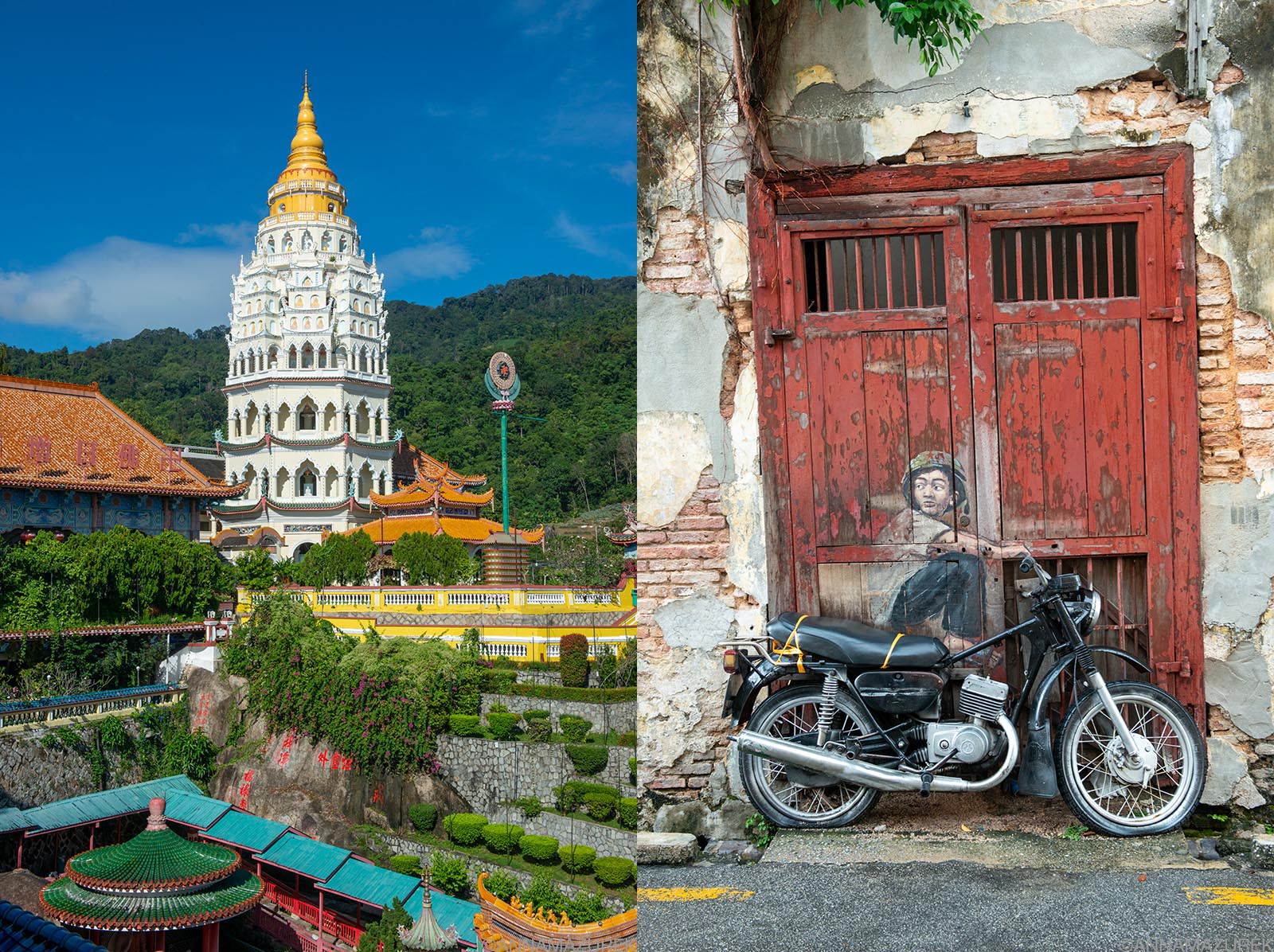 Left: The colorful Buddhist temple of Kek Lok Si; Right: George Town’s famous street art.
Left: The colorful Buddhist temple of Kek Lok Si; Right: George Town’s famous street art.
George Town, Malaysia
Like Singapore, George Town (the capital of the island state of Penang) is a mixture of three cultures and various types of architecture, ranging from Chinese shophouses to British colonial buildings.
It’s also the street art capital of Southeast Asia. Pick up a map from your hotel or the tourism association to guide you through the labyrinth of 3D artwork and murals like the one decorating the shop where Penang native and famous shoemaker Jimmy Choo first apprenticed.
Be sure to eat the crispy chicken with plum sauce for dinner at Tek Sen! Other highlights include the house museums including the famous Blue Mansion.
How to get to George Town, Malaysia
It’s easily accessible by plane from across Southeast Asia. There is a train service from Kuala Lumpur (KL) and buses from all over Malaysia. (I took the bus from KL many times, which was comfy and nice.)
When to go to George Town, Malaysia
The weather doesn’t fluctuate much here. Holidays like Chinese New Year will be crowded. November and December are when temperatures drop a little.
 Thomas’s leaf monkeys (left) and Sumatran orangutan (right) in Gunung Leuser National Park on Sumatra, Indonesia.
Thomas’s leaf monkeys (left) and Sumatran orangutan (right) in Gunung Leuser National Park on Sumatra, Indonesia.
Gunung Leuser National Park, Sumatra, Indonesia
The Indonesian Island of Sumatra parallels peninsular Malaysia and Singapore and is known for the diversity of its tropical forests. One of the highlights is Gunung Leuser National Park, a UNESCO biosphere reserve that’s home to the critically endangered Sumatran orangutans and endemic Thomas’s leaf monkey. The main hub for visiting the park is the town of Bukit Lawang where orangutan treks can be arranged with guides. (I have been to all seven continents, and this is arguably one of the coolest experiences of my life.)
When to go to Sumatra
Fruit is more plentiful in the rainy season (November to March) making it easier to see the orangutans. I visited in August with no rain and great orangutan sightings.
How to get to Sumatra
Medan is the closest major city with an airport. From there, you can bus or drive. Transfers can also be arranged via Klook.
Where to stay in Bukit Lawang
I stayed at Rindu Alam Hotel, which had convenient access to the jungle trails to Gunung Leuser National Park. It’s a no-frills hotel with large, air-conditioned rooms. The location and food were fantastic!
 A sunrise view from the top of Baphuon temple in Angkor Thom in Cambodia.
A sunrise view from the top of Baphuon temple in Angkor Thom in Cambodia.
Angkor Wat, Cambodia
Angkor Wat, the largest religious structure in the world, is Cambodia’s claim to fame—it adorns everything from the currency to the national flag. While the most famous temples in the Angkor Archeological Site are Angkor Wat, Ta Prohm (Tomb Raider temple) and Bayon, there are dozens of other temples built by the same god-kings nearby that are worth exploring.
I visit Angkor every year for work and my personal favorites are Preah Kahn, Baphuon and Pre Rup. (Banteay Kdei is a less-crowded alternative to Ta Prohm.) To make the most of your visit, consider buying at three- or five-day pass.
Venture further for fewer crowds at the Roluos temple group (short tuk-tuk ride east of Siem Reap) or drive northeast to the tiered-pyramid of Koh Ker and the unrestored jungle temple of Beng Mealea. To fully escape the crowds, check out the story I wrote for National Geographic for other remote temple complexes.
The charming tourist town of Siem Reap is the gateway to the Angkor temples. It’s a fun town with great food options like Wild, Sambo Khmer & Thai Restaurant, New Leaf Eatery, Mamma Shop Italian and Fellini. The best craft beer spot in town is Embargo Craft Beer.
Gelato Lab has the best ice cream.
How to get to Siem Reap
Siem Reap is accessible by plane from most major cities in Southeast Asia. (I always fly from Bangkok, Singapore or Ho Chi Minh.) It’s a six-hour drive or bus ride from Phnom Penh.
When to go to Angkor Wat
The rainy season is from May to October. (I personally prefer the end of the rainy season when everything is lush and green.) The weather is cooler (but still hot) from November to February, but all the rice fields and trees are brown.
Where to stay in Siem Reap
The Hari Residence Hotel ($55-60 USD/night) is one of my favorites—rooftop pool and free breakfast.
For more budget-friendly options, consider the highly-rated The Urban ($22 USD/night) or Boutique Indochine d’Angkor ($22 USD/night on Booking.com). Hostels, like Lub d Cambodia Siem Reap and Bokre Angkor Hostel range from $4-14 USD a night.
If you’re looking to splurge on a fancy resort, then I recommend Raffles Grand Hotel d’Angkor or Sofitel Angkor Phokeethra Resort. (This is where I stay for work.)
Miniature tuk tuks at a market in Bangkok.
Southeast Asia FAQ
Do you need travel medical insurance for Southeast Asia?
Yes, travel medical insurance is one of the most important things to purchase for any trip abroad, especially Southeast Asia. It covers all the things that could go wrong from injuries to travel delays so that you don’t have to worry and can focus on traveling!
I use SafetyWing’s Nomad Insurance, which offers $0 deductible travel medical insurance coverage for over 180 countries for people aged 69 and under when traveling outside their home country. The best part is that it only costs a few dollars a day! If you get sick or injured abroad, you can visit any hospital or doctor. Other benefits of Nomad Insurance include coverage for lost checked luggage, travel delays over 12 hours, motor accidents (if properly licensed, wearing all safety equipment and not intoxicated) and injuries from sports or leisure activities. You can even add adventure sports, electronics theft and U.S. coverage (for non-residents) to your policy.
If you’re abroad for 90 days, you can get 30 days of home-country coverage. (For the U.S. residents, it’s 15 days.) Plus, every single part of the process from purchasing a policy to filing a claim is easy, which is why SafetyWing has been the best travel medical insurance policy for me.
For more details about my experience using SafetyWing in Southeast Asia, read my SafetyWing Review.
Where’s the best place to buy a SIM card for Southeast Asia?
If you are traveling to multiple countries in Southeast Asia on a short trip, then consider one of their Asia Regional eSIM cards. (Both the country-specific and regional eSIMs have worked wonderfully for me and even have a mobile hotspot option that’s critical for me because I’m always working remotely.) Keep in mind it’s always cheaper to buy a country-specific eSIM than a regional one.
Be sure to join the free Airalo Loyalty Program to earn 5% cash back for every purchase, which can be redeemed on future purchases. For more about eSIM cards, read my Airalo Review and guide to pros and cons of eSIM cards.
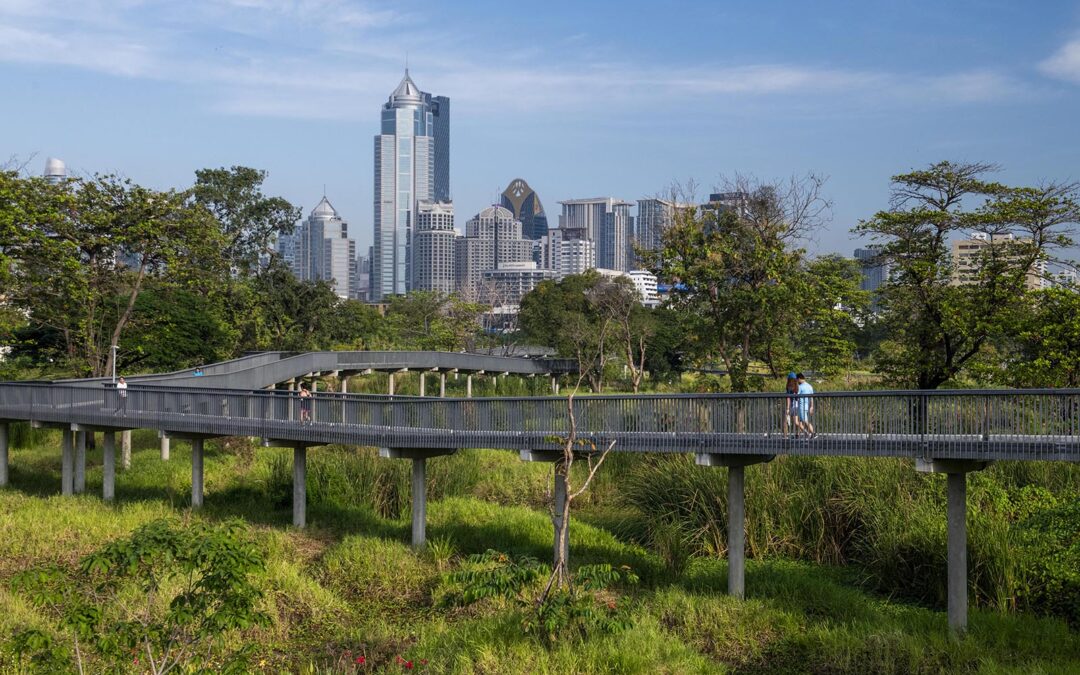
Things to do in Bangkok
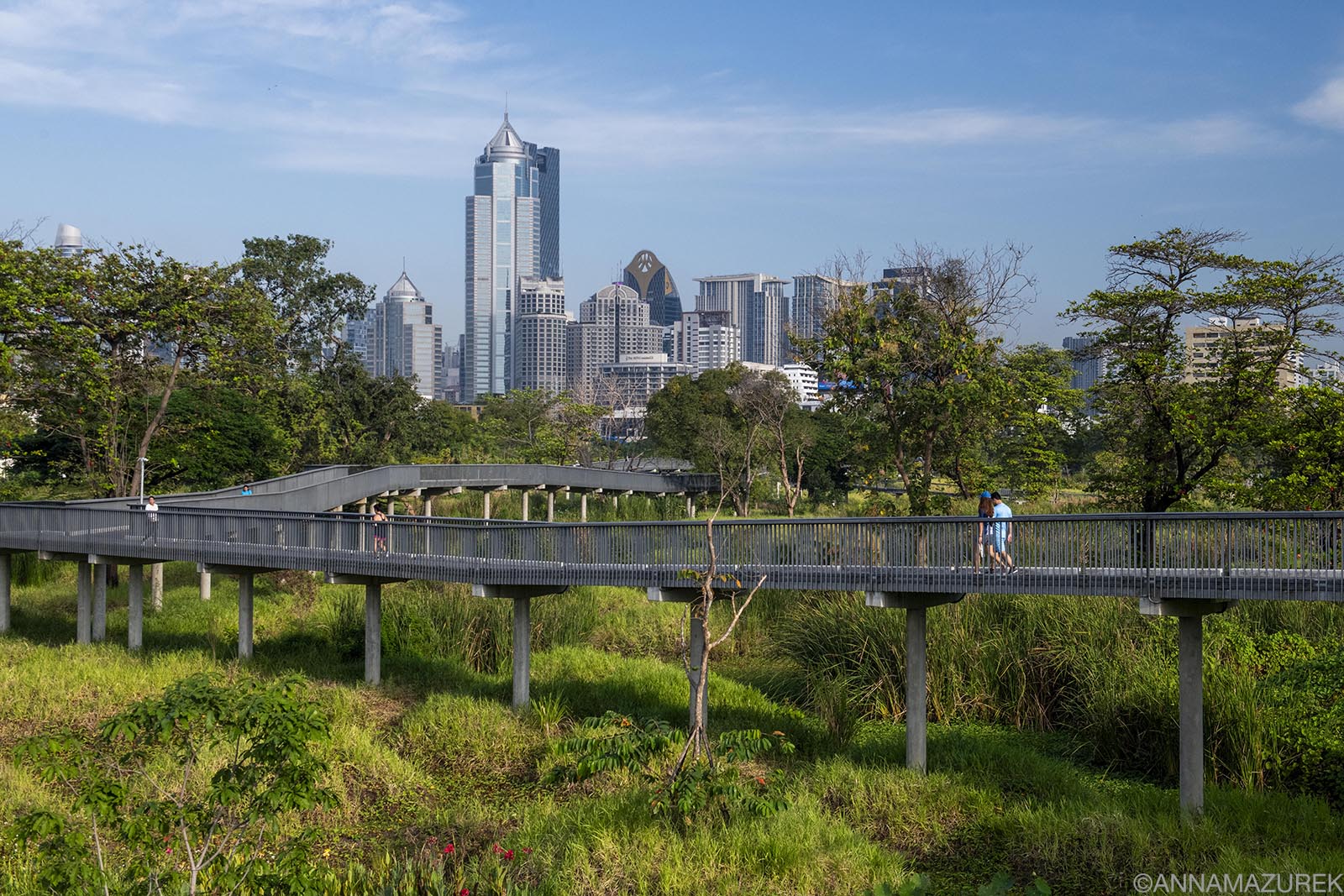 A former industrial site in the heart of Bangkok was transformed into the 102-acre Benjakitti Park in 2022.
A former industrial site in the heart of Bangkok was transformed into the 102-acre Benjakitti Park in 2022.
There’s no denying that Bangkok buzzes with energy—the bustling modern city located on the banks of the Chao Phraya River is filled with towering skyscrapers, ancient temples and vibrant street life. The Thai capital, home to 11 million people, boasts a sleek, air-conditioned public transit system making it easy to zip between neighborhoods at an affordable rate while avoiding the city’s notorious traffic. The hardest part of visiting Bangkok is deciding what to do.
From temple hopping to perusing the stalls at the Chatuchak Weekend Market, this guide covers the best things to do in Bangkok, including where to stay and eat. (If you want to visit Moo Deng (famous baby hippo) from Bangkok, check out my guide.)
Affiliate links are used in this post. If you make a purchase, I earn a small commission at no cost to you, which goes toward the cost of maintaining this blog.
Plan Your Trip
Currency: Thai Baht (THB)
When to Go: November to February for cooler temperatures.
Travel Insurance: Protect yourself with SafetyWing travel medical insurance to cover accidents and travel delays.
Mobile eSIM Card: Get seamless connectivity worldwide with Airalo minus the hassle of physical SIM card. (Save 10% with code AIRALOESIM10!)
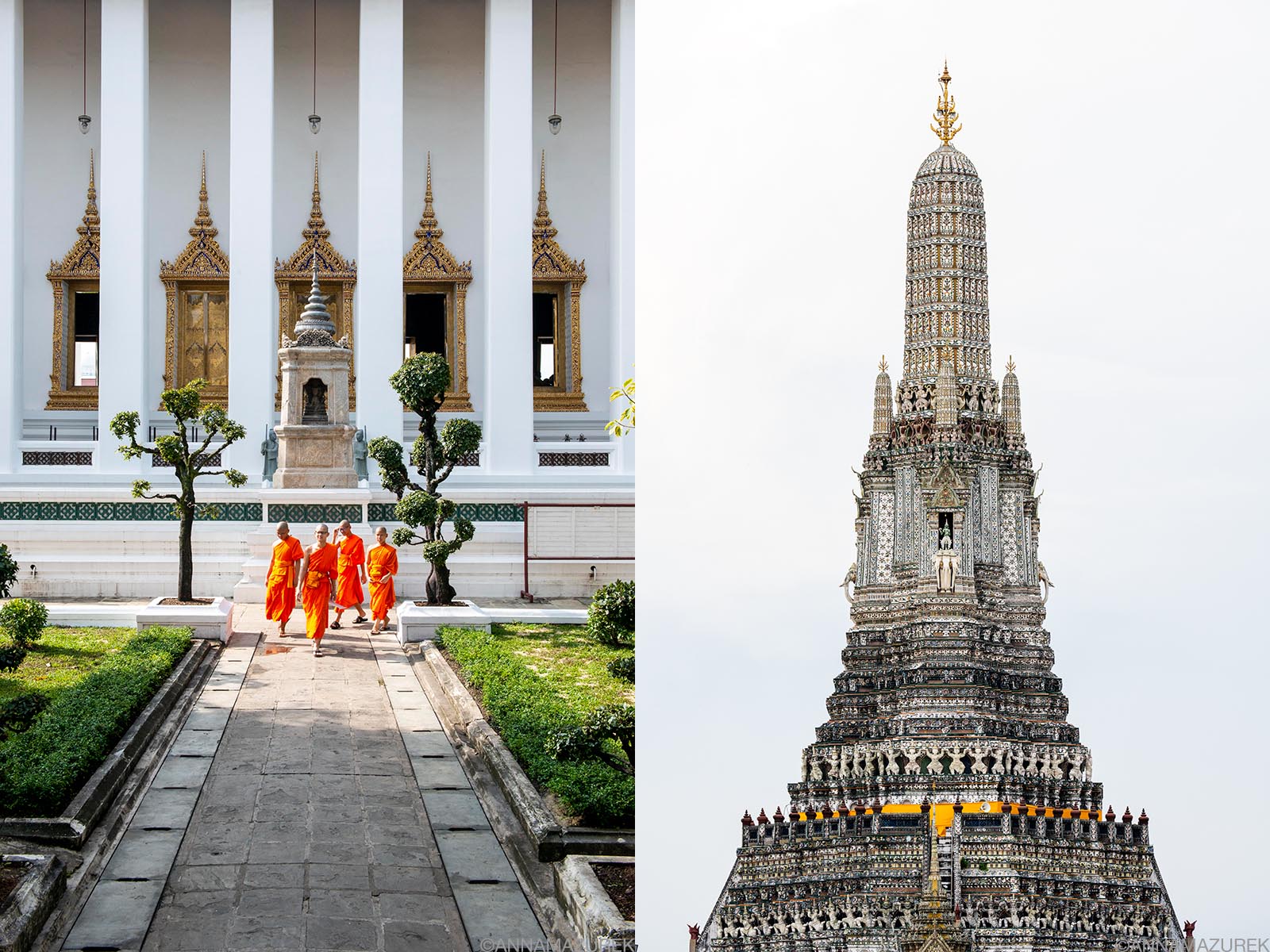 Left: Monks at Wat Suthat, one of Bangkok’s most stunning temples; Right: The 82-meter-high Wat Arun photographed from across the Chao Phraya River.
Left: Monks at Wat Suthat, one of Bangkok’s most stunning temples; Right: The 82-meter-high Wat Arun photographed from across the Chao Phraya River.
The Best Things to Do in Bangkok
The Grand Palace, the former royal residence, is a must for your first trip. One of the highlights is the stunning golden 1782 temple complex of Wat Phra Kaew, home to the Emerald Buddha, the most revered image in Thailand that dates to the 13th and 14th centuries. (Admission: 500B/$14 USD) Consider booking online through Klook to skip the lines. Cover your knees and wear long sleeves or you’ll be forced to rent clothing.
Wat Pho is near The Grand Palace and home to the largest reclining Buddha in the city. (Admission: 100B/ $2.80 USD)
Wat Arun. Take a boat across the river from the Grand Palace to visit the 82-meter-high Khmer-style tower of this grand Buddhist temple complex located on the Chao Phraya River. You can no longer climb to the top sadly. On your right after the ticket booth, you’ll see two giant guardian statues by a temple—Phaya Yak Wat Chaeng, which has a courtyard surrounded by Buddha statues that are lovely to photograph. (Be warned the temple is now overflowing with people dressing up in traditional clothing to take photos. Arrive early to beat the madness!) The best photo spot of the temple is across the river, which you can get to easily on a water taxi for five baht that leaves right by the temple’s entrance.
Traveling in Southeast Asia
Read my guides to Thailand, Chiang Mai, Vietnam and Singapore!
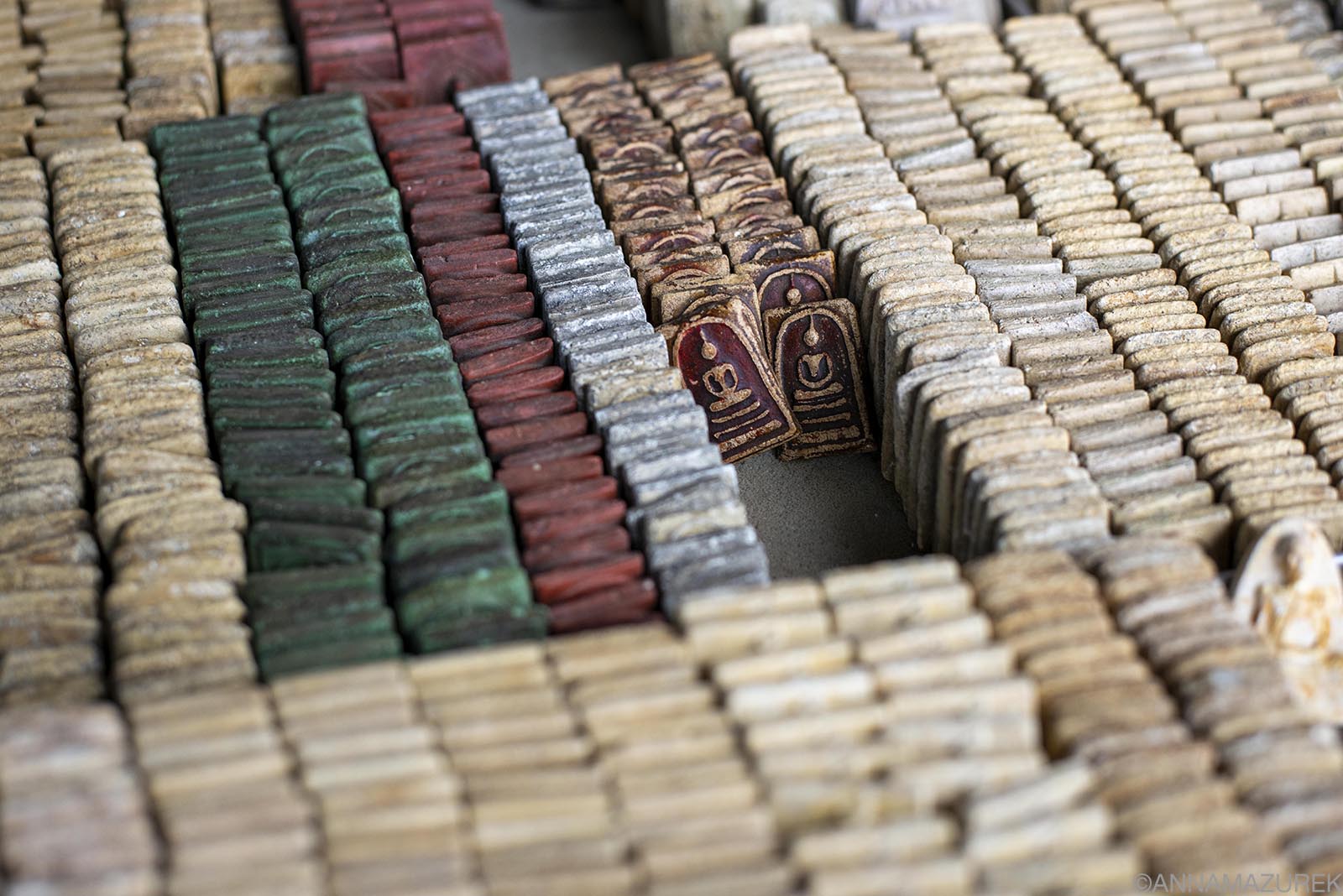 In Thailand, there is a different Buddha for each day of the week. Saturday is the naga Buddha in this image. These protective amulets are often worn as necklaces.
In Thailand, there is a different Buddha for each day of the week. Saturday is the naga Buddha in this image. These protective amulets are often worn as necklaces.
The Amulet Market is another great spot to hit if you’re by The Grand Palace. The market is a series of covered stalls selling amulets, protective talismans and Buddha statues. These trinkets are highly sought after by monks, taxi drivers and people in dangerous professions. I have bought several from here that I made into necklaces.
Jim Thompson House: This is the best thing in Bangkok. The house/art museum is the former home of American silk trader and antique collector Jim Thompson. The complex consists of six Thai-style houses moved from other parts of Thailand to the current location, which is within walking distance from the MBK center and the BTS Skytrain National Stadium stop. His art collection includes Buddha sculptures dating back to the 8th century along with paintings and porcelain. The art is what makes this place stunning. Photography is not allowed inside the houses. (Admission: 200B/$6 USD)
Wat Suthat holds one of the highest ranks of royal temples in the country. The photogenic courtyard is lined with Buddha statues, which is why it’s one of my favorite temples to photograph in Thailand! (Admission: 100B/$3 USD)
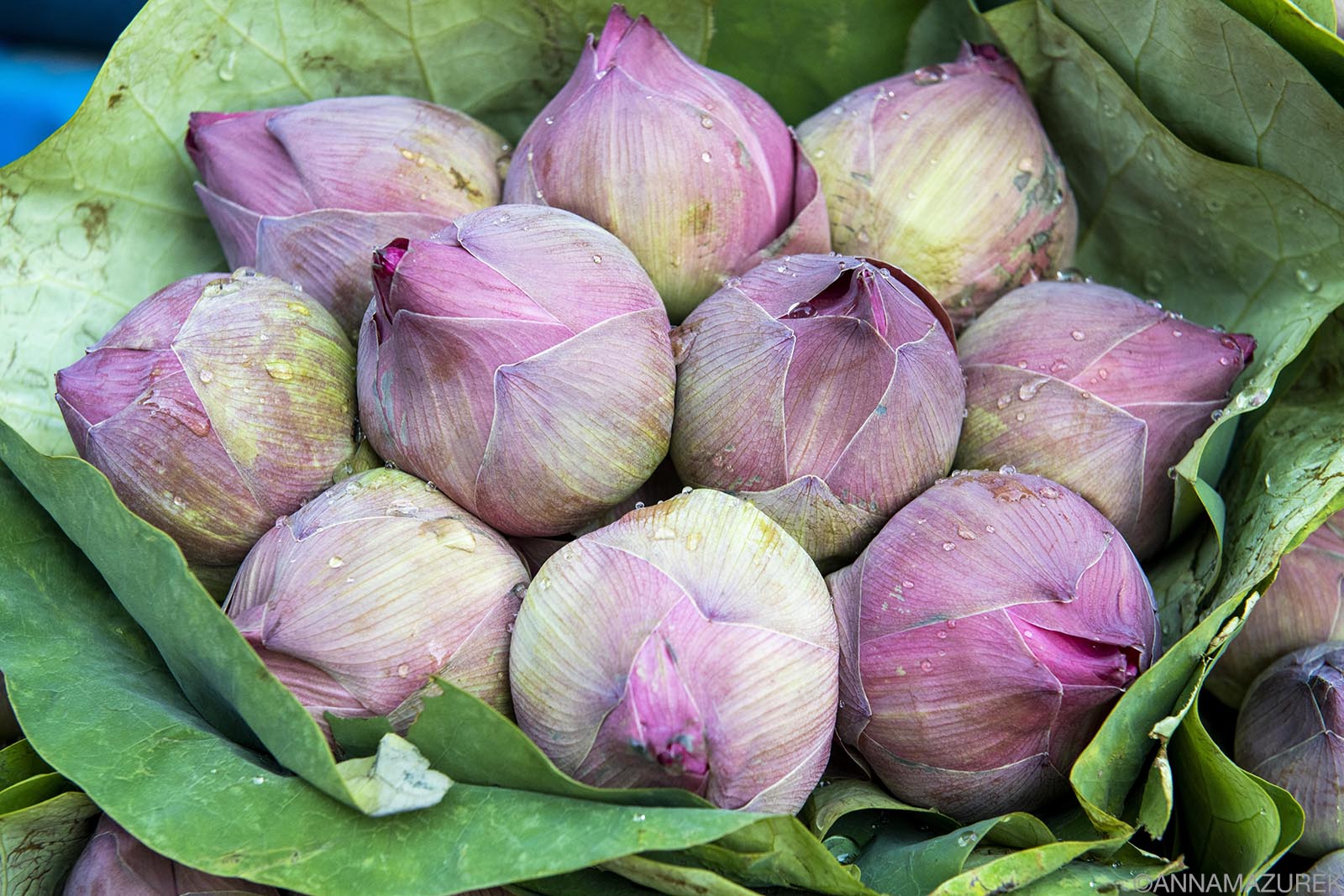 Lotus flowers at Chinatown’s bustling 24-hour flower market, Pak Khlong Talat.
Lotus flowers at Chinatown’s bustling 24-hour flower market, Pak Khlong Talat.
Pak Khlong Talat (Bangkok’s Flower Market): One of my favorite photo spots in Bangkok is the flower market in Chinatown, which doubles as the city’s largest vegetable market during the day. It was once a street market but now resides in a giant warehouse lined with stalls overflowing with orchids, carnations and women stealthy making temple offerings and good luck charms. It’s open 24 hours, but I prefer to go at sunrise to photograph the fresh flowers, which are delivered late at night. Klook offers guided tours if you’d rather not go solo
Wat Saket And The Golden Mount is a golden chedi located on the only hill in Bangkok. It’s worth climbing the 320 stairs to the top and spending some time exploring the sprawling complex. (Admission 50 Baht/$1.50 USD)
Giant Buddha at Wat Paknam Phasi Charoen: This 230-foot-tall Buddha was completed in 2021 on the outskirts of Bangkok. It’s a 15–20-minute walk from the BTS (Wutthakat station) and MRT stations (Bang Phai or Tha Phra stations). (Be warned –it’s covered in scaffolding as of November 2024.) There’s a great view from the Tha Phra MRT platform but often that end of the platform is closed.
Erawan Museum: A 14-story statue of Erawan, a mythical three-headed elephant known as Airavata, is one of the main attractions, known for its colorful interior staircase. The museum was the brainchild of antique collector Lek Viriyapant, who built the structure to house his collection but sadly passed away before it opened in 2003. It’s a bit of a trek to get here on the BTS (Chang Erawan Station (E17) exit 2), but I enjoyed my visit because I love Buddhist art. The grounds are lush and great for photos as well. I recommend visiting in the morning to avoid the crowds. Tickets are normally 400 Baht, but I bought mine almost half price on Klook.
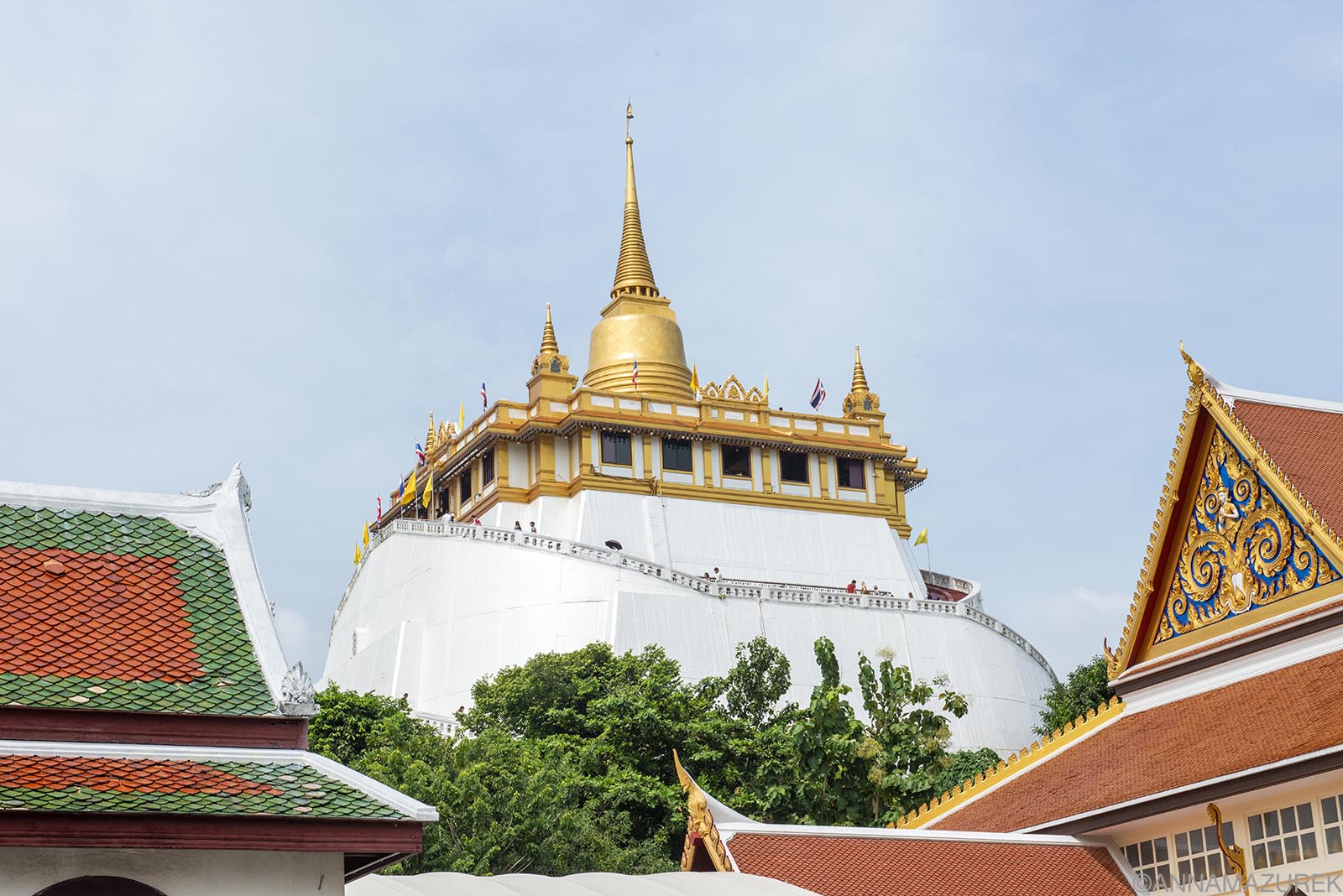 The Golden Mount Chedi is located on Bangkok’s only hill.
The Golden Mount Chedi is located on Bangkok’s only hill.
Where to Stay in Bangkok
Always choose accommodation near one of the train lines to make it easy to get around. I like to stay near the Siam area because it’s central but have also enjoyed staying near Lumphini Park.
Hotels: The Holiday Inn Express Siam ($88 USD/night) by the National Stadium BTS is my go-to when I need to work because it’s a great location with clean rooms, free breakfast and a gym. If you want to splurge, I recommend VIE Hotel Bangkok ($188 USD/night).
Hostel: I stayed at Bed Block One Hostel ($16 USD/night) for years and loved how close it was to Siam, Ratchathewi BTS station and the airport train
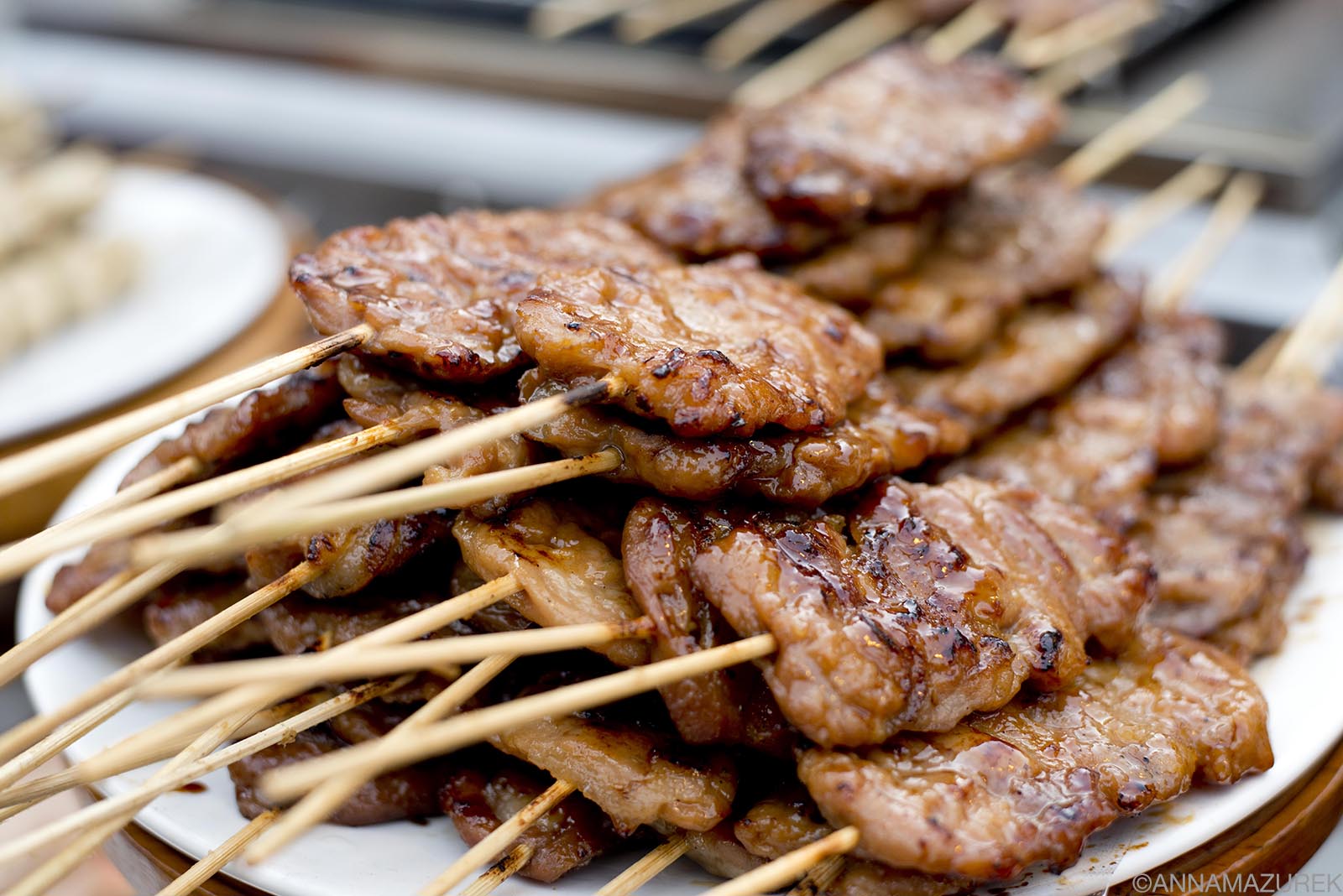 Moo ping, grilled pork skewers with a sweet marinade, at Chatuchak Weekend Market.
Moo ping, grilled pork skewers with a sweet marinade, at Chatuchak Weekend Market.
The Best Places to Eat and Shop in Bangkok
Chatuchak Weekend Market is Thailand’s largest market and my favorite place to shop. The sprawling complex is separated into 26 sections ranging from local artists to trendy boutiques to potted plants. The entire market is open on Saturdays and Sundays from 9 a.m. to 6 p.m. and is close to both the BTS Skytrain (Chatuchak Park stop) and MRT (Kamphaeng Phet stop). Early birds beware—the shops are never all fully open until at least 10 a.m.
Mall Food Courts
No one does malls as well as Thailand. The food court at MBK, a sprawling multi-level maze-like shopping mall in Siam, is the best. The food court is called Food Legends and is hidden on the sixth floor behind all the chain restaurants and vendor stalls. It consists of a series of side-by-side food stalls serving everything from curry to papaya salad with most meals costing less than 100 baht ($3 USD). (Don’t get it confused with the restaurants on the fifth floor, which is more obvious from the escalators than this hidden spot.)
To buy food, you have to put money on a meal card, which you use to pay for your food. Turn in your card before leaving to get a refund of any unused money. You’ll see the card booth as you enter.
Both the Terminal 21 and Siam Paragon shopping malls also have food courts. The food court is located on the top floor of Terminal 21 and the bottom floor of the Paragon behind all the normal restaurants. Both use a similar meal card system.
Thong Lo Neighborhood
If you are a foodie, then this is your neighborhood. Khao Jao is great for no-frills, authentic Thai food with high spice levels. Sit and Wonder is a hidden spot with a great atmosphere and delicious Thai food! Roast is a good treat if you’re craving Western food.
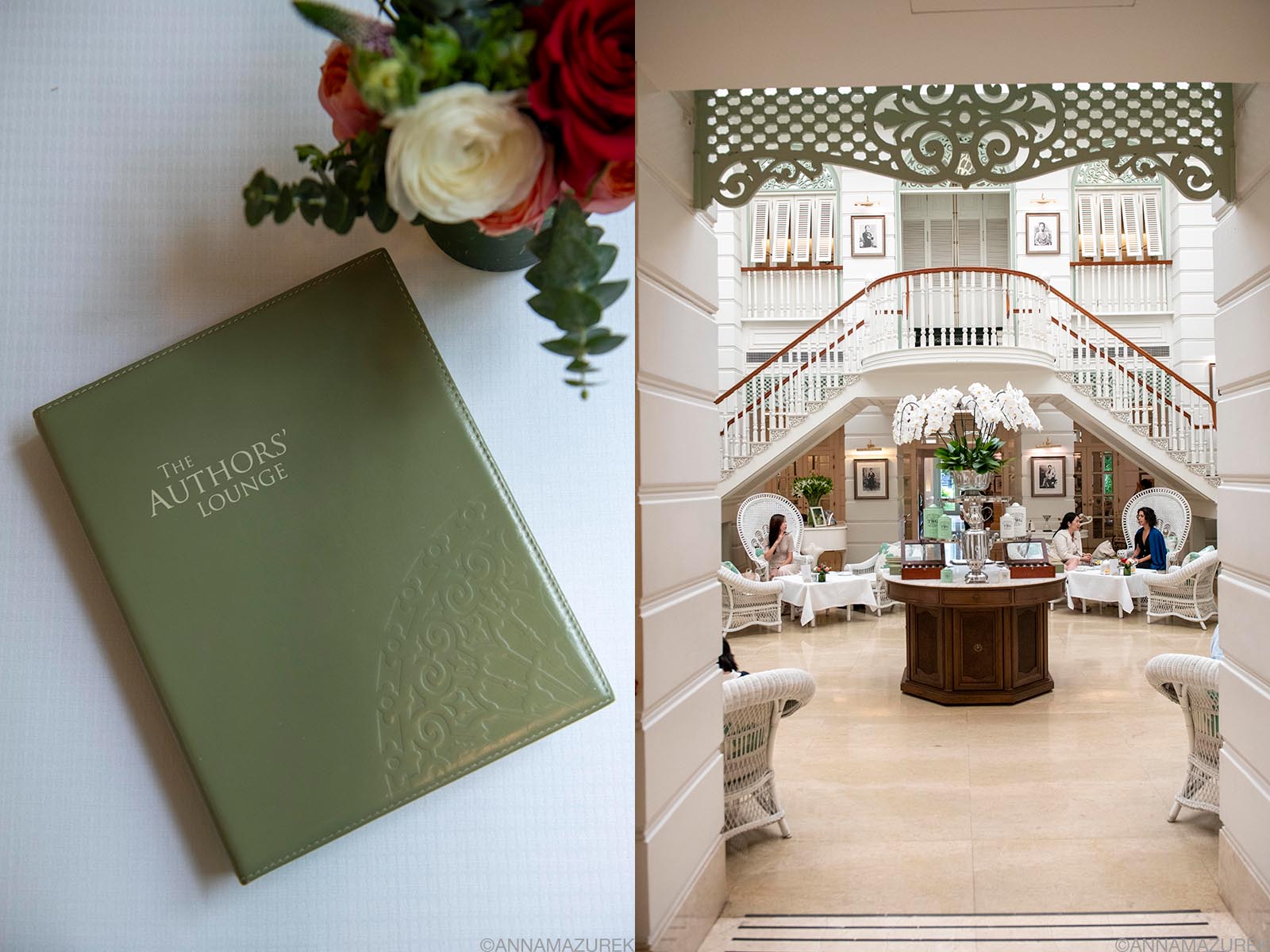 Looking to splurge? Treat yourself to the seasonal high tea at the Arthur’s Lounge at the Mandarin Oriental Hotel in Chinatown.
Looking to splurge? Treat yourself to the seasonal high tea at the Arthur’s Lounge at the Mandarin Oriental Hotel in Chinatown.
High Tea at the Arthur’s Lounge
Located on the banks of the Chao Phraya River, the historic Oriental Hotel was a haunt for famous writers such as Graham Greene and W. Somerset Maughan during the early 19th century. Now, the five-star hotel, the Mandarin Oriental Hotel, is part of the Mandarin Group and offers seasonal high teas daily in the light-filled atrium of the Arthur’s Lounge lined with wicker chairs. I thought it was a fun experience to get dressed up and treat myself. Cost was roughly $50 USD. Reservations recommended.
Craft Beer in Bangkok
While there are a bunch of glitzy pricey rooftop bars in Bangkok, I’m a big fan of the craft beer spot called Brewski, located on the top floor of the Radisson Blu Plaza Hotel near the Phrom Phong BTS stop. It’s a chill vibe with Thai and foreign beers on tap and tasty pub food. Don’t miss their BOGO deal for happy hour from 5 p.m. to 6 p.m. daily.
 Benjakitti Park’s four lakes can hold a million cubic liters of stormwater. The lakes and wetlands naturally filter polluted water and act as a sponge during monsoon season.
Benjakitti Park’s four lakes can hold a million cubic liters of stormwater. The lakes and wetlands naturally filter polluted water and act as a sponge during monsoon season.
The Best Parks in Bangkok
Lumpini Park is Bangkok’s oldest and largest green space covering 58 hectares. Rent a paddleboat for a loop around the artificial lake or go for a run along the trails between the well-manicured lawns. There’s usually always a Tai Chi class, too.
Another favorite is Benjakitti Park, a 102-acre park built on the site of a defunct tobacco factory with the former buildings now doubling as sports facilities. The natural space is mostly wetlands, frequented by birds, bats and monitor lizards, intersected by a series of elevated walkways. The park acts as a green lung for the city and works like a sponge during monsoon season rains. A flower-lined walking track circumnavigating a pond across the street from a series of skyscrapers is a great space for running or walking.
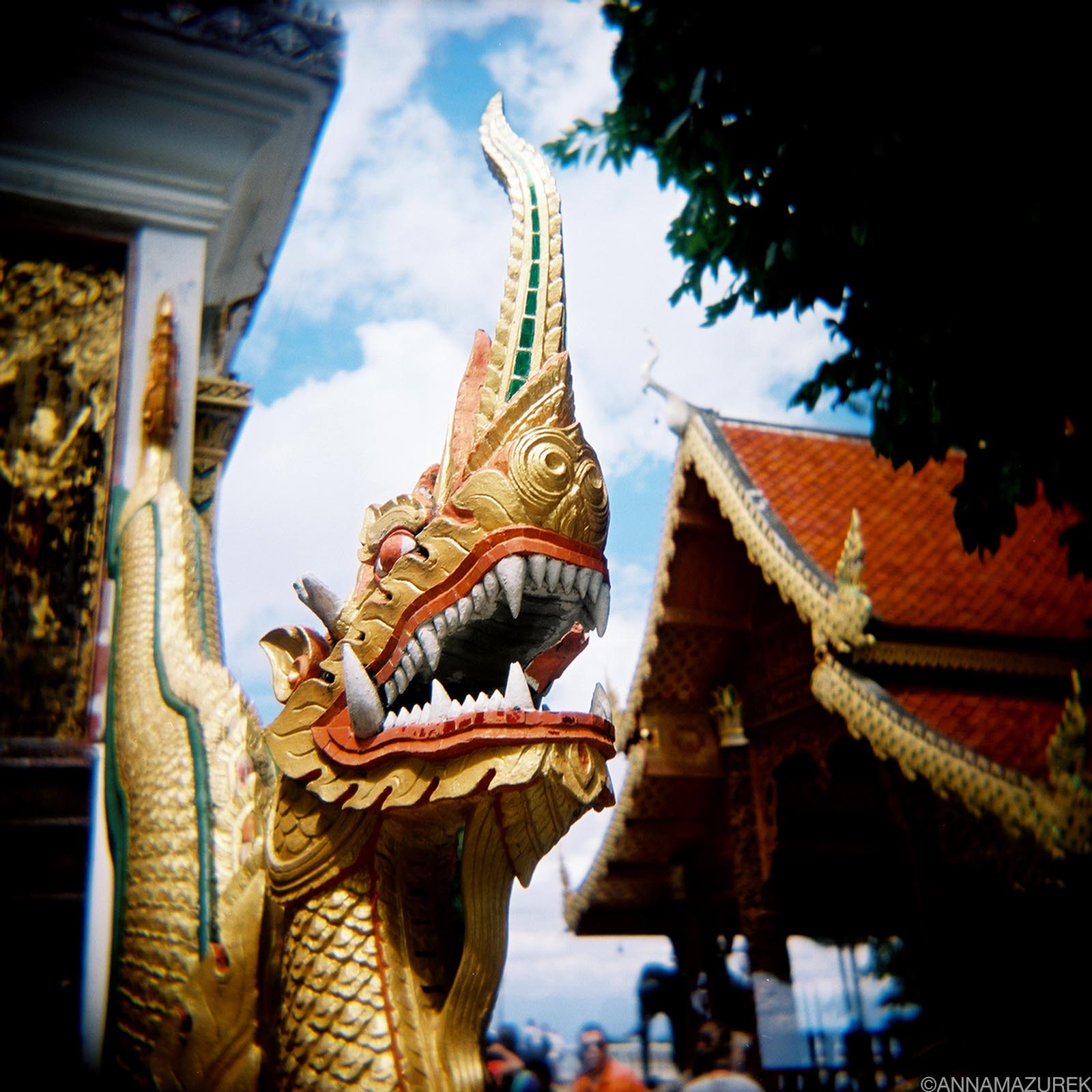 A naga, a mythical serpent, adorns the stairway of a temple inside The Grand Palace
A naga, a mythical serpent, adorns the stairway of a temple inside The Grand Palace
Bangkok FAQ
Where’s the best place to buy a SIM card in Bangkok?
Do NOT buy a SIM card at the airport because they are ten times the price of an eSIM or local SIM. The easiest thing to do is buy a Thailand-specific eSIM card from Airalo that will work instantly when you arrive. If you are traveling to multiple countries in Southeast Asia on a short trip, then consider one of their Asia Regional eSIM cards. (Both the country-specific and regional eSIMs have worked wonderfully for me and even have a mobile hotspot option that’s critical for me because I’m always working remotely.)
Keep in mind it’s always cheaper to buy a country-specific eSIM than a regional one. Be sure to join the free Airalo Loyalty Program to earn 5% cash back for every purchase, which can be redeemed on future purchases. For more about eSIM cards, check out this post!!
If you are staying for a month or more in Thailand, go by an AIS store and buy a local SIM or eSIM card for the cheapest deal. (AIS is Thailand’s largest mobile network operator.)
Do you need travel medical insurance for Thailand?
Yes, travel medical insurance is one of the most important things to purchase for any trip abroad, especially Thailand. It covers all the things that could go wrong from injuries to travel delays so that you don’t have to worry and can focus on traveling!
I use SafetyWing’s Nomad Insurance, which offers $0 deductible travel medical insurance coverage for over 180 countries for people aged 69 and under when traveling outside their home country. The best part is that it only costs a few dollars a day! If you get sick or injured abroad, you can visit any hospital or doctor.
Other benefits of Nomad Insurance include coverage for lost checked luggage, travel delays over 12 hours, motor accidents (if properly licensed, wearing all safety equipment and not intoxicated) and injuries from sports or leisure activities. You can even add adventure sports, electronics theft and U.S. coverage (for non-residents) to your policy.
If you’re abroad for 90 days, you can get 30 days of home-country coverage. (For the U.S. residents, it’s 15 days.) For more details about my experience using SafetyWing in Southeast Asia, read my SafetyWing Review.
Bangkok Transport Tips
Subway and Skytrain
The cheapest and fastest way into the city from either airport is to take a train. Don Mueang International Airport is connected to the city by a 17-minute train from Krungthep Apiwat Station.
From Suvarnabhumi Airport, take the Airport Link Train, which connects seamlessly to the BTS Skytrain. Some BTS stations are located near MRT stations. Elevators are at stations but not on all sides of the road. There’s always an escalator going up but sometimes, you might have to carry luggage down a set of stairs.
There are multi-trip passes available for both the BTS Skytrain and MRT subway individually. The MRT now lets you tap credit cards FINALLY but not the BTS.
Taxis are ALWAYS cheaper than auto rickshaws/tuk tuks. Taxi drivers rarely want to go by the meter anymore so expect to haggle. It usually takes me three taxis to get one to take me where I want to go at the meter rate. (Sundays are their day off so expect to pay exorbitant prices.) There are motorcycle taxis on most street corners that will take you nearby for a small fee. You’ll see the drivers wearing orange vests hanging around big intersections.
Grab, the rideshare app, does work in Bangkok, but I’ve really struggled to ever get one to pick me up in the Siam area without canceling because of traffic.
Where is the best English-speaking salon for a haircut in Bangkok?
I’ve been going to Shingo at Sensui Salon in the Sukhumvit area for over a decade. The owner, Shingo, is Japanese and speaks perfect English—he even lived in London for a while. I message him on the Facebook page to make my appointments.
Where is the best massage in Bangkok?
I love Nature Thai Massage on Soi 5 in the Siam area. There is a 20% discount for all appointments before 5 p.m. I usually do an oil massage that comes in a private room.

Things to do in Thailand
 Rice fields during the monsoon season in Bon Mai village in Northern Thailand
Rice fields during the monsoon season in Bon Mai village in Northern Thailand
The hardest part of any trip to Thailand is deciding where to go. The choices are endless – the white sandy beaches of the Andaman Coast, indulging in Chiang Mai’s culinary delights, visiting Bangkok’s gleaming Buddhist temples and biking through the 13th-century ruins of ancient Sukhothai, Thailand’s first capital. You’ll find it hard to leave.
I’ve spent the last decade living and working in Thailand off and on working for travel companies, teaching English and volunteering with an NGO. I now spend every winter living in Chiang Mai. I decided it was time to write up my favorite things to do in Thailand—I’ve been everyone on this list!
Thailand is a traveler’s dream—friendly people, delicious food and stunning scenery. Plus, it’s budget-friendly and very safe. Keep reading for the best things to do in Thailand and how to best prepare for your trip!
Affiliate links are used in this post. If you make a purchase, I earn a small commission at no cost to you, which goes toward the cost of maintaining this blog.
Plan Your Trip
Currency: Thai Baht (THB)
When to Go: November to February for cooler temperatures. October is very lush at the end of rainy season (my favorite month).
Travel Insurance: Protect yourself with SafetyWing travel medical insurance to cover accidents and travel delays.
Mobile eSIM Card: Get seamless connectivity worldwide with Airalo minus the hassle of physical SIM card. (Save 10% with code AIRALOESIM10!)
 A monk walks through the courtyard of Bangkok’s most stunning temple – Wat Suthat.
A monk walks through the courtyard of Bangkok’s most stunning temple – Wat Suthat.
Bangkok
Bangkok is a kaleidoscope of both Eastern and Western culture – sleek shopping malls just blocks away from traditional Buddhist temples. The capital city boasts a sleek metro train system that makes it easy to get around. Since Thailand is famous for its high-quality medical care, Bangkok is a big hub for medical tourism. I get my annual health checkups in Bangkok and wrote a post with a detailed breakdown of the cost.
The most famous sites are The Grand Palace, the former royal residence, and Wat Phra Kaew, home to the Emerald Buddha, the most revered image in Thailand that dates back to the 13th and 14th centuries. Tickets are 500 baht for foreigners. Consider booking online through Klook if you want to skip the lines. (There is a strict dress code. Cover your knees and wear long sleeves or you’ll be forced to rent clothes.)
Nearby, Wat Pho, known for the reclining Buddha, and the iconic Wat Arun across the river are also a must. (Both are 200 baht each.)
For more things to do in the Thai capital, read my detailed Bangkok Guide!
Where to Stay in Bangkok
Always choose accommodation near one of the train lines to make it easy to get around. I like to stay near the Siam area.
-
Bangkok Hostels: I stayed at Bed Block One Hostel ($16 USD/night) for years and loved how close it was to Siam (Ratchathewi BTS) and the airport train.
-
Bangkok Hotels: The Holiday Inn Express Siam ($88 USD/night) by the National Stadium BTS is my go-to because it’s a great location with clean rooms, free breakfast and a gym. If you want to splurge, I recommend VIE Hotel Bangkok ($188 USD/night).
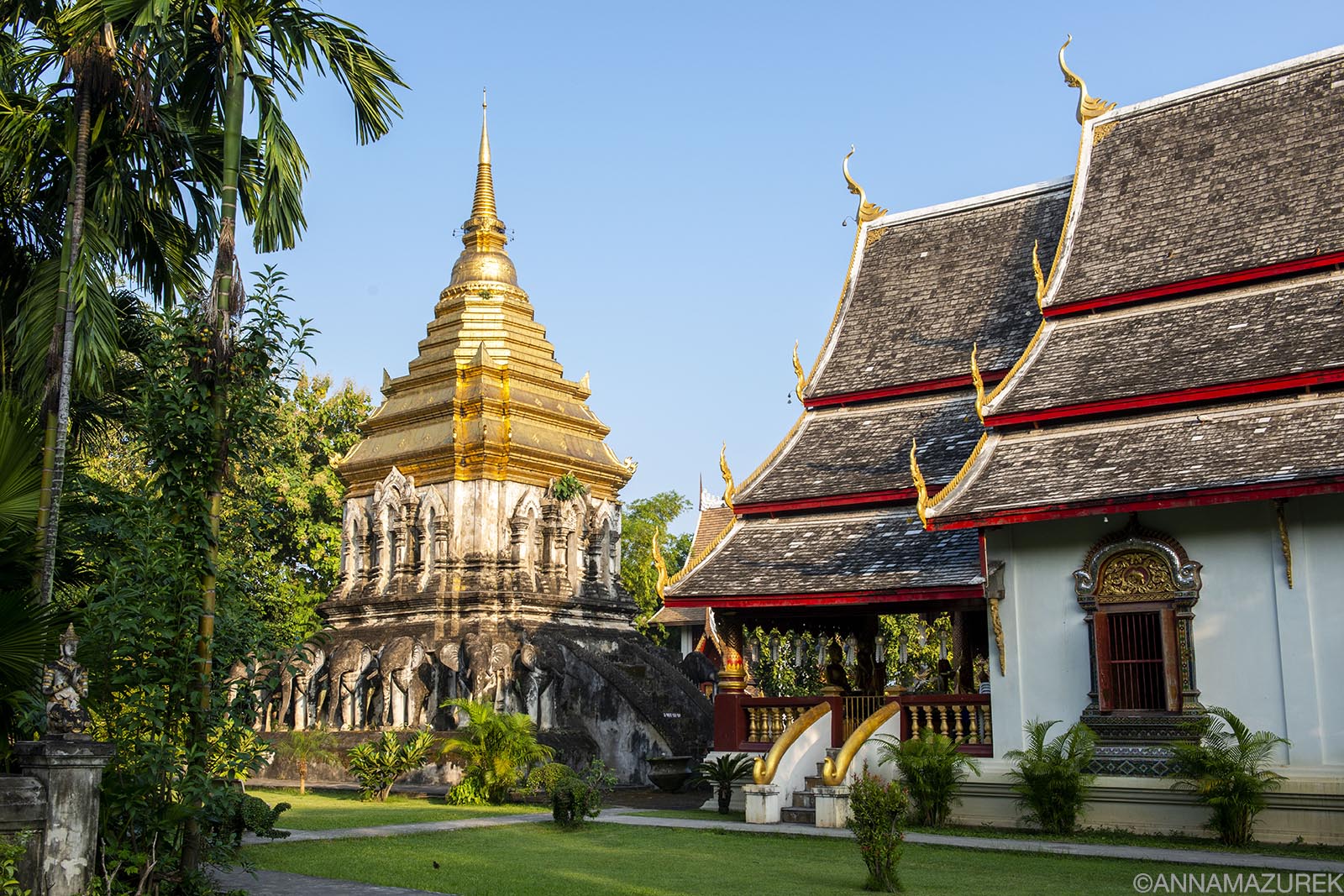 Wat Chiang Man is a hidden temple in Chiang Mai’s old city.
Wat Chiang Man is a hidden temple in Chiang Mai’s old city.
Chiang Mai
Chiang Mai is the laid-back culinary hub of Northern Thailand. Stroll through the old town, a 1.5 km square surrounded by original walls and moat to visit Wat Chedi Luang which dates back to 1441. Climb the 306 steps to the mountain-top temple of Wat Phra That Doi Suthep, which is a short trip outside of the city. Stop by the Chiang Mai Night Bazaar, the 1km long sprawling nightly market for a bowl or two of khao Soi, a delicious soup curry.
For more details, check out my Chiang Mai Guide.
The Best Places to Stay In Chiang Mai
HOTELS: In the popular Nimman area, try Hotel YaYee ($38 USD/night) and Akyra Manor ($138 USD/night), which have the best rooftop bars in town.
HOSTELS: In the Old City, consider The Common Hostel ($10 USD/night) or Pakping Hostel, which has private bunks with curtains. In Nimman, Ray Hostel and Bed Addict Hostel have the best locations and ratings. ($13-14 USD/night.)
Traveling in Southeast Asia
Read my guides to Chiang Mai, Bangkok, Vietnam and Singapore!
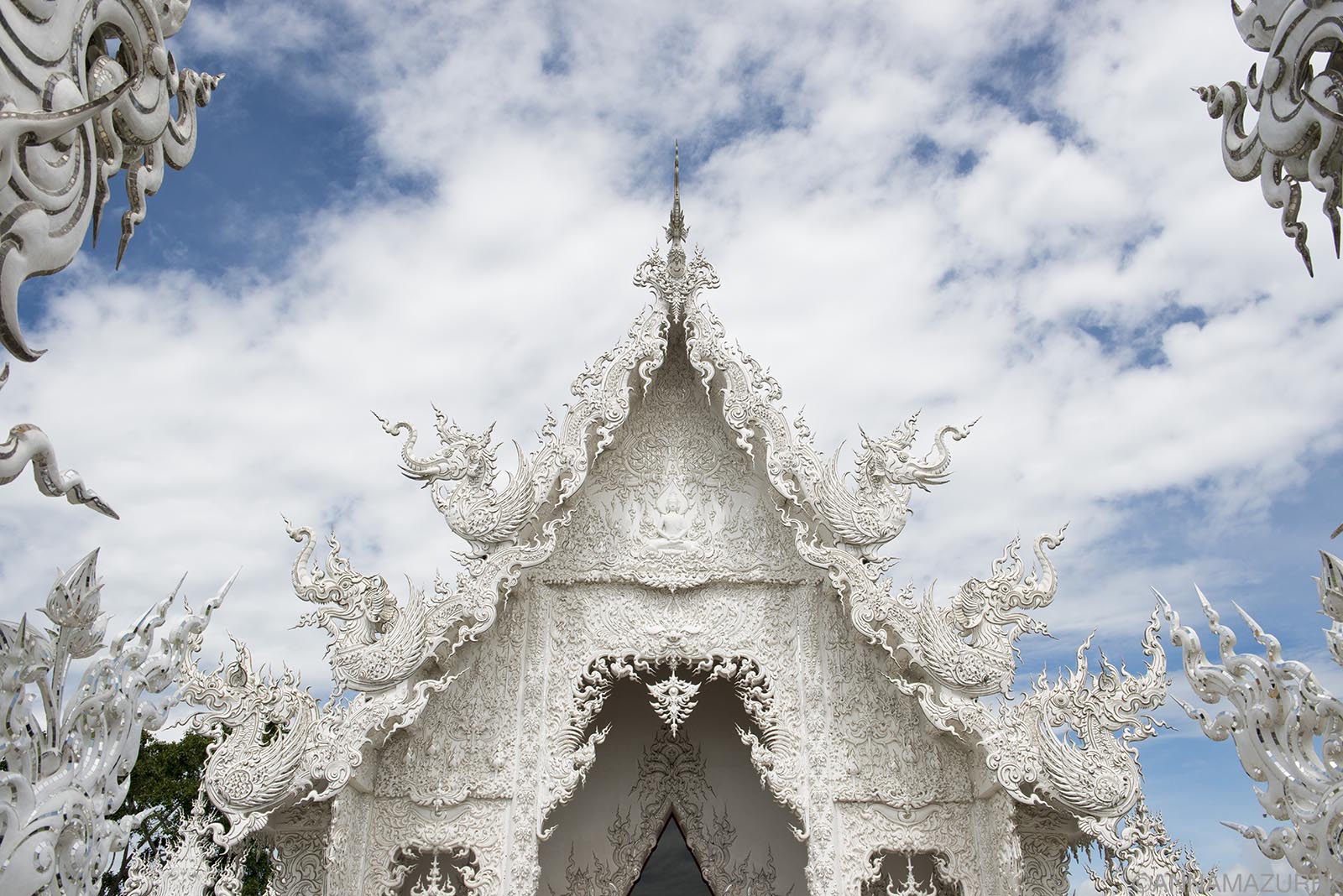 Chiang Rai’s temple-inspired art project, Wat Rong Khun, features images of Hello Kitty and Keanu Reeves in the interior.
Chiang Rai’s temple-inspired art project, Wat Rong Khun, features images of Hello Kitty and Keanu Reeves in the interior.
Chiang Rai
The small town of Chiang Rai is often overlooked but worth a visit if only to see the famous white temple, Wat Rong Khun. The temple is a contemporary art project by local artist Chalermchai Kositpipat that opened in 1997 and is still not yet completed! It’s open daily for visitors with a small entry fee (50 Baht/$1.39 USD).
Another local artist, Thawan Duchanee, is known for a 40-building complex known as the black temple (Baan Dam Museum) that features a dark and controversial interpretation of Buddhist philosophy. There’s also a blue temple, Wat Rong Seur Ten. The city has great food, budget accommodation, stunning temples and is a good base for nearby excursions. The nightly light show at the downtown clock is fun. There are a plethora of day-trip tours from Chaing Mai.
Pai
Everyone loves Pai, a mountain town with beach vibes. The bohemian outpost is surrounded by lush mountain scenery and is one of the most visited parts of Northern Thailand. The city center is filled with trekking agencies, boutiques and an endless array of restaurants. The walking street is hopping at night so stick to the edges of town if you want solitude. Highlights include Pai Canyon, the waterfalls of Pam Bok and Mae Yen, and Tha Pai Hot Spring.
The Best Places to Stay in Pai
For rice field views, consider the quieter Yoma Hotel ($58 USD/night) or Buzzas @ Pai Chan, a backpacker’s spot that’s $26 USD/night. Pai Village Boutique Resort ($160 USD/night) is right on the walking street and super fancy.
 A reflection of Wat Mahathat in Sukhothai, Thailand’s first ancient capital.
A reflection of Wat Mahathat in Sukhothai, Thailand’s first ancient capital.
Sukhothai & Ayutthaya
If you love ancient Buddhist ruins as much as I do, then don’t miss these two UNESCO World Heritage sites. Sukhothai was the first capital of Siam in 13th and 14th centuries, and Ayutthaya was the second. Both are easily accessible by bus.
Sukhothai is over halfway between Chiang Mai and Bangkok. Simply rent a bicycle by the park entrance and explore on your own. (It’s totally flat so easy biking!) Vendors aren’t allowed in the walled portion of the ruins making for peaceful exploration. For details on how to get to the park, check out this post. (On my last visit, I stayed at TR Guesthouse ($14 USD/night for a private room) and really liked it.)
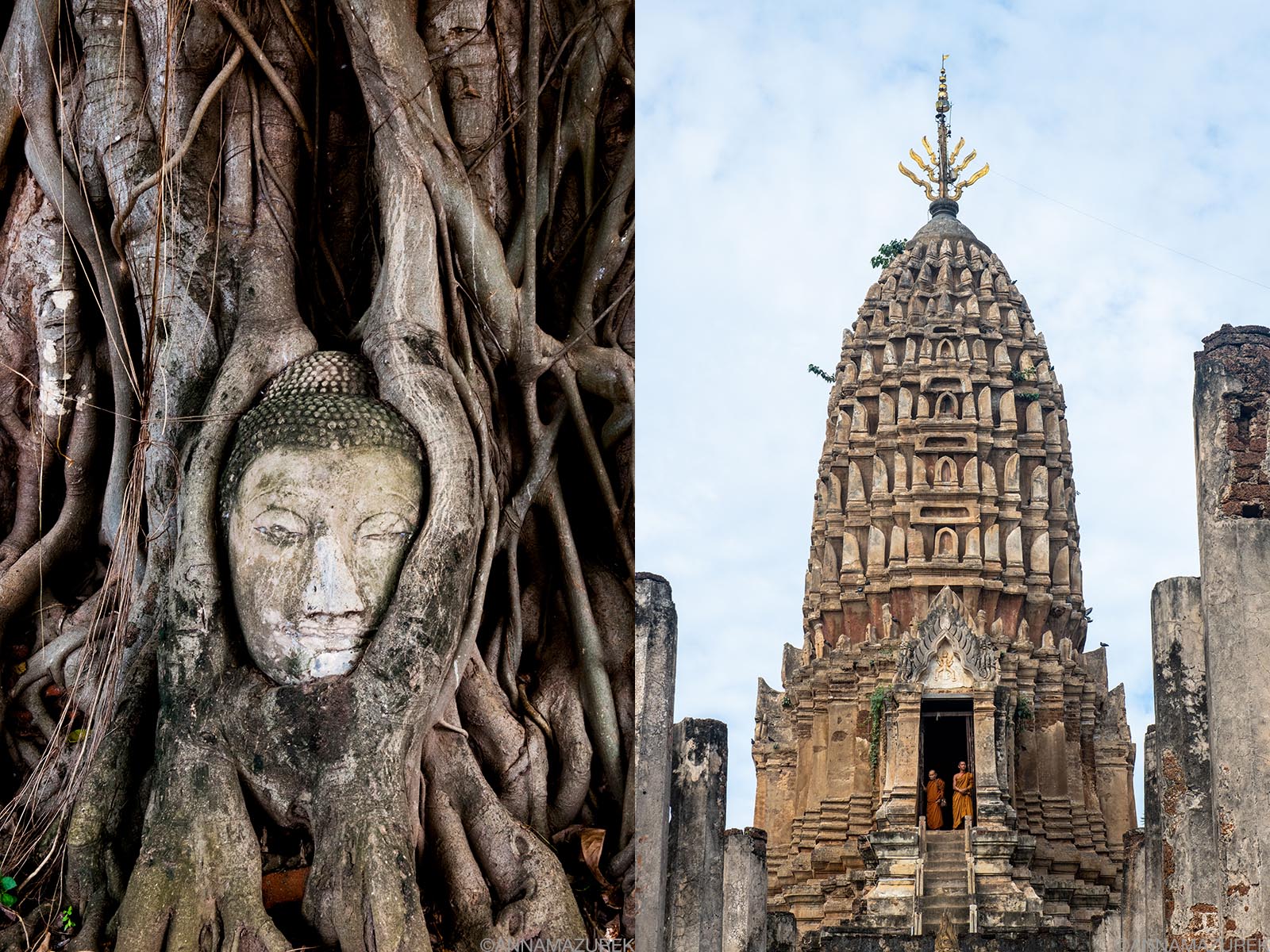 Ayutthaya’s ruins are famous for a Buddha head entangled in tree roots at Wat Mahathat. Right: Wat Phra Sri Rattana Mahathat Rajaworaviharn at Si Satchanalai
Ayutthaya’s ruins are famous for a Buddha head entangled in tree roots at Wat Mahathat. Right: Wat Phra Sri Rattana Mahathat Rajaworaviharn at Si Satchanalai
To get off the beaten path, stay an extra day to visit the nearby Si Satchanalai, one of Thailand’s hidden secrets! It’s 60-kilometer away and part of the same UNESCO designation. (Si Satchanalai was the spiritual capital while Sukhothai was the political head of the first kingdom of Thailand.) Check out my Instagram story highlight about how to visit to Si Satchanalai!
Check out my Instagram highlight about how to visit to Si Satchanalai!
Ayutthaya is 80 miles north of Bangkok and easy to visit on a day tour. Unlike Sukhothai, the sites at Ayutthaya are spread out and has lots of annoying vendors. Doing a tour will make it easy to travel between sights. While both UNESCO sites are worth visiting, I personally prefer Sukhothai because it’s not as crowded, and there are far fewer annoying vendors.
Where to go in Southern Thailand
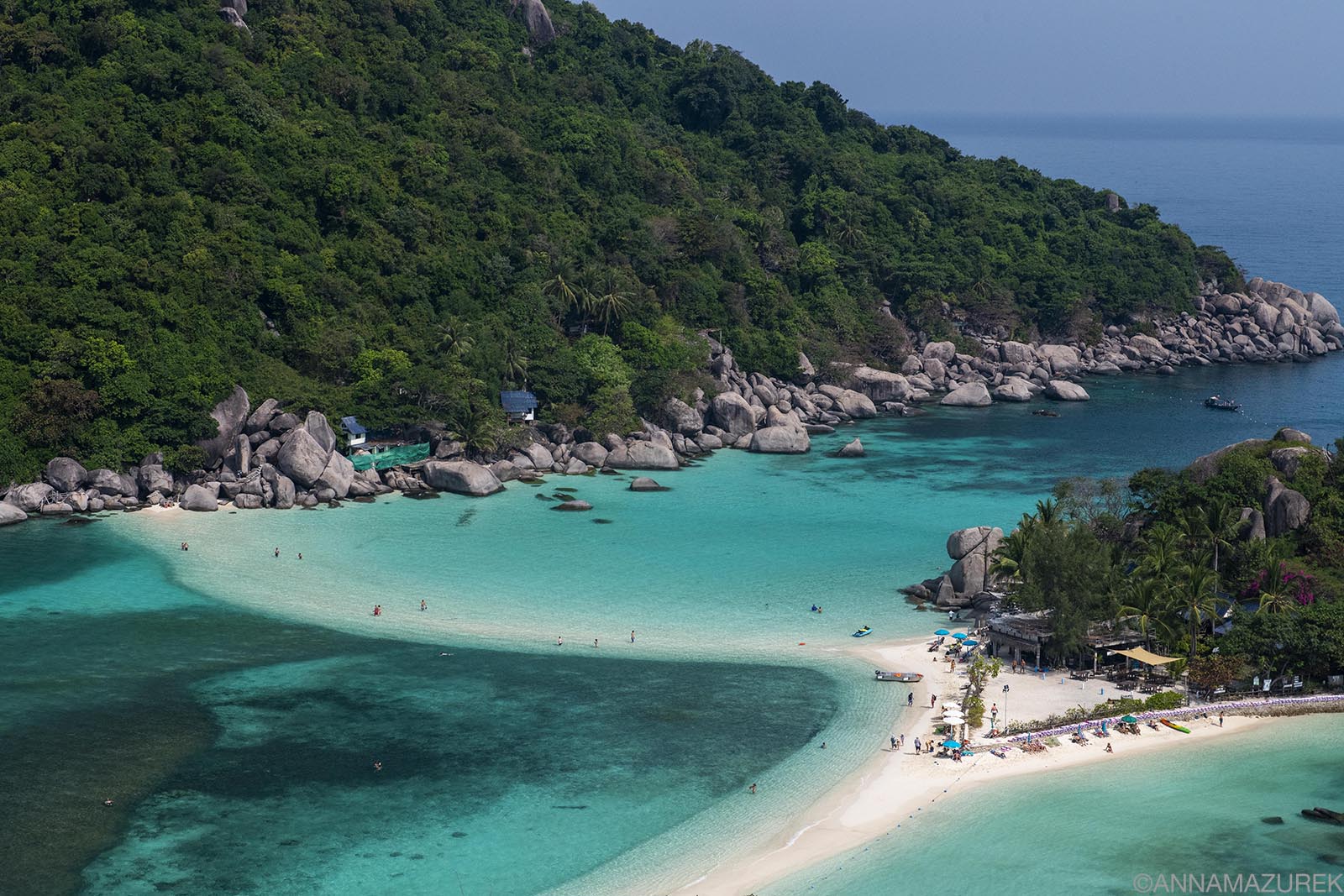 A 20-minute boat ride from Ko Tao takes you to the Koh Nang Yuan Viewpoint.
A 20-minute boat ride from Ko Tao takes you to the Koh Nang Yuan Viewpoint.
The trickiest part of visiting Thailand’s beaches is deciding between the Andaman Coast or the Gulf Islands. The gulf islands of Ko Tao, Ko Samui and Ko Pha-Ngan are close together, while the islands on the Andaman coast are scattered. Both have white sandy beaches and clear water, but the Andaman Coast is known for towering limestone cliffs. (The water is clearer on the gulf side but there’s sea life on the west coast.)
To be brutally honest, I’m not the biggest fan of the Thai islands—I’ve been to them all—because they are all built-up tourist attractions that don’t feel like Thailand. Avoid the rainy season because beaches will be filled with trash and debris, including plastic. This is an issue on most beaches in Southeast Asia.
Thailand’s Gulf Coast Islands
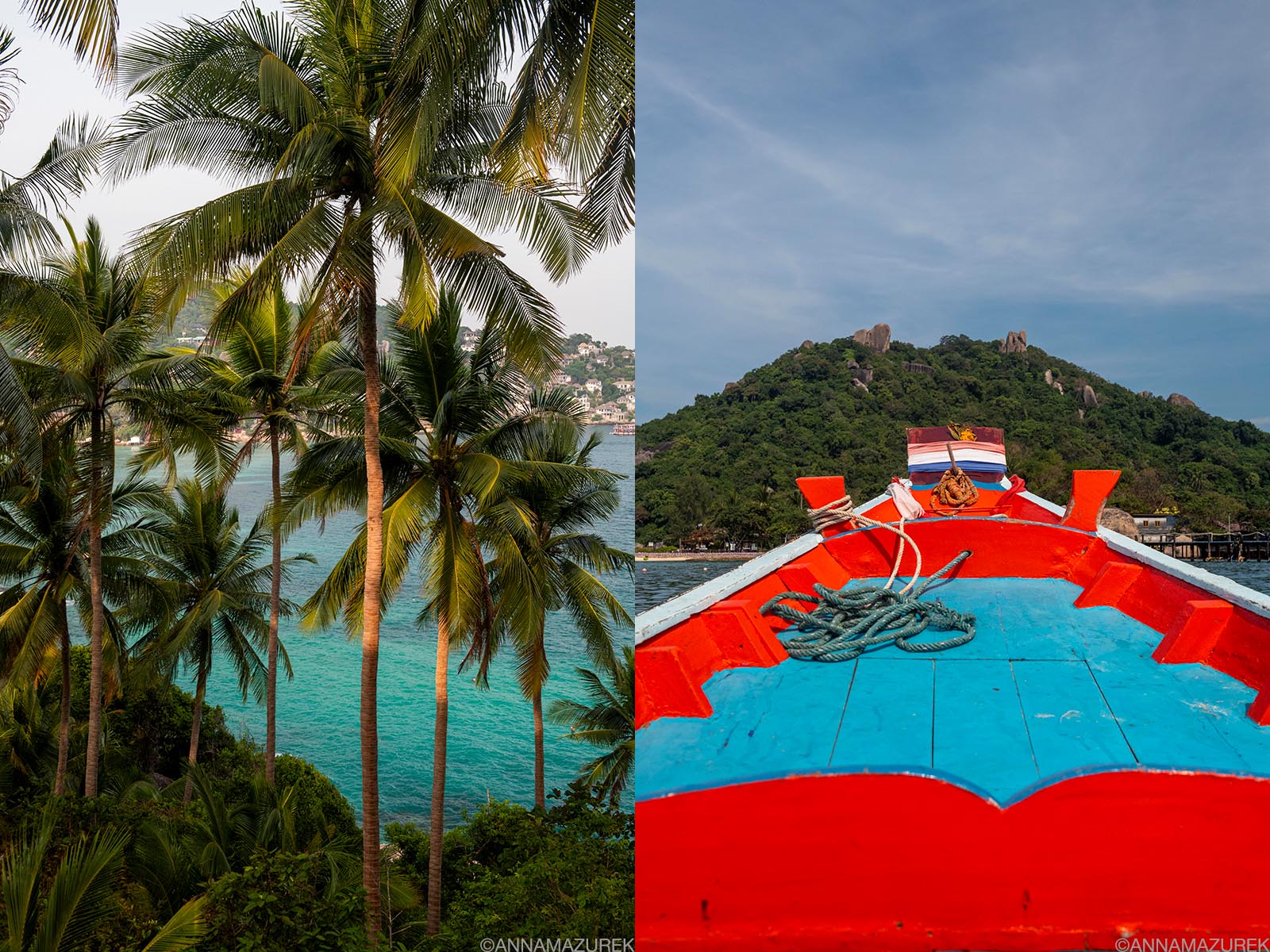 Left: The trail on the way to the John-Suwan Viewpoint; Right: Boat ride to Koh Nang Yuan.
Left: The trail on the way to the John-Suwan Viewpoint; Right: Boat ride to Koh Nang Yuan.
- Ko Tao is a diving mecca of Thailand and second in the world for the annual number of dive certifications. It’s also one of the cheapest places to be PADI certified. If you want to dive, there’s no better place in Thailand. (I stayed at Sairee Cottage Resort on my last visit and would recommend it.)
- Ko Samui is a swanky resort island of the trio and probably the nicest island in Thailand with the cleanest beaches due to the amount of high-end resorts. All taxis are fixed rate, so it’s expensive to get around. Songthaews, pickup trucks with covered rows of seats, are the cheapest options. If you’re flying in and going straight to the ferry to one of the other islands, book a group airport transfer with your ferry ticket.
- Ko Pha-Ngan is the infamous party island known for the Full Moon Parties, a never-ending beach rave filled with electronic music and backpackers covered in neon paint. The party rages on both before and after the full moon. To escape the party scene, head to the laid-back and less visited northern parts of the island.
-
Ko Samet’s ferry dock is only three-hour bus ride from Bangkok’s eastern bus terminal. Despite being the closest island to Bangkok, it’s still an underdeveloped destination with a thick jungle interior. I spent my birthday here one year and really enjoyed it. The southern portion of the island is more secluded and parts of the island only accessible by motorcycle or ATV, which are easy to rent. There are no white sandy beaches here, but the water is still clear.
How to get to Ko Samui, Ko Tao and Ko Pha-Ngan
You can fly to Ko Samui from Bangkok easily from Bangkok or internationally. (The airport is privately owned by Bangkok Airways and is one of the coolest airports I’ve ever visited.) Then, it’s easy to take a ferry to the other islands.
The cheapest way to get there is a bus/ferry combination from Bangkok’s southern bus terminal. You can also take the train/bus/ferry combination from Bangkok, but the bus/ferry option is much easier from my experience.
Thailand’s West Coast Islands on the Andaman Sea
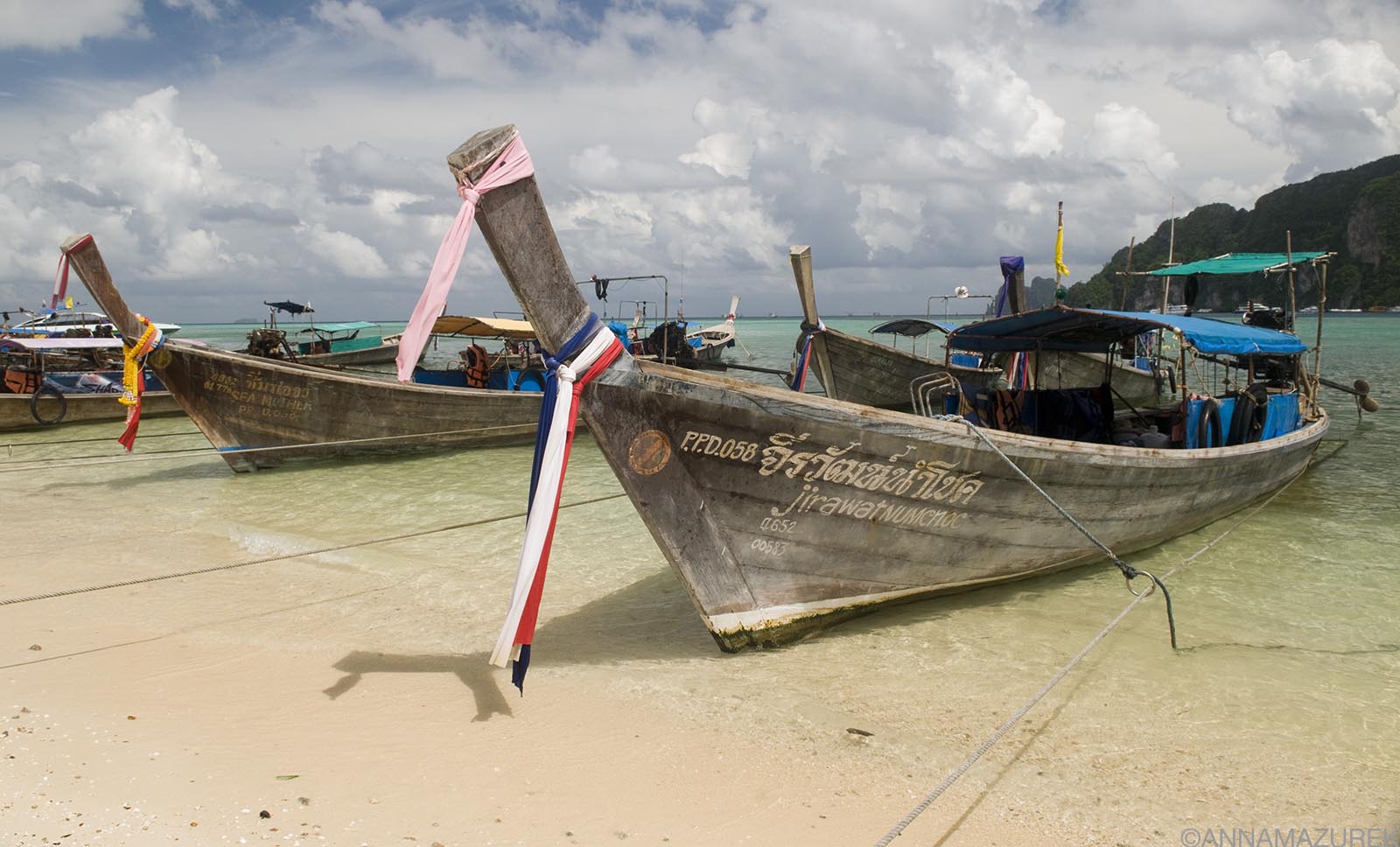 Long-tail boats docked on the sandy shores of Ko Phi-Phi Don in Southern Thailand’s Andaman Sea.
Long-tail boats docked on the sandy shores of Ko Phi-Phi Don in Southern Thailand’s Andaman Sea.
-
Krabi Town is a key transport hub nestled between towering limestone karsts. Ao Naug and Railay are the nicest beaches nearby. While the town of Ao Naug isn’t the nicest, it’s a great place to grab a boat over to Railay, a tiny picturesque white sandy beach village accessible only by sea.
-
Phuket is the celebrity of Thai islands and the largest island in the country. It’s a sprawling 30 miles long, which means you must decide exactly what part of the island to book accommodation. Transport between the main town and other beaches is pricey. It’s a big luxury destination filled with swanky resorts. I recently stayed at the J.W. Marriott for work, which was nice but more geared to families. Phuket just doesn’t feel like Thailand, so I’m not a fan. It is worth a stroll through Phuket town to see the historic architecture. Phuket, like Krabi, is a good transport hub to other islands.
-
Khao Lak is a small town with a nice beach an hour north of Phuket. Over the past few years, I spent several weeks there volunteering with an NGO, the Foundation for Education and Development. It’s a great location for day trips to the Similan and Surin Islands, Khao Sok and Khao Lak/Lam Ru National Parks. Klook offers day trips to most surrounding islands with free pickup.
-
The Similan Islands Marine National Park is home to the most beautiful beaches in Southeast Asia and one of the prime diving and snorkeling spots. (Ko Bon and Ko Tachai are the best snorkeling and diving areas since they are unaffected by coral bleaching.) Overnight stays were banned in 2018. (Divers can stay on a live-aboard.) The islands are closed annually from May 15 – October 15th each year for environmental reasons. Consider a diving trip or a day snorkeling trip from Phuket and Khao Lak. (I booked day trips to the Similan Islands through Klook, which offer pickups in Phuket, Khao Lak and Krabi.)
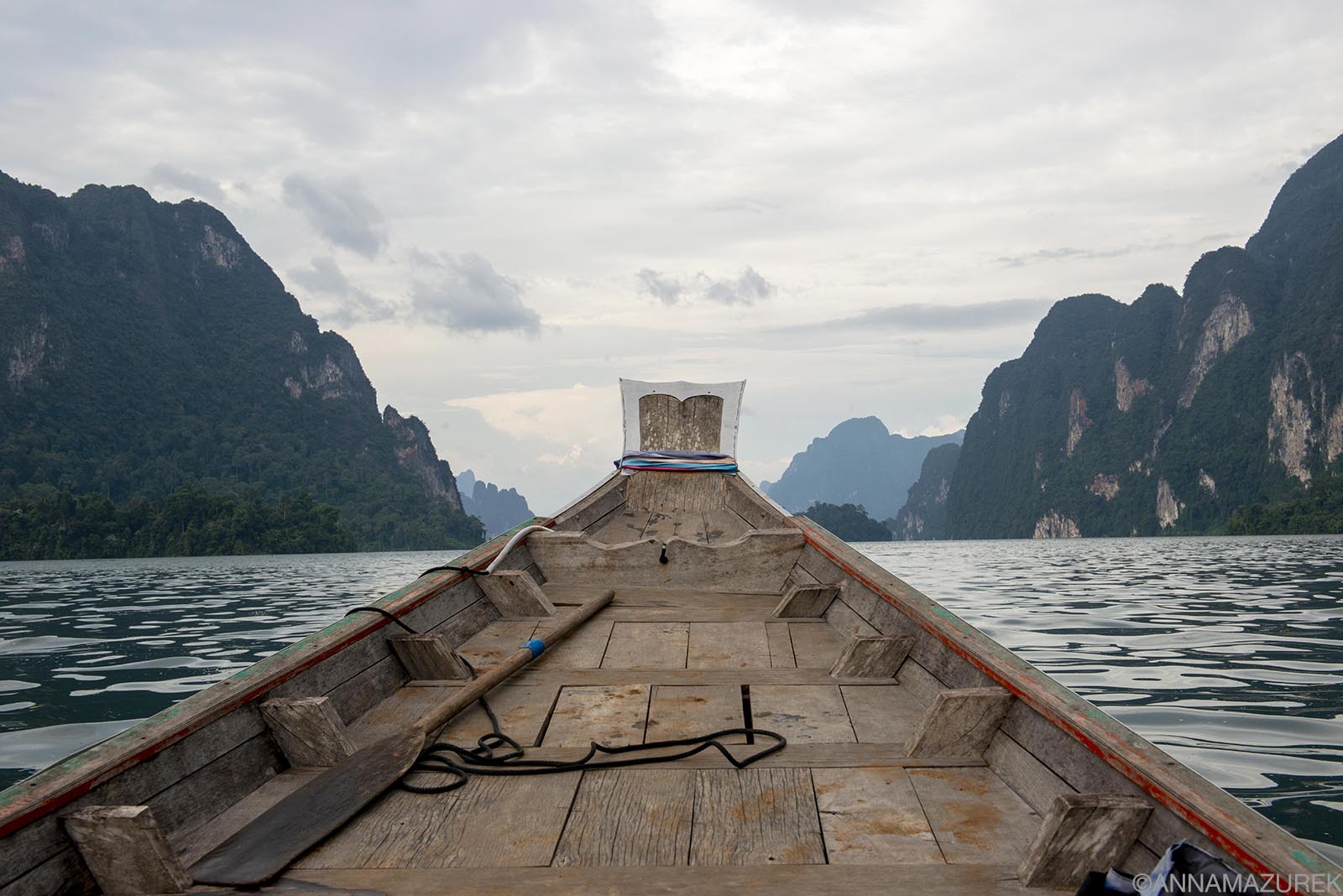 Khao Sok National Park is an easy day from Khao Lak but worth staying for a night or two!
Khao Sok National Park is an easy day from Khao Lak but worth staying for a night or two!
-
Khao Sok National Park is one of Thailand’s hidden gems. The park centers around an inland, man-made lake, Chiaw Lan Lake, with some Ha Long Bay-esque scenery of towering limestone formations surrounded by some of the world’s oldest evergreen rainforest dating back 160 million years.
Go for a jungle trek to see one of the 300 species of birds, a cave tour or a dip in the calm lake waters. Take a day trip from Surat Thani or Khao Lak or stay the night in a fancy lodge or one of the floating raft houses. If you only have time for day trip, consider booking through Klook, which I use for day trips and skip-the-line entry tickets for big attractions.
-
Ko Phi-Phi Don is a backpacker island accessible by ferry from Phuket or Krabi. I was disappointed by the trash on the beaches but loved the nightly fire shows. Its nearby sister island, the uninhabited Ko Phi-Phi Leh, is a gorgeous national park island. You’ll probably recognize the soaring limestone cliffs jutting out of crystal-clear waters from the movie The Beach that was filmed there. It’s a popular day trip with great snorkeling opportunities. Klook offers great day-trip rates from Ko Phi-Phi Don, Krabi and Phuket.
How to get to Phuket and Krabi on Thailand’s West Coast
Phuket is the largest airport with international flights, and Krabi is usually the cheaper option from Bangkok. Phuket is also easily accessible via overnight bus from Bangkok. There is an endless number of ferries between all the islands. Just plan to arrive early to catch a same-day ferry.
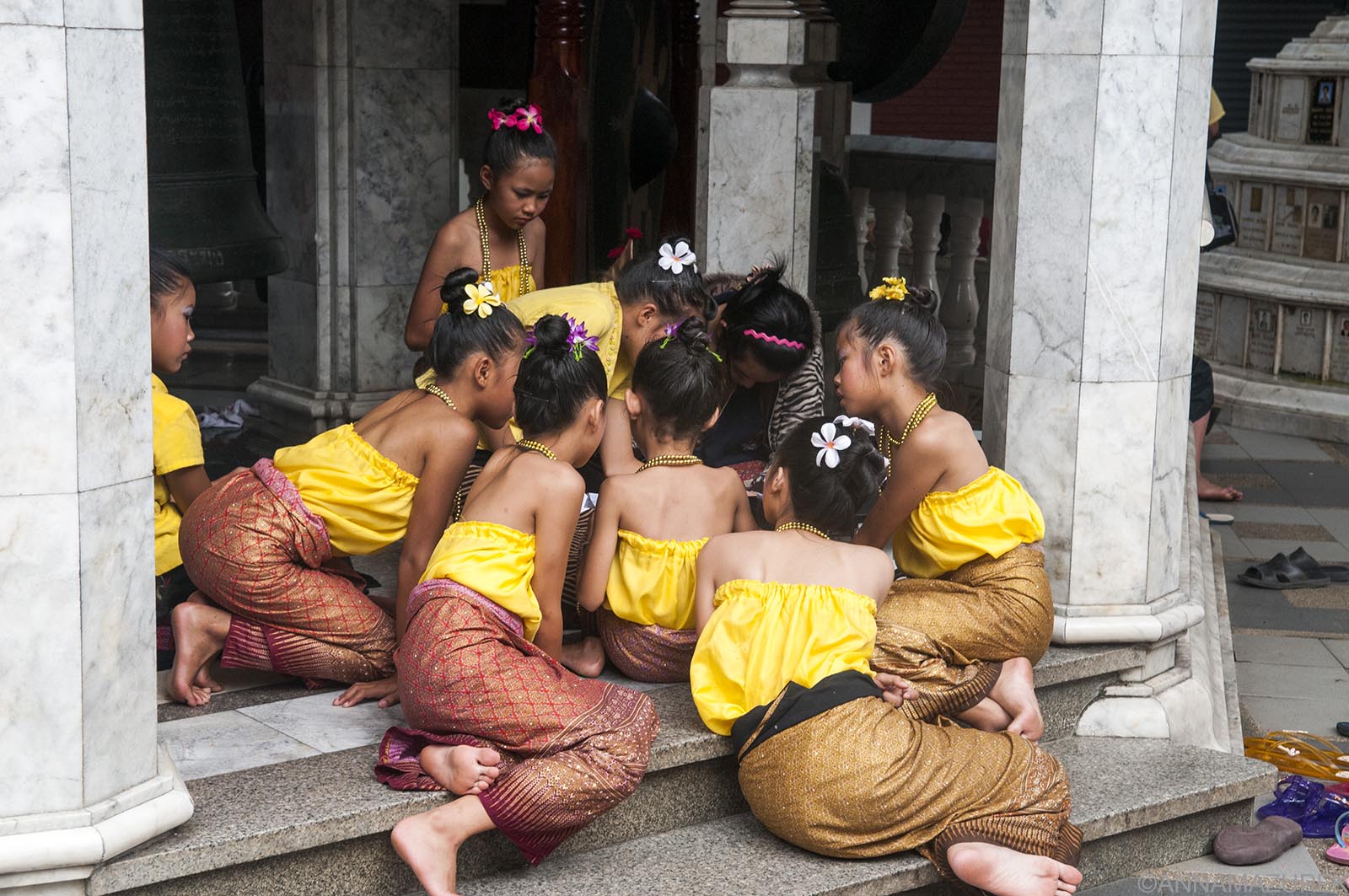 Wat Phra That Doi Suthep, Chiang Mai
Wat Phra That Doi Suthep, Chiang Mai
Thailand FAQ
The Best Time to go to Thailand
It will be hot year-round in Thailand, even in the “cool” season. The rainy season lasts from May to October, but it usually only rains a little each day. The occasional deluge can occur so keep an umbrella handy. (I honestly prefer the rainy season because it’s much greener and lusher.) Avoid the burning season near Chiang Mai in February/March, when the air quality is the worst in the world.
March to May is steaming hot across the country, so avoid this time of year if possible. November through February is peak travel season when temperate drop (low 80’s Fahrenheit in the north), and prices increase dramatically. The water festival (Songkran) in mid-April is another peak travel time so book ahead for accommodation.
Do you need travel medical insurance for Thailand?
Yes, travel medical insurance is one of the most important things to purchase for any trip abroad, especially Thailand. It covers all the things that could go wrong from injuries to travel delays so that you don’t have to worry and can focus on traveling!
I use SafetyWing’s Nomad Insurance, which offers $0 deductible travel medical insurance coverage for over 180 countries for people aged 69 and under when traveling outside their home country. The best part is that it only costs a few dollars a day! If you get sick or injured abroad, you can visit any hospital or doctor.
Other benefits of Nomad Insurance include coverage for lost checked luggage, travel delays over 12 hours, motor accidents (if properly licensed, wearing all safety equipment and not intoxicated) and injuries from sports or leisure activities. You can even add adventure sports, electronics theft and U.S. coverage (for non-residents) to your policy.
If you’re abroad for 90 days, you can get 30 days of home-country coverage. (For the U.S. residents, it’s 15 days.) For more details about my experience using SafetyWing in Southeast Asia, read my SafetyWing Review.
The best place to buy a SIM card in Thailand
The easiest thing to do is buy a Thailand-specific eSIM card from Airalo that will work instantly when you arrive. If you are traveling to multiple countries in Southeast Asia on a short trip, then consider one of their Asia Regional eSIM cards. (Both the country-specific and regional eSIMs have worked wonderfully for me and even have a mobile hotspot option that’s critical for me because I’m always working remotely.) Keep in mind it’s always cheaper to buy a country-specific eSIM than a regional one.
Be sure to join the free Airalo Loyalty Program to earn 5% cash back for every purchase, which can be redeemed on future purchases. For more about eSIM cards, check out this post on the pros and cons of eSIM cards!
If you are staying for a month or more in Thailand, go by an AIS store and buy a local SIM or eSIM card for the cheapest deal. (AIS is Thailand’s largest mobile network operator.)
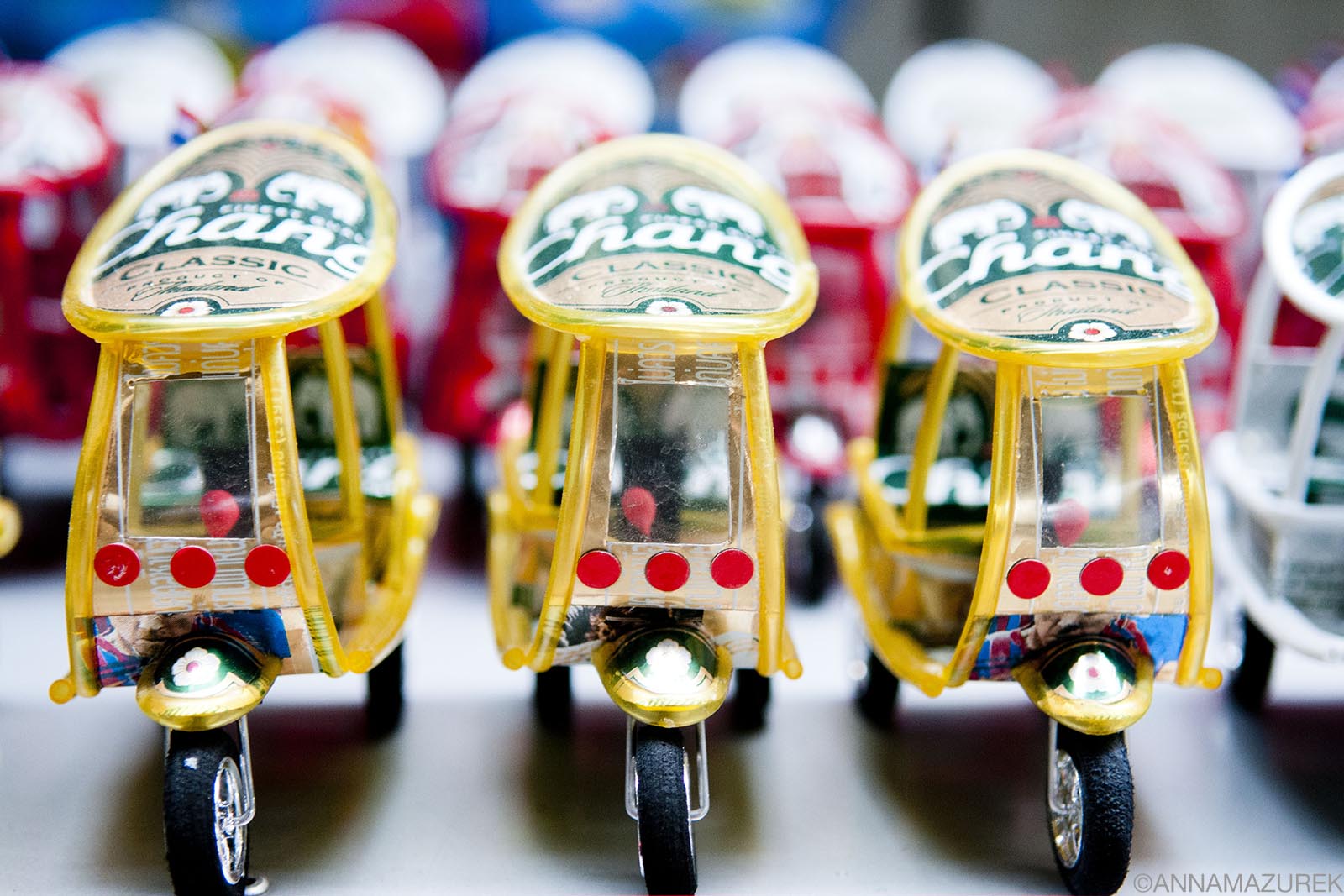 Tuk tuks made from beer cans at a market in Bangkok.
Tuk tuks made from beer cans at a market in Bangkok.
Thailand Transport Tips & Logistics
Trains
The trains in Thailand are good but usually late by at least 30 minutes to a couple of hours. Sleeper trains are quite comfy and one of my favorite forms of travel. (Always get the bottom bunk – it’s bigger. Plus, the air conditioner makes the top bunk FREEZING.) Book directly at the train station. Bottom bunks sell out so try to buy a day or two in advance.
Bus
Buses are more efficient. Always take the second-class buses instead of the VIP tourist buses. It’s half the price and nicer. (The VIP buses are always blaring music all night and can be targets for people to get robbed since it’s all foreigners. I’ve heard rumors of bus staff going through bags when coming from the beaches.) The second-class buses are usually only locals, so they are safer in my opinion. They have air conditioning and bathrooms, too.
Tuk Tuks
Tuk tuks (auto rickshaw) prices are outrageous in Bangkok. Always get a taxi in Bangkok – it’s significantly cheaper to pay by taxi meter than the horrible flat rate tuk tuk prices. They can be cheaper in other parts of the country. Always negotiate a price beforehand.
Grab
Grab is the Uber of Southeast Asia and originally partially owned by Uber. There are other apps as well like Maxim that are slightly cheaper but a bit more glitchy.
Banking
Exchange rates are always better in towns than at the airport. All ATMs in Thailand are now charging ATM fees for withdrawals. To avoid these fees, be sure to open a fee-free travel bank account before your trip, which will save you a significant amount of money. For more details, check out my post on Travel Banking 101.
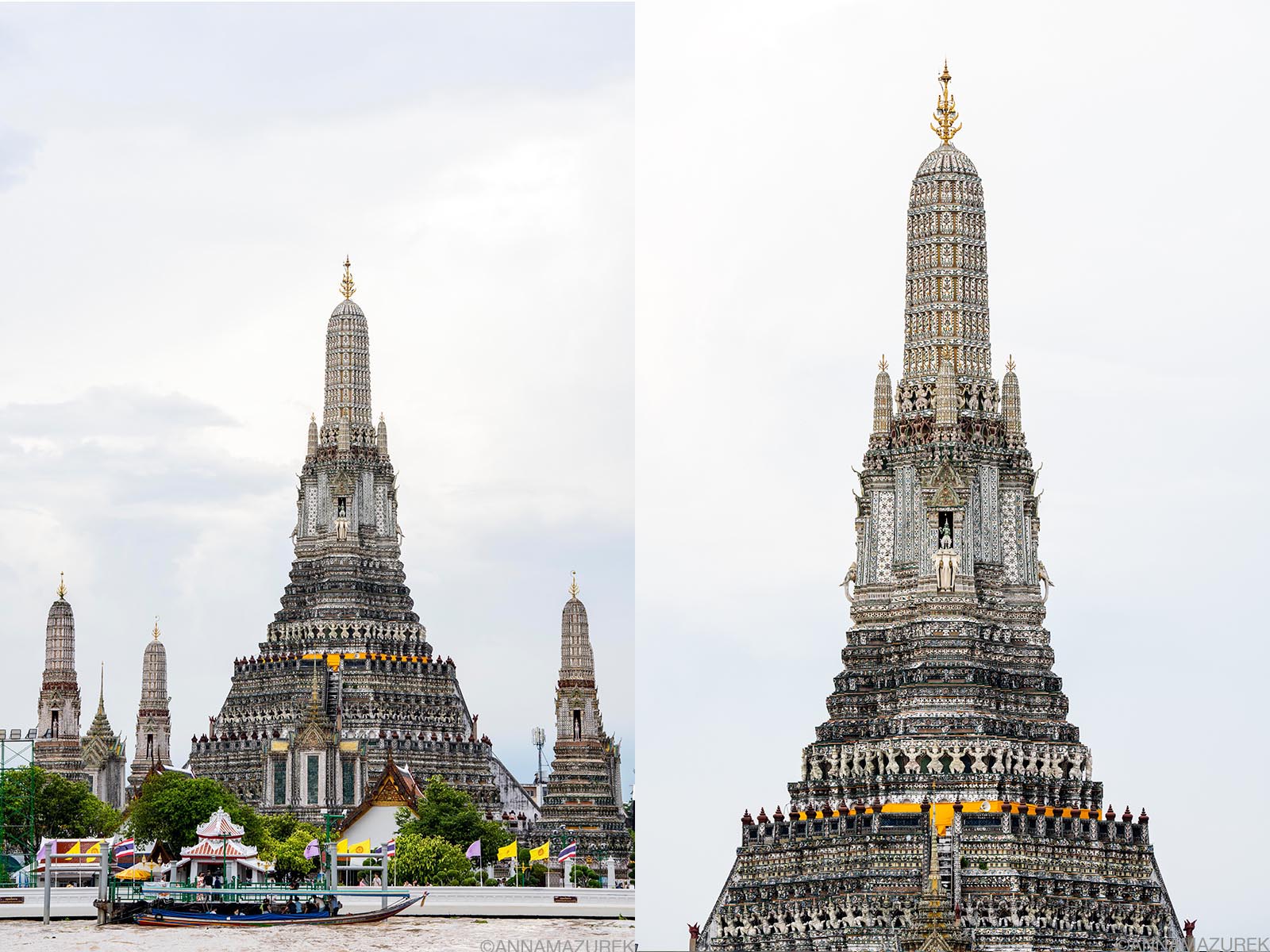 Bangkok’s Wat Arun is best photographed from across the river.
Bangkok’s Wat Arun is best photographed from across the river.
How to Dress in Thailand
Thailand is very conservative so be sure to cover your knees and shoulders in temples! Many temples in Bangkok even require long pants and long sleeves, and they will require you to rent clothing if you are not dressed appropriately. Be respectful at all times. Normal shorts are okay in Bangkok and Chiang Mai. Anything goes along the beaches in Southern Thailand.
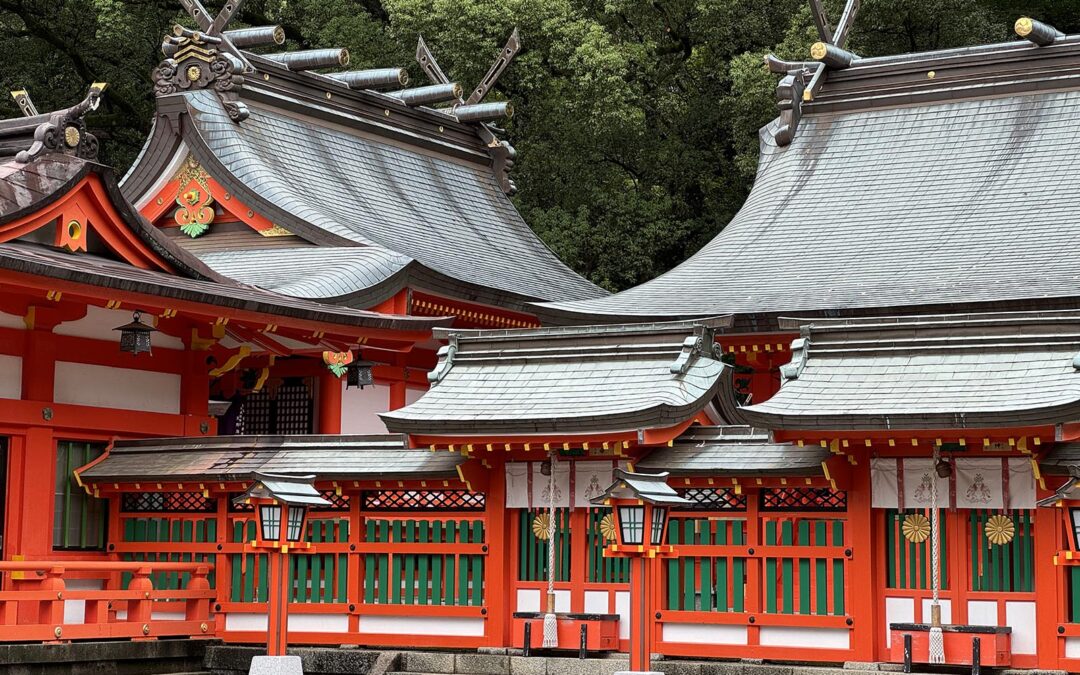
How to Snag the Best Hotel Deals with Mobile Discounts
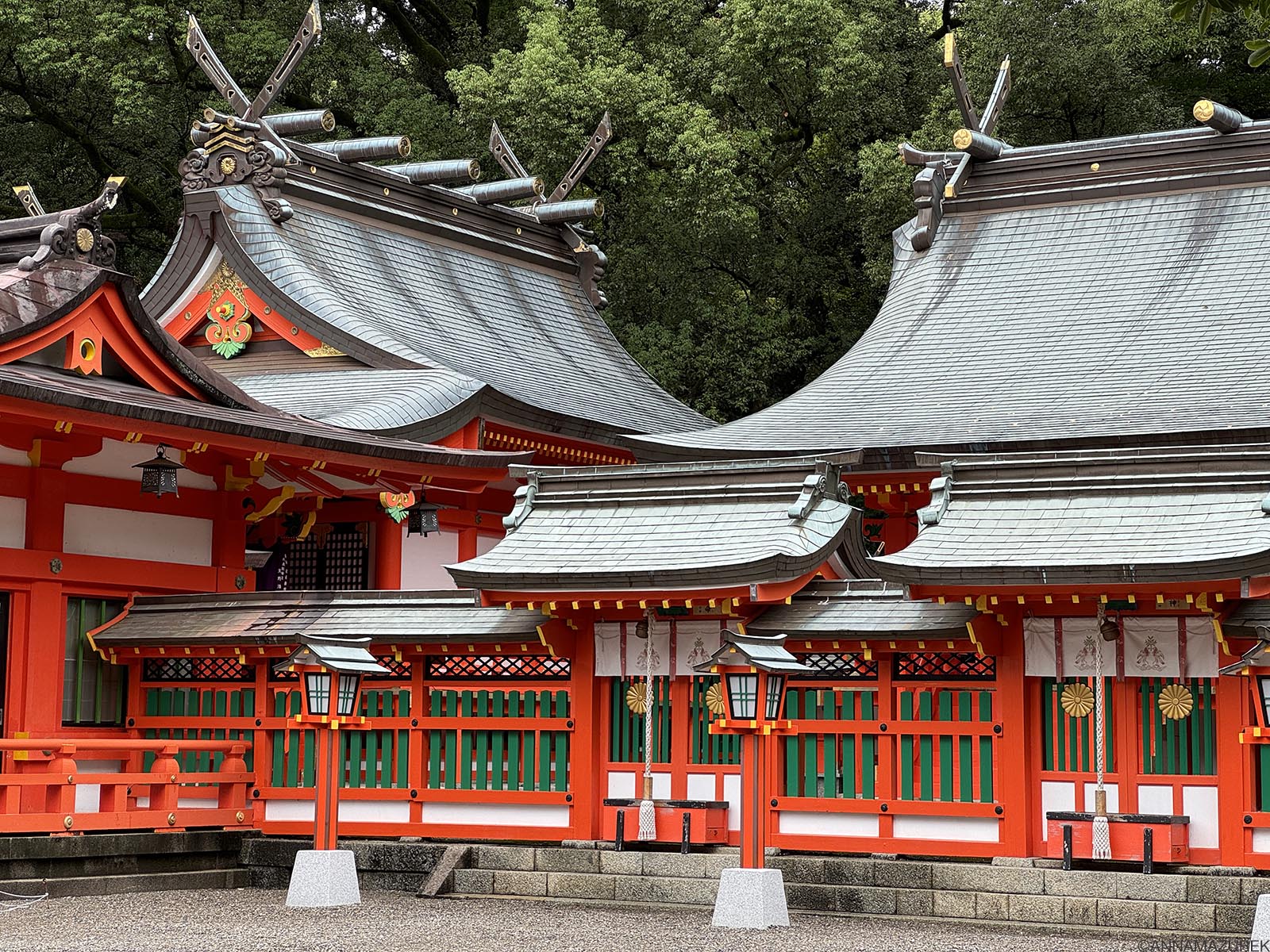 The Kumano Hayatama Taisha in Shingu, Japan is one of the three grand shrines I visited on my Kumano Kodo trek.
The Kumano Hayatama Taisha in Shingu, Japan is one of the three grand shrines I visited on my Kumano Kodo trek.
Accommodation and flights are often one of the biggest travel expenses. On my recent six-week trip to Japan (a combination of work and personal travel), I learned some new money-saving tricks that I wanted to share about how to find the best hotel deals.
(AFFILIATE DISCLOSURE: Please note that some affiliate links are used in this post. If you make a purchase, I earn a small commission at no cost to you, which goes toward blog maintenance costs. I only recommend products and companies I truly love and use.)
Hotel Booking Tips: The Best Mobile Hotel Deals
Booking hotels on mobile apps like Expedia saved me 15-30% on hotels with its mobile pricing. For example, I booked a room at the Smile Hotel in Okayama, Japan on Expedia’s desktop for a Saturday night stay about two weeks in advance for $96. Five days before my stay, I happened to look up the same hotel and date on the Expedia mobile app, and it was nearly 30% cheaper—$69.05! I booked it instantly and canceled the more expensive one. (Now, I’m a bit obsessed with finding the best deal so I often price check rates for refundable bookings when I’m stuck in a grocery store line or waiting for my luggage in an airport baggage claim.)
Fast forward a few days later, I got stranded in Japan because a typhoon delayed and then canceled my Taiwan trip. Since I enjoyed my stay at the Smile Hotel in Okayama, I stayed loyal to the brand. (Smile Hotels have simple, spotless rooms in convenient locations, which I highly recommend if you’re traveling to Japan anytime soon.) I strictly only looked up hotel mobile rates on Expedia, which saved me at least 15% each time and were even cheaper than my previous booking! I booked rooms for $36-50/night after taxes in both Okayama and two Osaka locations by Shin-Osaka and Tennoji train stations. The rates were even cheaper than booking directly through the hotel’s website, which is normally the best place to book. And, I even stayed over the weekend for these cheap rates!
Important note: The U.S. dollar is strong against the Japanese yen currently so it’s much more affordable for Americans to travel now. I was spending around $80-100/night in bigger cities or remote locations before I discovered this hack!
The best part of this trick is that you still earn rewards for booking these mobile deals! The One Key rewards I earned from Expedia for my bookings were easily applied to my next booking, which was great because I was booking new hotels every two days waiting to see what this typhoon would do!
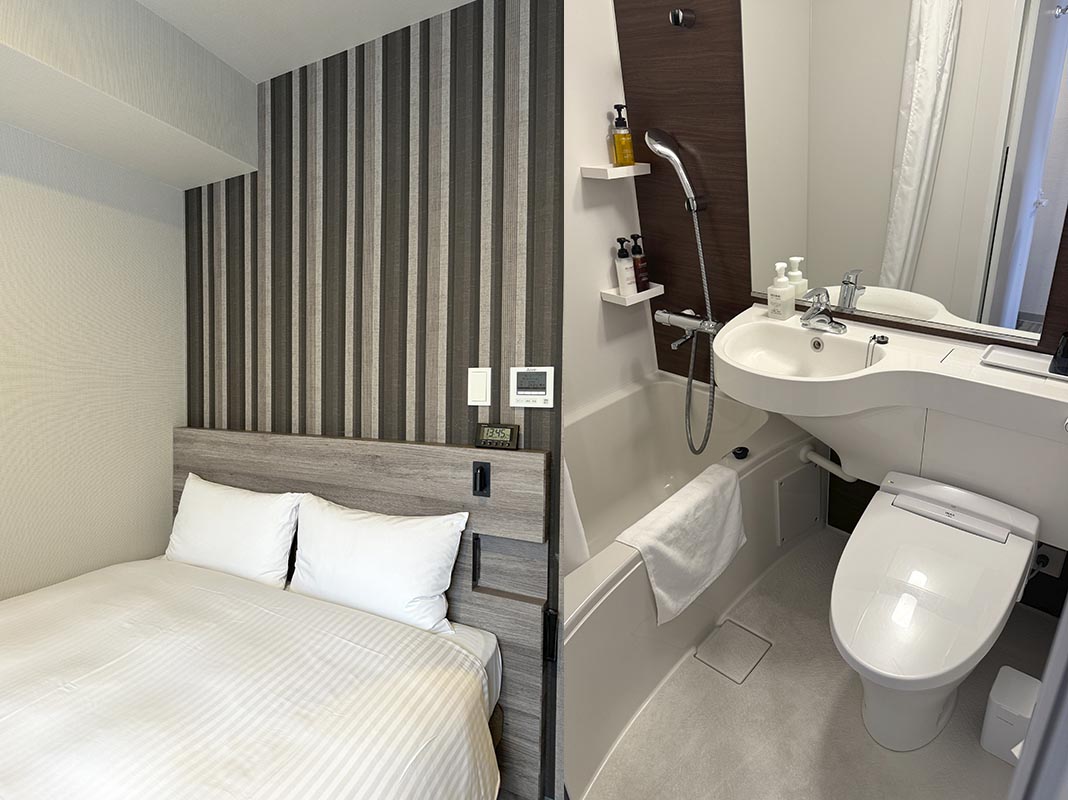 I booked rooms at three Smile Hotel locations in Japan for $36-$50 a night on my trip in September. The hotel brand has clean rooms in convenient locations withing walking distance of major train stations.
I booked rooms at three Smile Hotel locations in Japan for $36-$50 a night on my trip in September. The hotel brand has clean rooms in convenient locations withing walking distance of major train stations.
How much cheaper are mobile hotel rates?
On average, it is 10-30 percent cheaper than desktop prices. Booking.com requires participating hotels to offer at least a 10% discount.
Why are mobile hotel rates cheaper?
There’s a higher cost to get desktop users to book—paying for ads and keywords—whereas mobile users are easier to convert to a sale. Booking.com says 50% of its traffic is from mobile. (The same article says that two-thirds of those bookings are made by millennials who leave more reviews than other groups.) Some hotels even offer lower rates strictly to mobile users based on these high usage statistics.
It’s always worth double-checking desktop rates, but I’d advise doing it without logging into the website. I had one instance where it seemed like the mobile app changed to reflect the desktop price after I logged in online.
If the “mobile” rate is a good deal and there’s free cancellation, I often just book it on the spot. Then, check the desktop site later to verify. Keep in mind that just because the app claims it’s a “mobile only” deal doesn’t mean that it actually is a better rate. Do your homework.
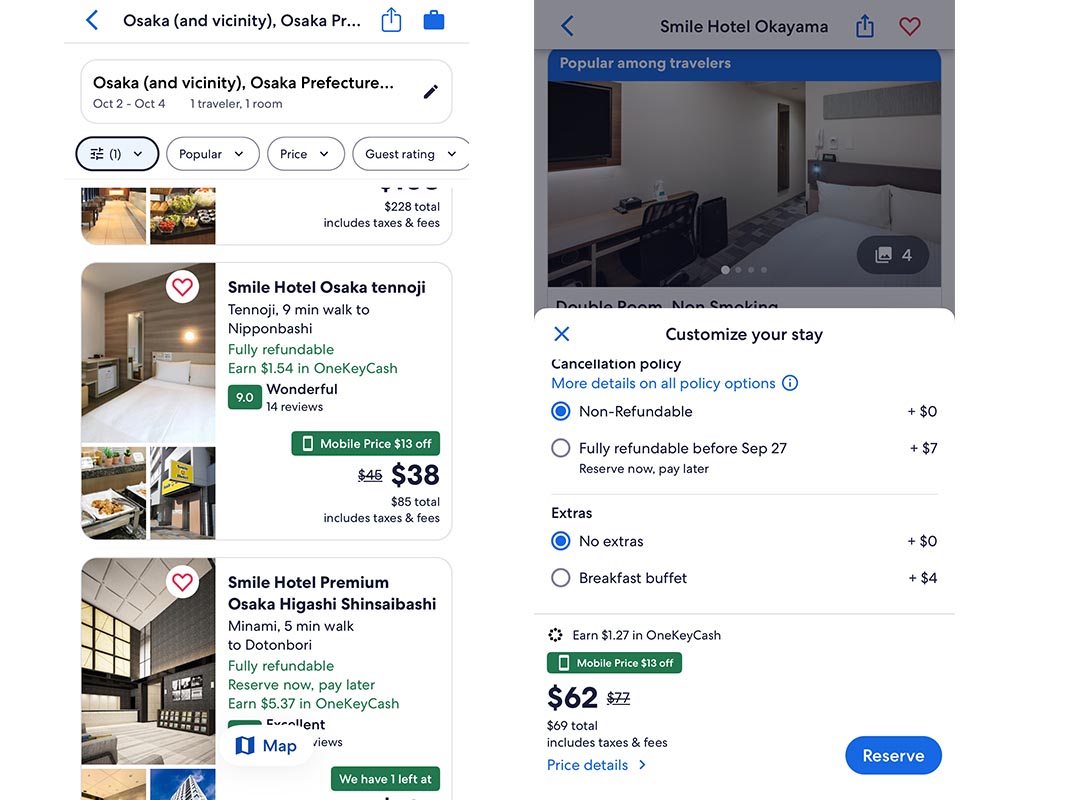
The Expedia’s mobile rates show up as a green icon when using the app.
What is the best travel app for hotels?
Honestly, I check a variety of apps along with the hotel’s website to compare. My go-to apps are Expedia, Booking.com and Hotels.com. I used Booking.com for my Kumano Kodo hotels and Expedia for all the big cities but did find a cheaper deal on Hotels.com for my hotel (Iroha Grand Hotel) in Nara, Japan. (In Tokyo, I loved this hotel!) I don’t really have any loyalty between the brands. I simply book the cheapest option with the most flexible refund policy.
Loyalty programs and rewards are also important and can help save you more money. Since I’ve finally achieved Booking.com’s highest tier (Genius Level 3), I automatically get 20% off many bookings and even scored a simple room for $26 in Shingu, Japan!
Looking for more Japan travel tips?
Check out my Instagram highlights for a detailed story on budget trips for Japan travel and my hike along the Kumano Kodo, the sacred UNESCO-designated pilgrimage trek.
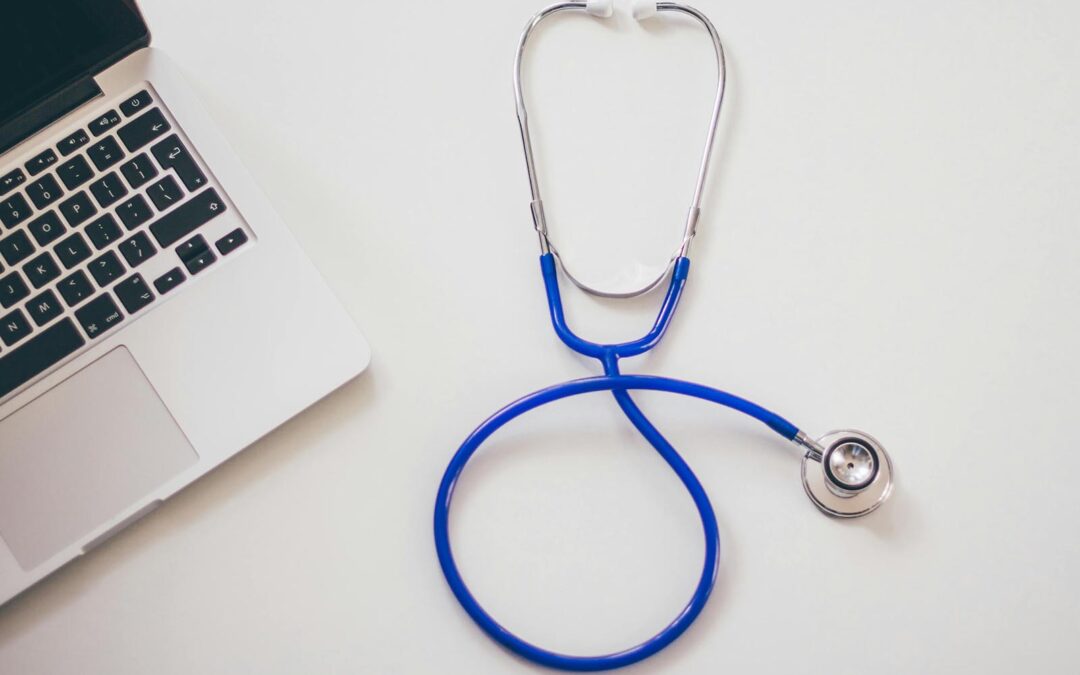
Why I go Abroad for Health Care
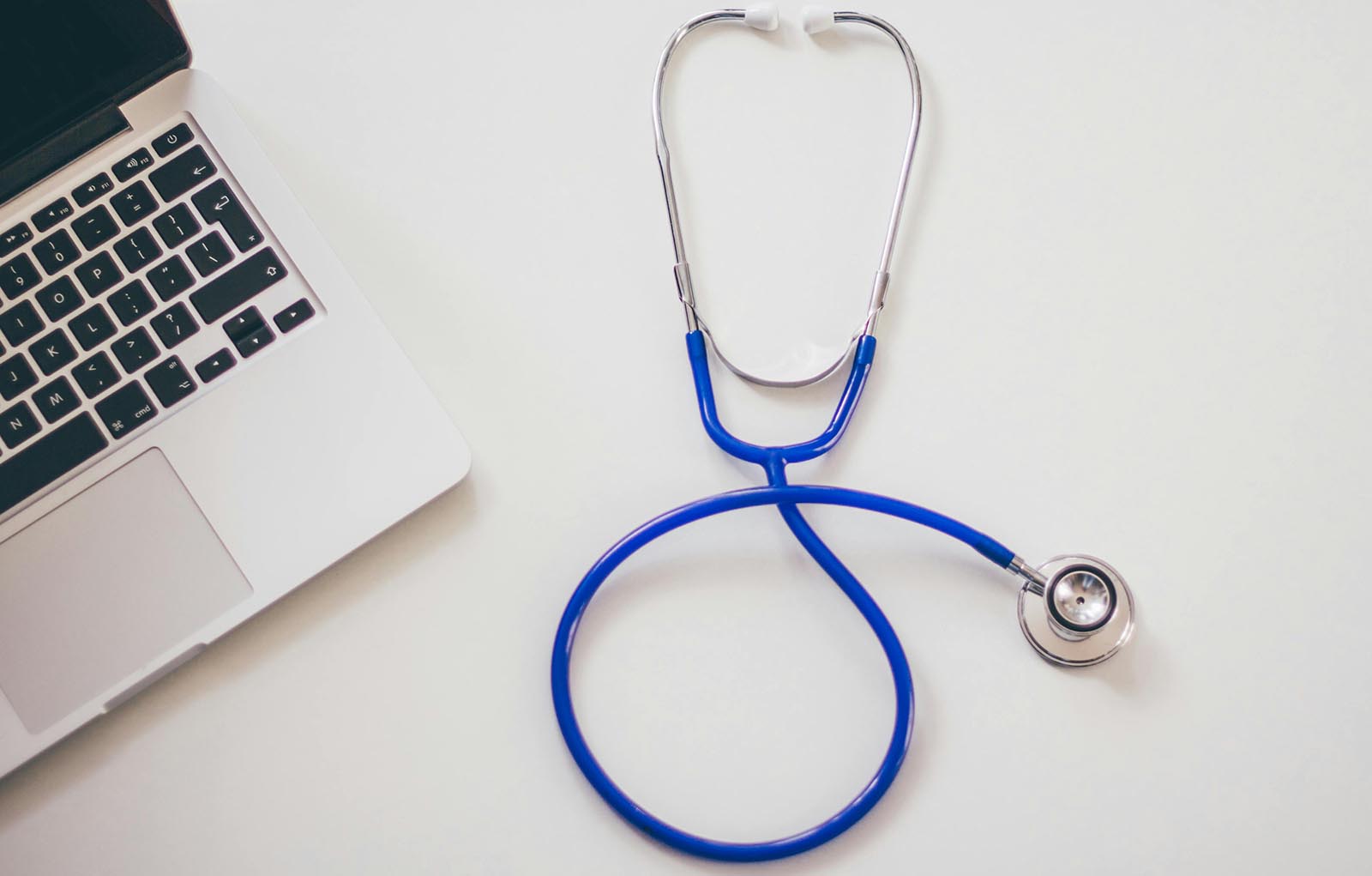 Photo Credit: Stock image from Pexels.com
Photo Credit: Stock image from Pexels.com
As a full-time freelancer, finding health care has always been one of my biggest burdens due to the lack of cost transparency and the complicated structure of the American medical system. Since I work for a travel company for part of the year, I have a travel insurance policy that covers me when I’m working abroad.
Travel insurance is $92/month (It would be cheaper if I was under 40.) with no copays or deductibles while my U.S. insurance was $450/month in 2017 with high copays and deductibles.
Health insurance is one of those topics that gets me all riled up, so I’ll do my best to avoid getting on a soapbox. I feel so strongly about the subject that I even wrote a chapter in my book about how to hack the cost of U.S. healthcare because I understand it well, especially the flaws.
In short, the American healthcare system is inefficient and expensive. (Source: The Atlantic) While the quality of care is high in the U.S., the lack of transparency about cost is what frustrates me more than anything because I want to pay upfront and not wait months for some mystery bill to arrive in the mail. Plus, it often takes months to get an appointment, which is nightmare because of my work schedule. Due to this, I’ve started going abroad for my annual physical, routine dental cleaning and other routine doctor appointments. I wanted to explain how I handle medical care in my nomadic lifestyle and dispel myths about the quality of care abroad. I highly recommend it and wish I’d started doing this sooner!
The goal of this post is to show what works for me and share my experience. I hope you find this helpful or at least, interesting!
Affiliate links are used in this post for travel insurance only. If you make a purchase, I earn a small commission at no cost to you, which goes toward the cost of maintaining this blog.
Why I Go To Thailand for Medical Care
 All the mailboxes in Bangkok are separated by location.
All the mailboxes in Bangkok are separated by location.
I have lived and worked in Thailand off and on for the last decade. I love the country and spend most of my winters in Chiang Mai. I’ll probably retire in Thailand because it just feels like home and it’s always warm.
I had a great experience in 2012 when I went to Bumrundgrad Hospital in Bangkok when one of my running injuries flared up. They did a hip x-ray and gave me the results immediately. It all cost a total of $70 compared to the $700 my insurance was billed for the exact same x-ray I had six months prior in the U.S.
Bumrundgrad and Bangkok Hospital have been recommended by all the expats I’ve met living abroad and even my Thai friends. And, these Thai friends have all lived in New York City and other parts of the U.S. so they understand the U.S. healthcare system.
In Hong Kong in 2018, I had lunch with some old friends — a wealthy retired couple from Australia who spend part of their year in Phuket. They both go to Bangkok Hospital in Phuket for their annual physical, which is what led me to start getting health screenings in Thailand as well! I’ve started conversations with other foreigners I’ve met at these hospitals. Most are more affluent than me proving this isn’t something that lower-middle-class folks due to save money. It’s high-end care at an affordable rate! (My income has doubled since I started getting my healthcare done in Thailand, so I can afford to pay for care in the U.S. but prefer the efficiency, quality and refreshing price transparency of Thailand. )
Private healthcare in Thailand is affordable at baseline. Travel insurance doesn’t cover routine care like annual physicals and dental visits. I pay out of pocket for these, but the hospitals all accept insurance.
If you’d like to read more about the quality of Thai healthcare, The Economist recently did a story, Why is Thai health care so good?, and a case study about how the U.S. and Thailand compare on healthcare spending.
The Cost of an Annual Health Checkup in Thailand
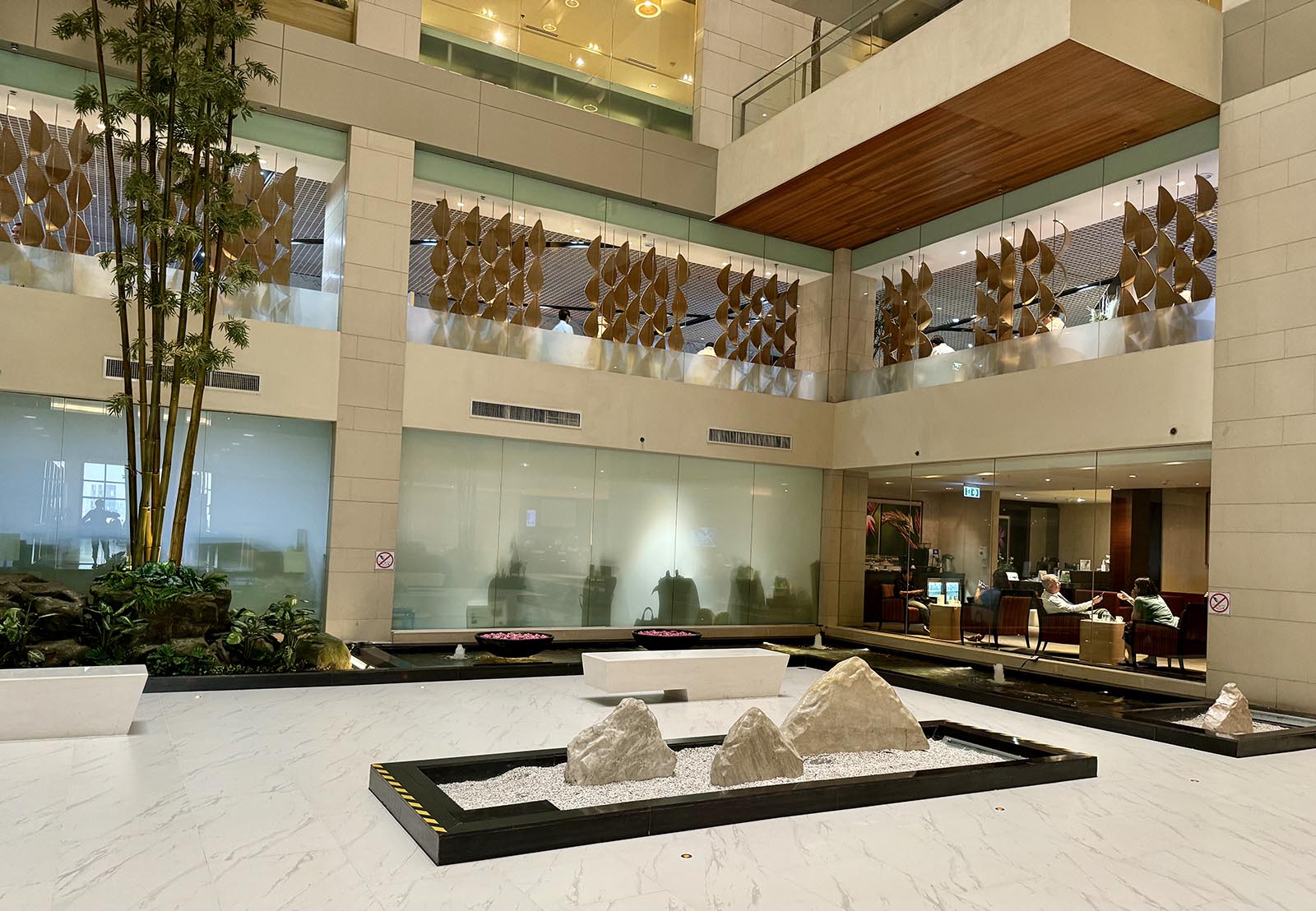 The central interior courtyard at Bumrundgrad Hospital in Bangkok looks like a posh hotel more than a hospital!
The central interior courtyard at Bumrundgrad Hospital in Bangkok looks like a posh hotel more than a hospital!
The quality of the private healthcare system in Thailand is extremely high, safe, efficient and affordable. Unlike in the U.S., the prices are clear and posted. Bloodwork and other test results are delivered in roughly 60-90 minutes.
There is a set price list for annual health check options online for both of the major hospital brands in Thailand. Prices increase based on your age due to the extra tests that are included in the package. The prices below are for Bumrungrad Hospital.
2019: I chose the cheapest option since I’m under 40, and the cost was 7,140 Baht/$235 USD. (Note prices are higher for females because a pap smear is included.) This includes normal physical blood work, a pap smear, a chest x-ray, urine and stool samples and detailed consultation with an English-speaking doctor. This takes two to three hours.
2022: Since I’m 40 now, I had to choose a higher-priced package that included a mammogram with ultrasound, pap smear, EKG, ultrasound of the whole abdomen, chest x-ray, extensive bloodwork and urine/stool samples, and detailed consultation with an English-speaking doctor. All results except the pap smear were given to me at the appointment. Cost was 30,500 Baht/$847 USD. Clearly, this is higher than 2019, but it also includes a lot more. Again, prices are cheaper for men because they don’t need a pap smear or mammogram. This takes roughly three to four hours.
2023: The cost of the same package increased to 33,420 Baht/$991 USD, which was about a 17 percent increase from the previous year.
2024: The cost of the same package increased only slight to 34,700 Baht/$1,029 USD, which was only a 4 percent increase. It only took me three hours from when they took my bloodwork until the end when the doctor sat down and gave me all my results.
The doctors all speak fluent English. You can choose a doctor off the website based on their credentials. (My doctor grew up in Florida, and she’s awesome!) I did this a few times but honestly, it wasn’t necessary since the doctors I was randomly assigned at other times were great and spoke perfect English.
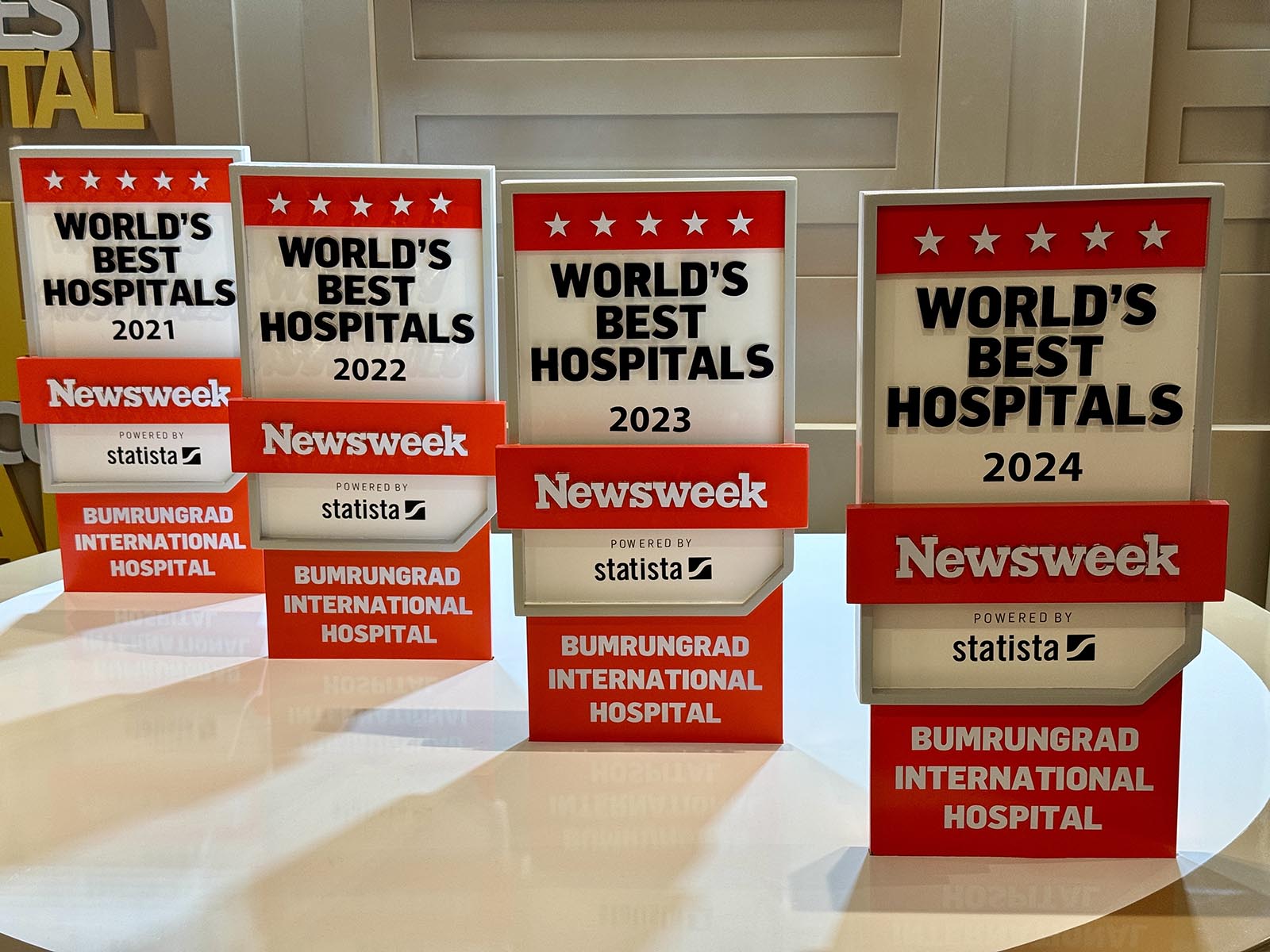 Bumrunggrad International Hospital in Bangkok is constanlty rated one of the best in the world by Newsweek.
Bumrunggrad International Hospital in Bangkok is constanlty rated one of the best in the world by Newsweek.
Step-by-step guide to a health checkup process at Bumrundgrad Hospital in Bangkok
When you arrive at the hospital, you check in and register to be in the hospital system. If it is your first visit, you’ll need your passport, and they’ll take your photo for their charts. You’ll be given a hospital number that’s your reference for future visits and medical records.
Next, you go to the health screening floor. You take a number and are called up to the registration counter in less than 10 minutes. They go over what package you’ve chosen and what’s included. If you have any medical records or previous x-rays/labs, bring those with you as well. They give you a hospital bracelet with your name and birthday and a barcode they scan at every step of the process. New in 2024: They give you a little buzzer like you’d get a restaurant that lets you know when you are next for all the procedures. Very efficient!
The next counter is the cashier. (You only pay for health screenings in advance since they are packages. Payment is done for normal appointments afterward. Unlike in the U.S., they can easily quote you exact prices before you are given any treatment or tests.)
The floor is set up in a giant circle with the central glass-enclosed area looking down on a well-manicured courtyard below. Each area you proceed to is labeled by letter from A to D.
-
- At Counter A, they take your blood pressure and weight, do bloodwork, measure your waist and check your vision. When doing any records or bloodwork, the nurses are constantly asking you to verify your information on the paperwork and labels. They scan you hospital bracelet for everything. They have you verify your name on the vials for the blood, which is printed on a label. Everything is sealed, packaged and sanitary just like in the U.S. (I used to work in India so I’ve been to some proper third-world hospitals, so I know the difference!)
- At Counter B, they ask for a urine and stool sample. This is also where you do your chest x-ray, mammogram with ultrasound, EKG and whole abdomen ultrasound. They give you a key to a locker in a giant changing room/bathroom that’s separated by gender. Each locker has a set of clean scrubs, slippers and hangers for your clothes. They even give you a cute free scarf to wear if you are cold, which is nicer than the Target scarf I packed for this trip.Your name is printed on the containers for the urine/stool samples. You place those in a little cubby inside the bathroom for the nurses to retrieve. You sit in the lobby for your x-ray and other tests for just a few minutes. They call you, and you are done quickly. (Again, they scan your hospital bracelet that they use to verify your name with every test and scan into their computer.) After you are finished, you toss your scrubs in the bins provided and give back the key. They go through, clean and replenish the lockers after each use. The slippers are disposable, so they aren’t reused so I just use my own shoes.
- Counter C is my favorite because it’s where they feed you! A free breakfast buffet catered by the J.W. Marriot is provided! All your bloodwork and test results are processed while you wait. For the basic package in 2019, it was roughly a 60-90 minute process from when they take the bloodwork, which was at Counter A. Keep in mind that they already started processing my bloodwork while I was doing the X-ray and other tests. There’s free, fast wifi so I brought my laptop so I could work while waiting. I barely had a chance to do any work previously because they were so quick to call me!I usually set at Counter C for about 30 minutes or so before they call me back to see the doctor. The doctor goes over your full bloodwork and chest X-ray, mammogram, EKG and abdomen ultrasound results in detail. They ask about preexisting conditions and if you have any concerns. They also do a normal exam listening to your heart and lungs, etc. For women, this includes a breast exam if you didn’t get a mammogram. (You are randomly assigned a doctor. I really liked my doctor. She grew up in Florida and went to medical school in Thailand. I really liked her, so I always request her.)Afterward, men are free to go, but women are ushered over to another hallway to see another doctor to have a pap smear, which is a quick process. This is the only result that’s emailed to you afterward. I got the email about three days later with a detailed PDF with all my test results including the pap smear.
After this, I was done and free to leave. The entire process took about three hours, but they tell you it might but close to four hours! The cost of the health screening and the roundtrip flight to Thailand is cheaper than paying for three months of my old insurance plan in the U.S.!
Important Note: I have no preexisting conditions or major health concerns. I’ve often thought about what I would do if I did, and I would most likely be forced to live abroad most of the year. This would mean making a base in a country like Thailand where medical care is affordable and only traveling to the U.S. for short visits. I spent too many years working jobs in the U.S. that I hated just for the health insurance and decided life was too short to be that miserable. (It’s amazing how my career took off the minute I quit the job I was working just for the healthcare because I finally had the time to devote to what I really wanted to do.) I would just adjust my lifestyle and move my base elsewhere, which also might mean a shift in the type of work I do as well. These things are always on my mind! And, again, this is what’s best for me. I just all this information is helpful to others!
Specialist Doctors in Thailand
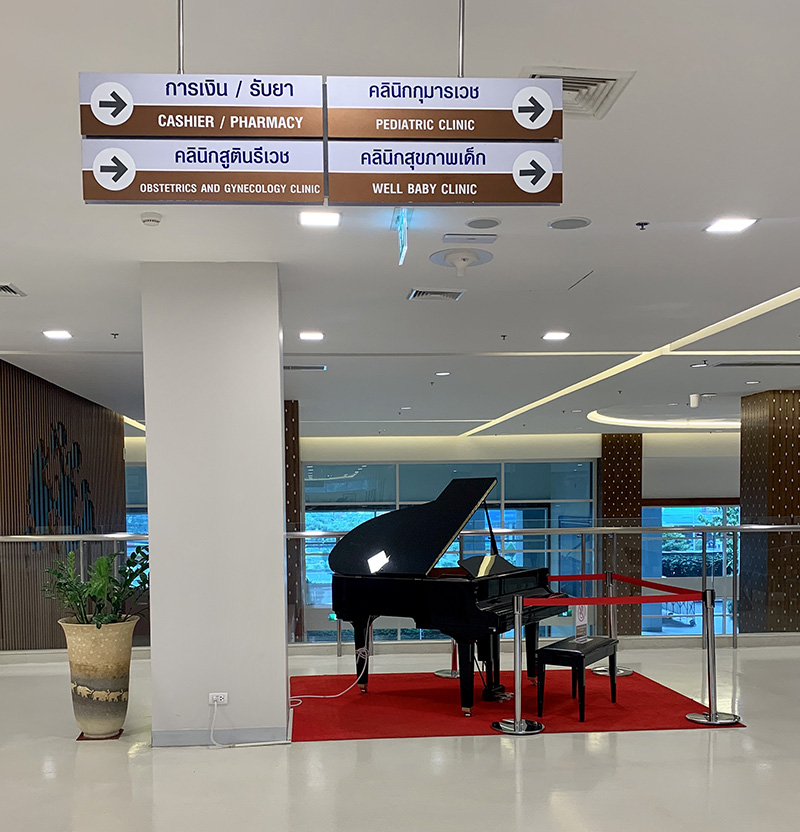 The lobby at Bangkok Hospital in Chiang Mai, Thailand.
The lobby at Bangkok Hospital in Chiang Mai, Thailand.
Dermatologist
Since skin cancer runs in my family, I always go to a dermatologist for a full-body skin check. There is an option to choose a doctor off the website based on their photo and their bio, which is what I had done. I chose one who went to school in Boston. (From this experience and my last experience in the U.S., never choose the young, pretty dermatologists because they will make you feel bad about how you are aging and try to sell you all these cosmetic procedures that aren’t necessary. Older women are always nicer.) This was the only doctor I didn’t really like, but I also felt exactly the same about the last dermatologist in the U.S. who tried to sell me cosmetic procedures. I ended up with a different one this year in 2024 and she was great!
2019 Total Cost: 1,730 Baht/$57.12 USD
2022 Total Cost: 2,000 Baht/$55.54 USD
2023 Total Cost: 2,860 Baht/$84.82 USD (This was a much longer appointment to cover different skin concerns and questions I had, so it cost a bit more.)
2024 Total Cost: 2,675 Baht/$79.34 USD (This year, I had a new doctor who charged a bit more for a new patient visit, but it was still cheaper than last year.)
Gynecologist
I had a golf-ball-sized ovarian cyst a few years ago so as a preliminary measure I went to see a gynecologist for an ultrasound as a precautionary measure in 2019. This entire process from meeting with the doctor to doing the ultrasound was less than 45 minutes. We sat in her office and discussed everything first. I showed her the results from my previous ultrasound in the U.S., which I keep on my computer. During the process, she even had the ultrasound on the screen and labeled everything during the process. (Thankfully, everything was good!) I feel more comfortable with a woman doctor in most situations especially this one, so I chose a woman off the website who went to school in Germany. She reminded me of my grandma with her accent, and I totally loved her. I knew this would cost more, but I wanted to be sure things were okay. I knew I was paying for peace of mind! 2019 Total Cost: 7,060 Baht/ $233 USD ($100 for ultrasound, $100 for doctor fee & $33 for supplies) Now that I’m 40, my healthcare package includes an ultrasound.
Which is better: Bangkok Hospital or Bumrundgrad?
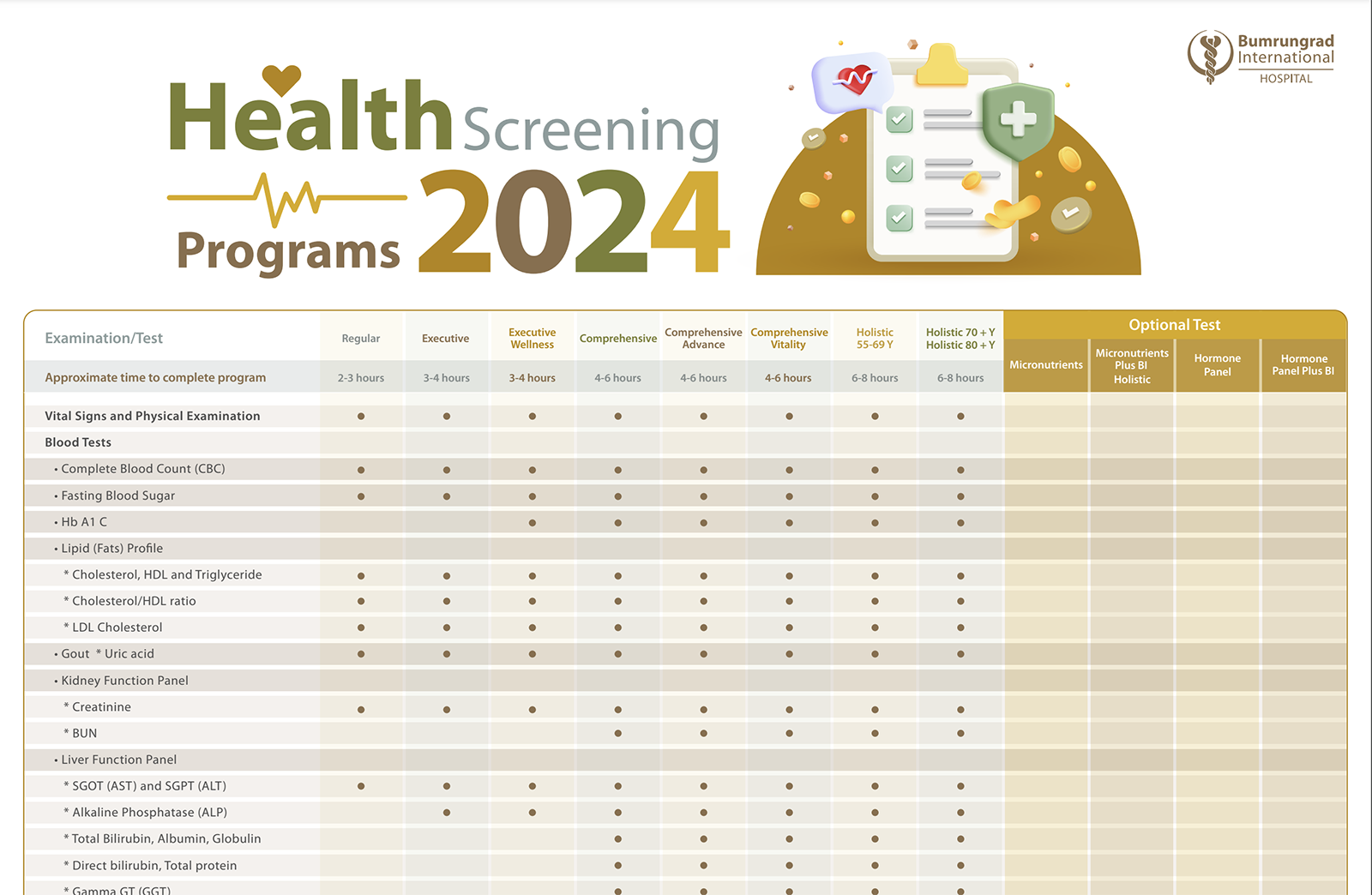 This is a screenshot of the health screening options offered by Bumrundgrad International Hospital in Bangkok.
This is a screenshot of the health screening options offered by Bumrundgrad International Hospital in Bangkok.
Both Bumrundgrad International Hospital and Bangkok Hospital offer similar packages. Bangkok Hospital offers discouts making them a bit cheaper. Since Bumrundgrad has my medical records and I like my doctor, I decided to keep using them. Prices increase yearly for all packages, which I covered above.
For appointments, I’d book at least a week ahead. I booked a few weeks ahead so I could get an early morning appointment and my doctor of choice. In Bangkok, both hospitals are fairly accessible by public transit. Since Bumrunggrad doesn’t have a branch in Chiang Mai, I go to Bangkok Hospital in Chiang Mai, which is $3 taxi ride from the center of town.
Bangkok Hospital is the largest network in Thailand with over 40 hospitals in big cities including Phuket. My Thai friends (even the one who lived in New York) like Bangkok Hospital better but say both have the same quality of healthcare.
Keep in mind that the cost of these hospitals is very expensive to most locals. The average income in Thailand is $10-15 USD/day. (This figure comes from a nonprofit I volunteered with several years ago but has likely increased. I see other sources saying it’s $20/day but can’t verify the accuracy.) The two hospitals I mention are private and the most expensive in the country. There are significantly cheaper options that offer quality care for locals, but those doctors don’t always speak English, which is why I go to the private hospitals, which cater to foreigners.
Medicine in Thailand
 Photo Credit: Stock image from Pexels.com
Photo Credit: Stock image from Pexels.com
In Thailand, you can just buy common antibiotics at the pharmacy without a prescription like doxycycline (malaria drug) and azithromycin (used to treat strep throat, food poisoning, etc.). This does NOT include controlled substances like pain or anxiety meds, etc. Certain medications are only available at pharmacies inside hospitals with prescriptions. When I am prescribed or suggested to take a medication or dosage that I’m not sure about while traveling, I simply call a 24-hour pharmacy in the U.S. like Walgreens or CVS and ask to speak to a pharmacist to get their opinion. I do this in the U.S. all the time to check drug interactions, etc. (You can call U.S. numbers abroad for free with Google Voice.)
If a doctor at any hospital in Thailand prescribes you medicine, it’s much cheaper (almost 50%!) to buy it outside the hospital. Siam Pharmacy near Bumrundgrad Hospital in Bangkok has a wide selection. In Chiang Mai, Dara Pharmacy, not far from Bangkok Hospital, has a wide selection at better prices than the hospital.
Travel Vaccines in Thailand
For travel vaccines, I verify the name of the vaccine to ensure it is one that’s approved by the FDA in the U.S. I recently got my Typhoid Fever vaccine again, which was a shot that lasts for two years. It was a simple process, and the vaccine cost 1,533 Baht/$42 USD (2022 prices), which is half the cost in the U.S.
In late 2024, I got my Yellow Fever vaccine since my plan is to go to Africa next year. It was 5,269 Baht/$155, including the shot and doctor’s fees. (It costs $240 to get the Yellow Fever vaccine at Walgreens. I called while I was in the waiting room just to check.) I had to see a doctor in the infectious disease department, who used to live in Texas oddly enough, to get the shot. He was great and it was a quick process with a same-day appointment. I mainly got this abroad for convenience, but the price savings was a nice bonus.
Dentists in Thailand
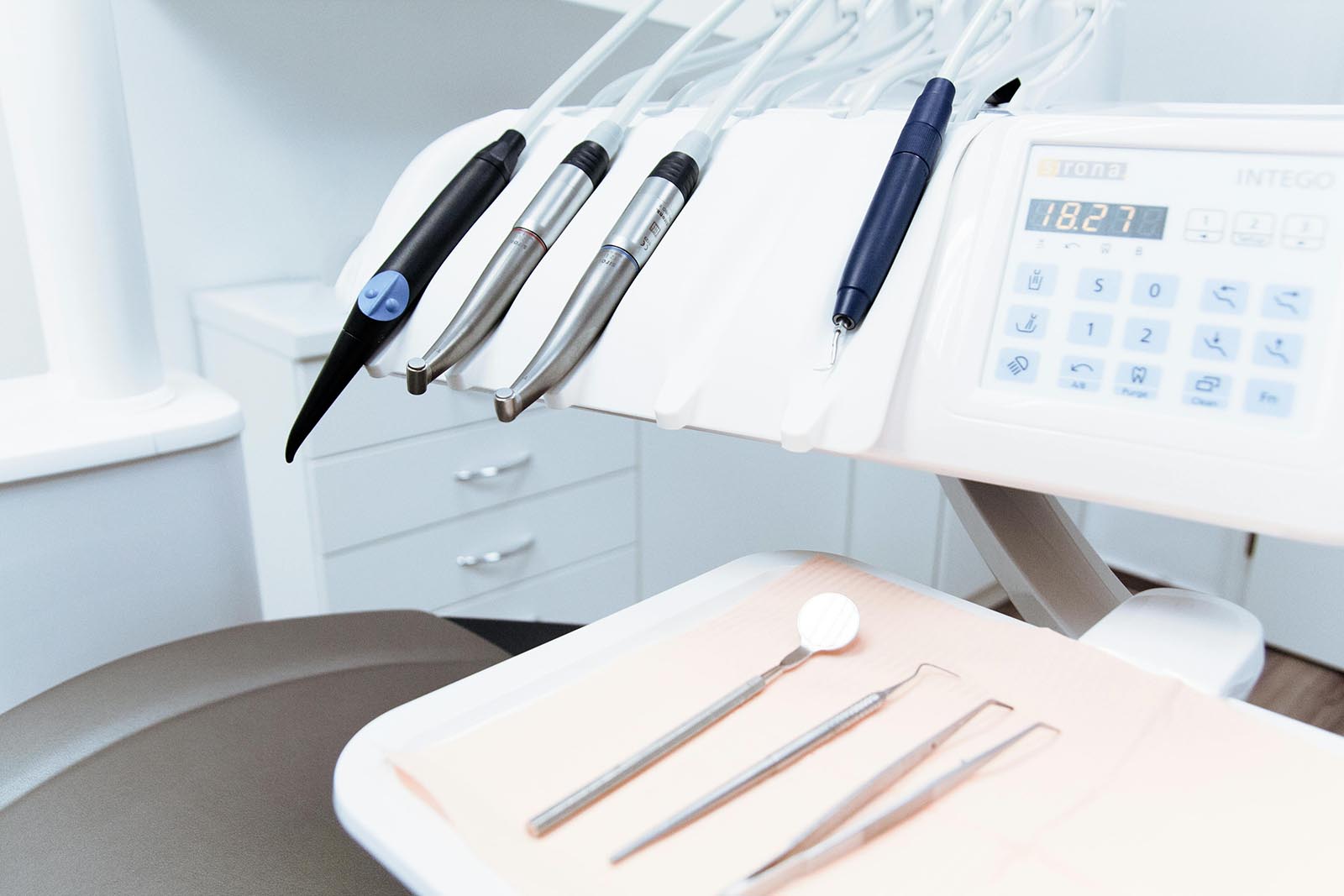 Photo Credit: Stock image from Pexels.com
Photo Credit: Stock image from Pexels.com
I also get my teeth cleaned in Bangkok at Thantakit International Dental Center at their All Season’s branch. This was recommended to me years ago by my expat friends. The best part about this place is that my teeth cleaning included free pick-up and drop-off in a private car! I started getting my teeth cleaned in Thailand in 2013 after my dental hygienist in Santa Barbara recommended it after she’d scolded me for going too long between cleanings because I’d been living in Asia! She’d lived in Bali previously and said the quality of dentists in Asia was good. In Thailand, an actual dentist cleans your teeth.
2019 Total Price: 1,350 Baht/ $44.56 USD (Thantakit gives you a 10% discount if you pay cash.)
2022 Total Price: $1,200 Baht/ $33 USD + 800 Baht/$22 USD for fluoride application. (I’ll decline the fluoride application in the future because it’s not really needed and I didn’t realize it was extra. It was just added like it was part of the procedure. They still give you a 10% discount for paying in cash. My dentist was lovely so I’d go back to her.)
2023 Total Price: $1,350 baht/$44.46 USD (It was 1,500 Baht but they gave me a 10% discount for paying cash.)
2024: Total Price: $1,500/$44.49 (They stopped doing the 10% cash discount so I just pay with a card now to earn my airline loyalty points!)
Full disclosure: I have perfect teeth, but I went through literal hell to get them, including five years of braces, a cracked tooth, a root canal and a crown that was another two-year hellish ordeal. I’ve lived in five states in the U.S. and been to many dentists, only three I’ve liked. Now, I only trust my hometown dentist with major dental work and will not do that abroad or in another state in the U.S. (I wish I’d driven 18 hours to him instead of getting that damn root canal/crown in Texas.) While I’m open to doing most things abroad even surgery, I won’t let anyone else touch my teeth for major dental work. No one does teeth as well as America.
Dental tourism is a huge business in Thailand. The island of Koh Samui in Southern Thailand is filled with dental centers, especially ones that do implants. People literally fly in and start the process on the first day of their vacation. They vacation and then come back at the end to finish the process!
To dig in a bit deeper into medical care abroad, I also wrote a Travel Insurance Guide here!
What I Do for Health Insurance in the U.S. as a Freelancer
When I quit a part-time job that provided health insurance in May 2017, I paid for a middle-grade healthcare plan through a Texas company called Sendero Health. I purchased it through the health care exchange (Affordable Care Act). Initially, I had a subsidy for my policy, but my income increased so I owed the full amount.
My monthly premium was $350 but jumped to $450 in January 2018. All my co-pays and deductibles doubled, which is why I immediately canceled the plan. While a lot of doctors in Austin were in-network, they often had a limited “quota” for my type of plan that was already filled.
Most of the doctors who I found that would take my insurance were terrible. I canceled the plan because it was useless and focused on other alternatives. (For the self-employed, the Affordable Care Act (ACA) isn’t perfect, but it is a step in the right direction because it covers preexisting conditions without increasing premiums.)
To be VERY clear, I ALWAYS have some form of health care coverage. It’s too risky to do without. When I’m traveling, I have travel medical insurance, which is roughly $92/month with no deductible. (Again, this was half the cost before I turned 40.) This covers if I get sick while traveling and emergency evacuation. For these policies, I pay upfront or monthly depending on how long I need the policy. and they reimburse me in roughly seven to 30 days. (U.S. health insurance rarely covers you abroad.)
For U.S. coverage, I previously used a short-term high-deductible major medical plan that costs roughly $175/month to cover major emergencies with a $7,500 and 100% co-insurance. This means if I get sick, I pay the first $7,500, and they pay 100% of the rest. As of September 2024, the U.S. government restricted short-term major medical policies to only four months maximum in a 12 month period. (This varies by state, and some states have a shorter duration.)
Due to this change, I started investigating global polices that cover up to 180 days each year in the U.S. for Americans who live abroad (Thailand is my current base.) and decided on a Cigna Global plan. (Other similar options include GeoBlue and Vumi, which both have shorter limits for U.S. visits (21 days at a time). Those limits are why I chose Cigna Global.)
Important Note: Most of the ACA plans and even private plans have very limited coverage outside of the state that you live in so read the fine print carefully. If you have an emergency out of state, the doctor will most likely be out-of-network so you’ll be on the hook for that amount. In January 2022, Congress passed the No Surprises Act, which expands restrictions on charging health care plan holders out-of-network rates for certain services. While this can help, I still want to stress the importance of fully understanding your out-of-network benefits within the U.S. for ACA plans.
I’m currently investigating cash-based and direct primary care practices that don’t accept insurance as an alternative. (An example of one these practices is Brightmark Health in Birmingham, Ala. if you’re interested in looking into details. I chatted with the owner, Dr. Jospeh Wu, about the business model recently for a potential freelance story.)
These cash or direct primary care practices paired with a lower cost high-deductible catastrophic insurance plan could potentially lower healthcare costs while also increasing the efficiency of medical care and more quality one-on-one time with the doctor. This could be a game changer for many Americans, including freelancers like myself.
(Check out my post on travel insurance here!)
What travel medicial insurance is best for Thailand?
Travel medical insurance is one of the most important things to purchase for any trip abroad, especially Thailand. It covers all the things that could go wrong from injuries to travel delays so that you don’t have to worry and can focus on traveling! I’m a big fan of SafetyWing’s Nomad Insurance, which offers $0 deductible travel medical insurance coverage for over 180 countries for people aged 69 and under when traveling outside their home country. (Please note that travel medicial insurance will not cover any of the routine doctor’s visits above but will cover injury or illness.) For more details on my experience, read my review of SafetyWing in Thailand!
(AFFILIATE DISCLOSURE: Please note that some affiliate links for SafetyWing travel medical insurance are used in this post. If you make a purchase, I earn a small commission at no cost to you, which goes toward blog maintenance costs. I only recommend products and companies I truly love and use.)
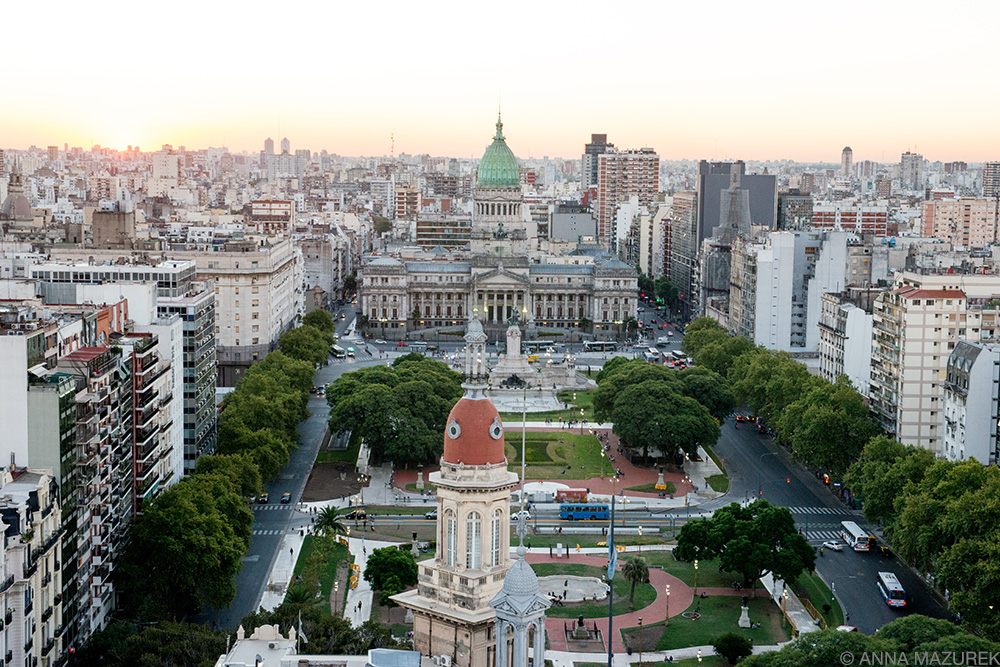
The Ultimate Guide to Buenos Aires
 The view of Plaza del Congresso and the Argentine parliament building from Palacio Barolo, one of the city’s most beautiful buildings.
The view of Plaza del Congresso and the Argentine parliament building from Palacio Barolo, one of the city’s most beautiful buildings.
There is no city in the world as seductive as Buenos Aires. While the skyline isn’t sexy, the city itself is intoxicating. The streets are lined with grand European palaces, cozy cafes and endless parks. The stables of life are steak, wine and ice cream. Dinner never starts before 9 p.m. and most places close daily for an afternoon siesta. After dinner, everyone dances tango until almost sunrise.
I fell in love with this city in 2015 and have been back many times to live during the U.S. winter. I even wrote about my love affair with Buenos Aires for a travel story for the Washington Post, which digs into the history and beauty of the city. In addition to that story, I made a more detailed guide of the best places to visit, eat and tango in Buenos Aires.
From eSIM cards to travel medical insurance, keep reading for all the details about where to go in Buenos Aires and how to best prepare for your trip!
Plan Your Trip
Currency: Argentinian Peso (ARS)
When to Go: Spring (September to November) & Spring (March to May)
Travel Insurance: Protect yourself with SafetyWing travel medical insurance to cover accidents and travel delays.
Mobile eSIM Card: Get seamless connectivity worldwide with Airalo minus the hassle of physical SIM card. (Save 10% with code AIRALOESIM10!)
When to Go To Buenos Aires
Peak season for tourism is their summer—December to February, which is when I prefer to go because I love the heat. Temperatures range in the 80s most of time, but start to cool off to high 70s in February. The shoulder season of November and March are also nice. November is when the famous jacaranda tree purple flowers bloom, but weather will be chilly enough where you’ll still need a light jacket.
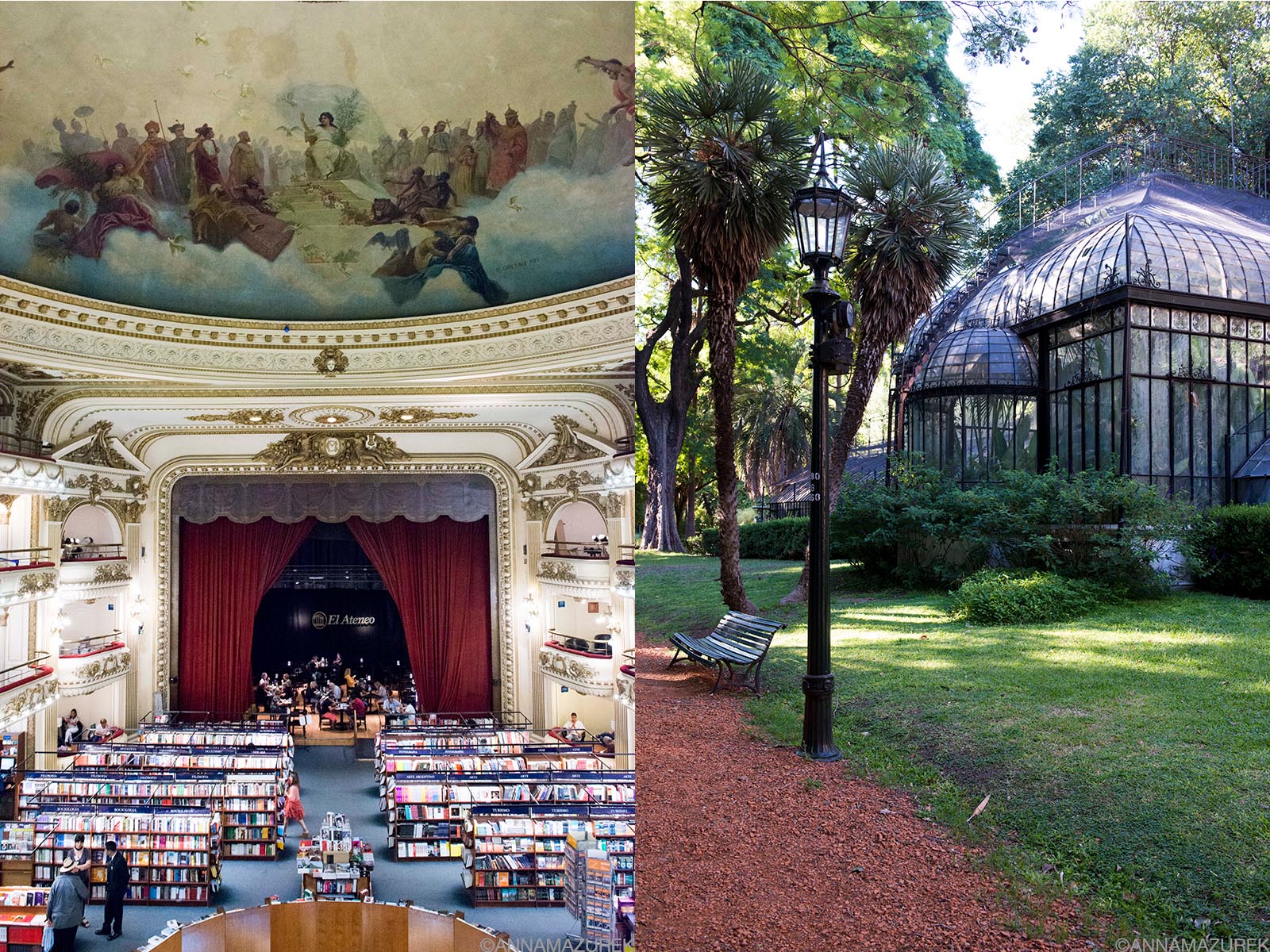 El Ateneo Grand Splendid bookstore (left) and Buenos Aires Botanical Gardens (right) are both gorgeous and free!
El Ateneo Grand Splendid bookstore (left) and Buenos Aires Botanical Gardens (right) are both gorgeous and free!
The Best Things to Do in Buenos Aires
-
Palacio Barolo is the best spot for a scenic view of the skyline and the parliament building. The building was inspired by Dante’s Divine Comedy and has 22 floors that match the content of the poem directly. The palace now consists of many offices, but they have daily tours that take you into the lighthouse at the top of the building.
-
Le Recoleta Cemetery. One of the most notable graves in La Recoleta Cemetery belongs to Eva Perón. The 14-acre grounds are hauntingly beautiful – elaborate above-ground marble mausoleums and statues cover a sprawling grid of four city blocks lined with large walkways. Be sure to check out the weekend market in the adjacent park. Free Entry.
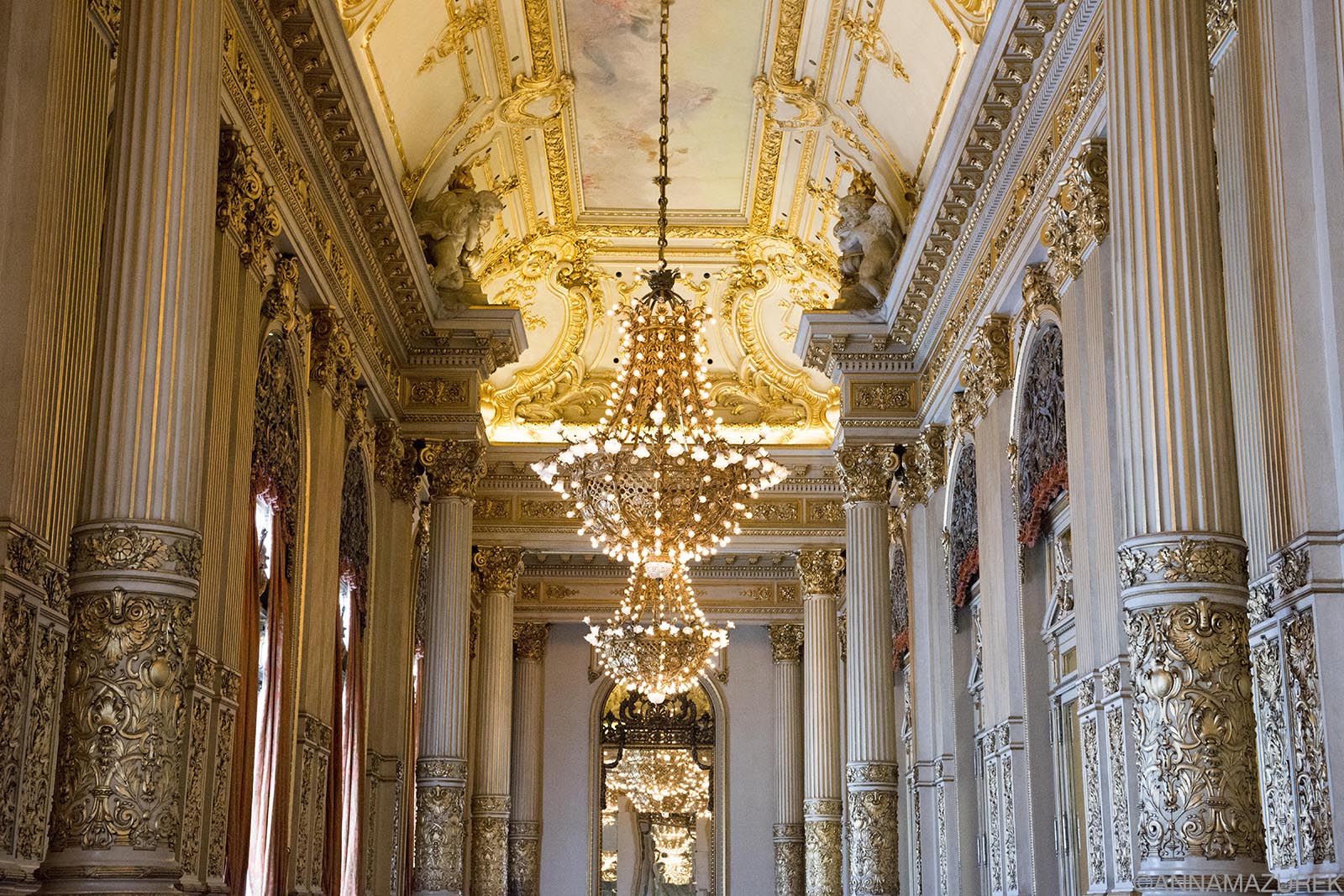 The stunning chandeliers in Teatro Colon in Buenos Aires.
The stunning chandeliers in Teatro Colon in Buenos Aires.
-
Teatro Colón is not only one of the finest opera houses in the world but one of the most beautiful buildings in the city. Built in 1908, the seven-story theater covers an entire city block and features ballet, opera and concert performances. Many of the lavish building materials – Venetian mosaics, French stained glass and three kinds of Italian marble—were all imported from Europe. If you can’t catch a performance, take one of the hourly guided tours. Tours run every 15 minutes from 9 a.m. to 5 p.m. daily in both English and Spanish.
-
El Ateneo Grand Splendid Bookstore has a story just as interesting as the décor. The building opened in 1919 as a theater called the Teatro Gran Splendid before converting into a cinema, which showed the first sound films in the country. The theater-turned-cinema was then converted into a bookstore in the early 2000s. Much of the interior, including the ornate carvings, remain intact. Bookshelves replaced the rows of seats, and the theater boxes were left for customers to curl up with a book. Dark red curtains frame the stage, which is now home to a quaint café. Free entry.
- National Museum of Decorative Arts is housed in a 1917 beaux-arts mansion that was originally the home of Chilean aristocrat Matías Errázuriz and his wife, Josefina de Alvear. When Alvear died in 1935, the family donated the house and its extensive collection of European and Asian art to the Argentine government under the condition it be used as a museum. The elaborate décor features a ballroom with hand-carved ceilings and artwork by Manet and Rodin. It is the only French mansion built at the beginning of the 20th century open to the public in Buenos Aires. There are also rotating art exhibits in the main floor and basement galleries. Entry is free.
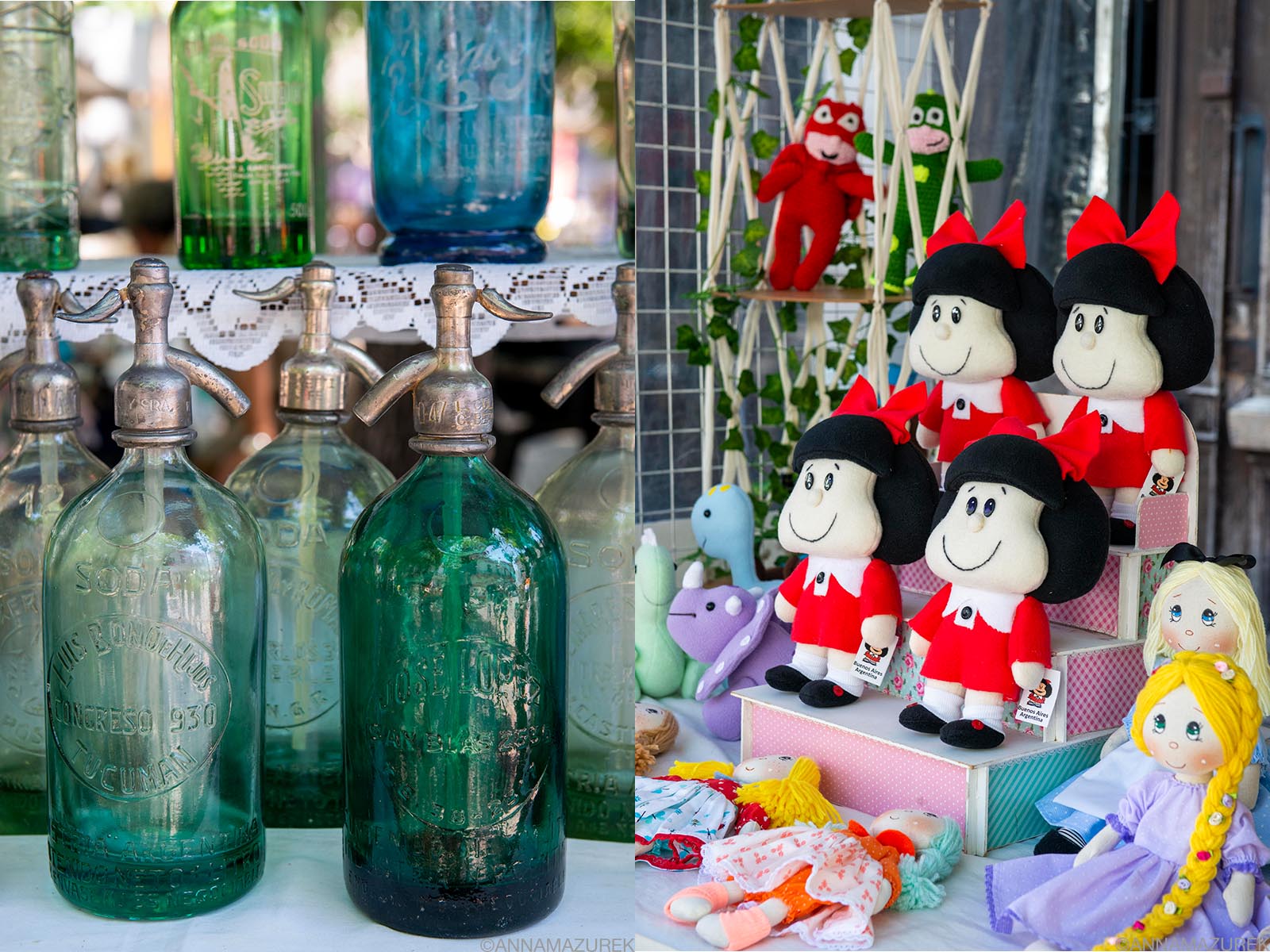 The San Telmo Sunday Market is filled with glass seltzer bottles and souvenirs of Mafalda, a famous Argentine comic strip.
The San Telmo Sunday Market is filled with glass seltzer bottles and souvenirs of Mafalda, a famous Argentine comic strip.
-
San Telmo Street Fair is the place to be on Sunday. Plaza Dorrego, the heart of the market, is focused more on antiques including a row of vendors selling vintage glass seltzer bottles. The stalls stretch out into the adjacent streets and eventually, it turns into more of a flea market with vendors selling leather belts, fresh-squeezed juice and merchandise centered around Mafalda, a famous Argentinean cartoon character. Sundays 10 a.m. – 5 p.m.; Free entry.
-
Parque Tres de Febrero is the biggest public park in the city. It includes a giant lake and a rose garden surrounded by a pedestrian track filled with runners and rollerbladers. It’s my favorite place to run in the city. On weekends, there are stalls renting bikes, pedal carts and skates. The park used to be the private grounds of a dictator and was named after the date he fell from power. Rose garden is open 8 a.m. – 8 p.m. daily.
-
Galileo Galilei planetarium has a nightly light show that you can’t miss. The planet-shaped building changes colors while the fountains in the adjacent lake perform a mini-show on the hour mark. While the museum is open during the day, there is free telescope viewing on weekend nights until 10 p.m. Av. Sarmiento, Light show is free.
- Museo Nacional de Bellas Artes is an art museum with a stunning collection of European master’s including Degas, Monet and Rodin, along with Argentinean artists. Entry is free.
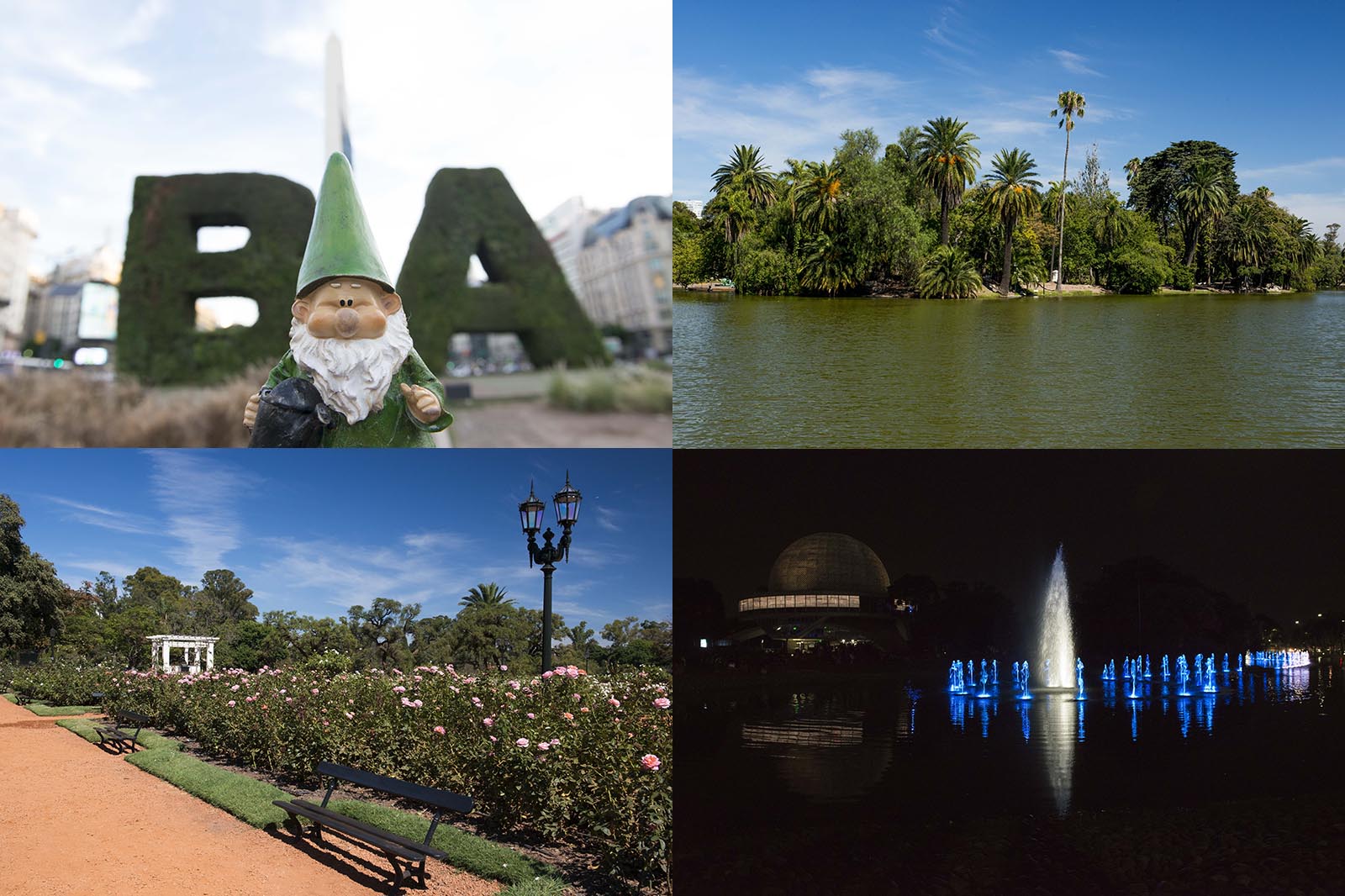 Clockwise from top left: Obelisco de Buenos Aires, Bosque de Palermo, Galileo Galilei planetarium at night and Paseo del Rosedal in Palermo.
Clockwise from top left: Obelisco de Buenos Aires, Bosque de Palermo, Galileo Galilei planetarium at night and Paseo del Rosedal in Palermo.
-
Museo de Arte Latino Americano (MALBA) focuses on Latin American art from the early 20th Century to the present. Highlights include Diego Rivera, Fernando Botero and Frida Kahlo. Be sure to visit on a Wednesday when admission is discounted and free for student and teachers. I got in free with my teacher’s ID from Texas.
-
Obelisco de Buenos Aires is one of the icons of the Buenos Aires. The monument was built in 1936 in honor of the 400th anniversary of the city’s founding. Located at the foot of the monument in Plaza de la República is the giant BA sign that’s Instagram-worthy!
-
Floralis Generica is a metal flower sculpture by Argentine architect Eduardo Catalano in Plaza de las Naciones Unidas. It also has purple lights that appear at night. It’s a fun picnic spot. FIGUEROA ALCORTA, PRES. AV. 2301, Free entry.
-
Jardín Botánico Carlos Thays (botanical gardens) is a peaceful escape from the city. Built by French landscape architect Carlos Thays, the green space includes over 1,500 plant species, Roman-style statues and a glass-domed greenhouse. Thays is also responsible for creating, remodeling and expanding 69 public spaces in the city.
-
Buenos Aires Ecological Reserve is the largest green space in the city. It’s a great place to rent a bike and explore. The 865-acre reserve lies east of Puerto Medaro on the bank of the Rio de la Plata. It’s packed with locals on weekends and a market by the south entrance. Free entry.
-
The Buenos Aires Metropolitan Cathedral is the main Catholic Church in the city center. Pope Francis used to perform mass here until he became Pope in 2013. It also houses a Pope Francis Museum. Entry to the cathedral is free.
- Free Walking Tour. There are several companies that offer free walking tours, and the guides work for tips only. This is a great way to get an idea of the city to start your trip.
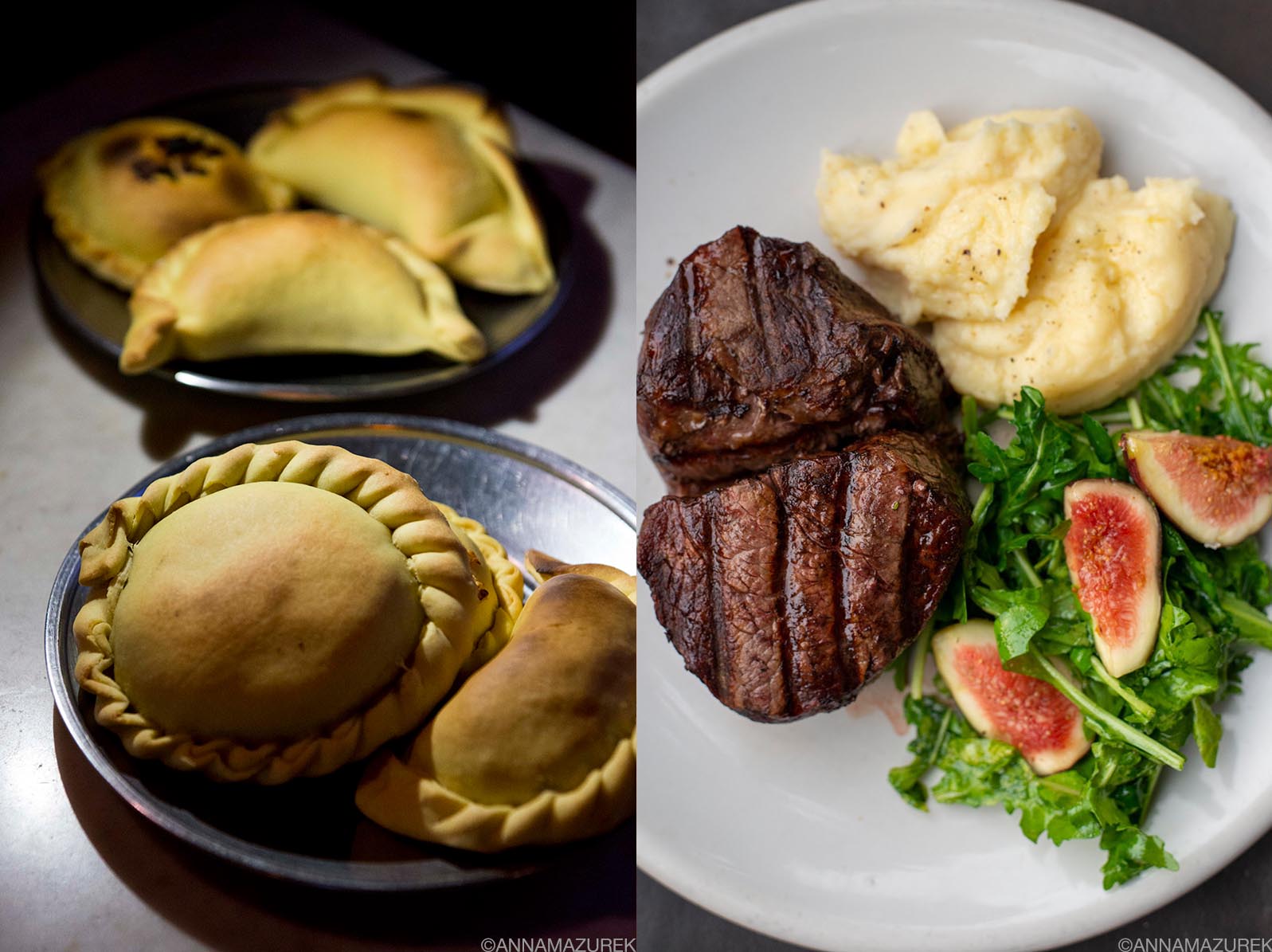 Left: Empanadas from La Cocina are the best in the city! Right: Steak from Don Julio, which was voted the best restaurant in Latin America in 2020
Left: Empanadas from La Cocina are the best in the city! Right: Steak from Don Julio, which was voted the best restaurant in Latin America in 2020
The Best Places to Eat in Buenos Aires
- Don Julio was voted the best restaurant in Latin America in 2020. The traditional Argentine steakhouse is the best steak in town. Reservations recommended.
- El Preferido de Palermo is a great dinner spot owned by the team behind Don Julio. Their milanesas (breaded meat cutlets) are delicious. Reservations recommended.
- La Cabrera is a Palermo parrilla (steakhouse) with a nightly happy hour from 6:30 to 8 p.m. Everything (steak, salad and even wine) is 40% off. The only catch is that you must be out before 8 p.m. when they start seating parties with reservations. Juicy steaks are served with an array of small sides ranging from pickles to purees.
- Casa Cavia is a lovely restaurant located in an old mansion with a leafy courtyard patio. It’s been my go-to brunch spot, but it’s also open for dinner. The homemade scones with dulce de leche are fantastic.
- Pain et Vin is my favorite wine shop/bar in Palermo. They serve light cheese plates but not proper meals.
- Usina and GOIN! are two Recoleta cafes I like for breakfast, lunch and an early dinner. (They close around 8 or 9 p.m., which is early for Argentine standards.)
- La Cocina has the best empanadas in town! This tiny hole in the wall has only 14 seats and plays classic rock music. I recommend the carne picante (beef), the pikachu (onion, cheese and red pepper flakes) and choclo (corn).
- L’Orangerie is located in the swanky Alvear Palace Hotel in Recoleta. This restaurant serves afternoon tea featuring a selection of miniature sandwiches, pastries and scones.
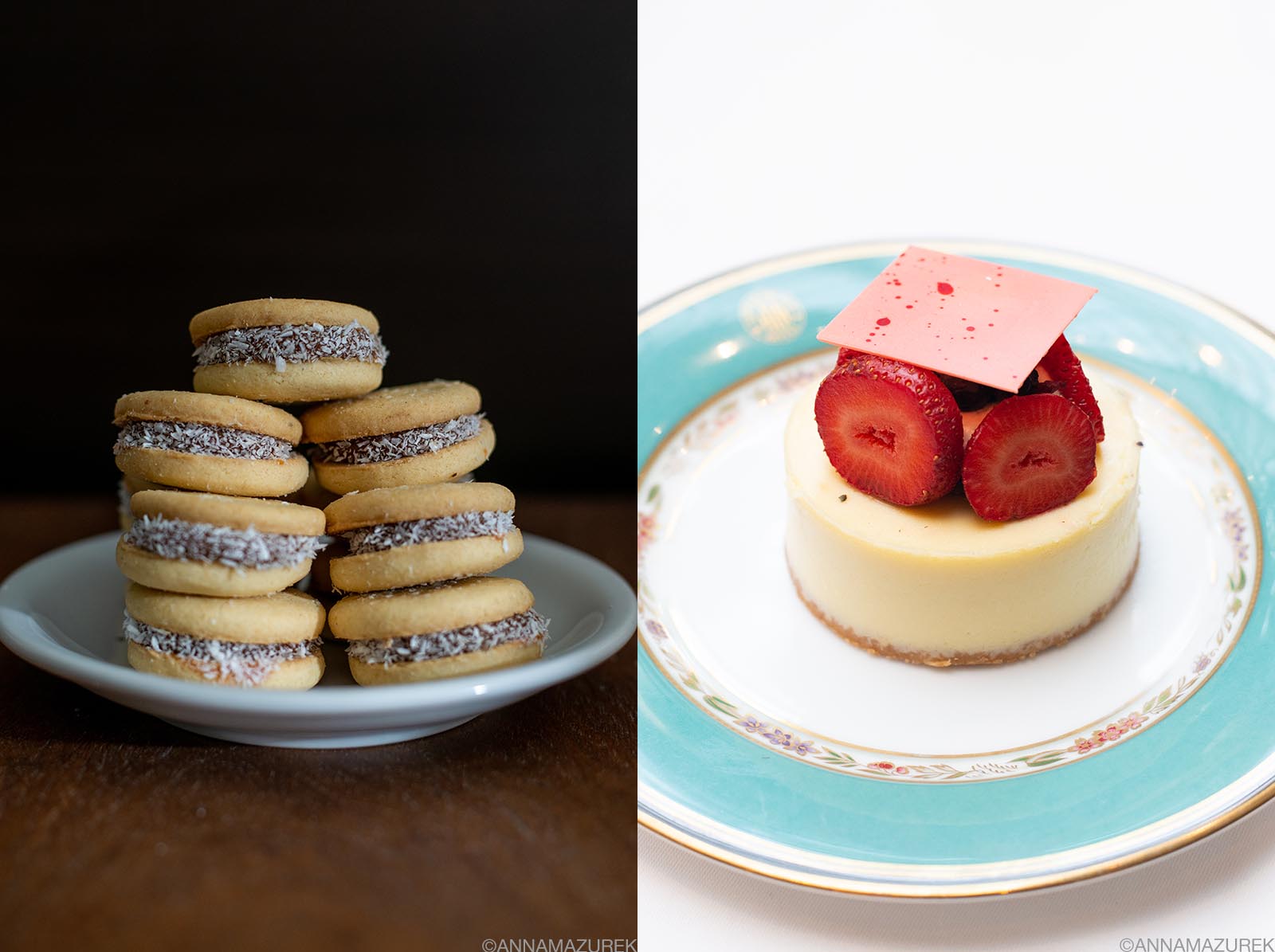 Left: Alfajores (dulce de leche with cornmeal cookies are available across the city); Right: Strawberry cheesecake from L’Orangerie at the Alvear Palace Hotel.
Left: Alfajores (dulce de leche with cornmeal cookies are available across the city); Right: Strawberry cheesecake from L’Orangerie at the Alvear Palace Hotel.
-
La Fachada has the best selection of empanada flavors in town including pumpkin (my favorite), pineapple (my second favorite) and Caprese. Their pizza also looks delicious. They have two locations so check their website for details and times.
-
Narda Comedor is a healthy eatery run by famous Argentine chef Narda Lepes, who was trained in France. There’s a nice patio and they spread the tables out into the park across the road during the daytime. Their mains are large portions and the panna cotta is delicious.
-
Croque Madame Café has a delicious array of cakes and quiches. There are multiple locations but the most scenic is the garden location at the Museum of Decorative Arts.
-
Lucciano’s is a family-owned ice cream chain that’s one of my favorite ice cream spots. The pomelo is my favorite flavor.
- For San Telmo, El Blanco Rojo, Bar Chin-Chin and Virrey Cocina Urbana were my go-to spots in 2018. They are still around, but I didn’t spend much time in San Telmo this trip.
The Best Craft Beer in Buenos Aires
Craft beer is slowly infiltrating the city. Many breweries have daily happy hours.
-
Buller Brewing is a brewery with an amazing rooftop patio overlooking Recoleta cemetery. Their beer, burgers and onion rings are fantastic.
-
Rabieta is probably my favorite microbrewery with nine of their own beers and other local brews on tap. You can’t beat the location on the horse racing track. Their patio is expansive, and they also serve bar food.
-
1516 Cerveceria in Palermo has a giant patio. On Tap serves 20 beers from local microbreweries and has several locations.
- Jugetes Perdidos never makes the same beer twice. You can find their beer in bars in town, but they don’t have a taproom. The brewery offers tours in their taproom every Saturday. Make reservations by calling or via Facebook Messenger. Tours are in Spanish, but they speak English if you have questions. Tour is free, but you pay for a beer and a complimentary glass. Bolivia 3342.
The Best Coffee in Buenos Aires
Since I don’t drink caffeine, I’m passing along recommendations from my coffee-loving friends. Santa Café is run by a Colombian couple so you know the coffee is good. It’s across from the Intercontinental Hotel. Everyone raves about their flat white. LAB is a great coffee spot with bar-style seating in Palermo that also has bagels. Coffee Town is a popular spot in San Telmo.
Where to Dance Tango in Buenos Aires
Taking at least one tango lesson is a requirement for any visit to Argentina. Aside from lessons, attend a milonga, a term that describes a type of music but is a common reference for a tango show. Many milongas have professional dancers perform throughout the night but have the dance floor open to the public otherwise. Here are a few regular spots that are still open:
- On Sunday nights, there’s usually outdoor tango at La Gloretia, a gazebo in Barrancas de Belgrano park.
- La Cathedral is the dive-bar equivalent of a milonga with the dance floor surrounded by mix-matched chairs that look like they came from a consignment shop. They offer lessons during the day have a milonga every night. It’s a great spot to go out on weekends and has a great vibe. The professional dancers are always amazing. They traditionally have two-for-one entry before 10 p.m. every night deal.
- Other options include La Viruta and Salon Canning, which is a more traditional venue with more of a dress code than other venues.
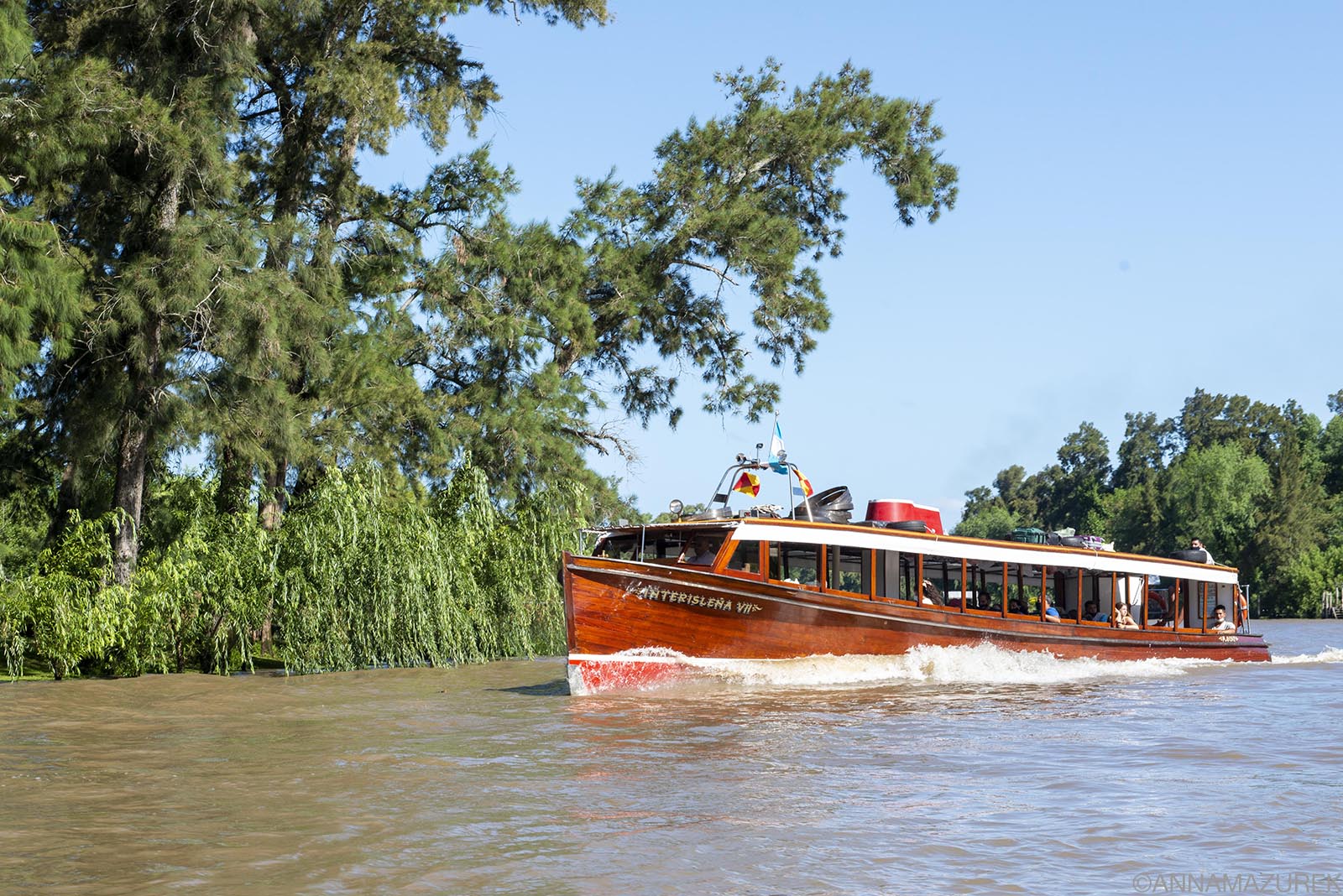 The waterways of Tigré, the gateway to the Paraná Delta located 18 miles north of the city, are a great day or weekend trip. Be sure to take a one-hour boat tour through the canals and residential parts of the delta.
The waterways of Tigré, the gateway to the Paraná Delta located 18 miles north of the city, are a great day or weekend trip. Be sure to take a one-hour boat tour through the canals and residential parts of the delta.
Day Trips from Buenos Aires
If you are looking to escape the city, there are several great day trips. You can do these on your own or book a group tour through GetYourGuide or Viator.
- Tigre is a series of scenic canals lined with vacation cottages that’s popular with locals. It is also known for its museums: Museo de Mate (famous loose leaf tea) and Museo de Arte de Tigre, an art museum dedicated to Argentine artists housed in a 1912 social club. It’s easily accessible by train from Retiro station. I recommend the more scenic Tren de la Costa and stopping at other stations along the way to explore the coast. It’s also easy to book day tours that take you by van and include the cost of the boat tour.
- La Plata is South America’s first completely planned city built on an elaborate grid famous for the towering neo-Gothic Cathedral and a natural history museum that’s touted as Argentina’s best museum. There is a direct train from Constitución station.
- San Antonio de Areco is a picturesque small town in the Pampas (lowlands area) known for gaucho (local skilled horseman) traditions.
- Colonia del Sacramento: Take the one-hour ferry to Uruguay to visit this peaceful postcard-perfect colonial town in Uruguay. Check out my guide to Colonia, here. (Uruguay is so amazing that you’ll fall in love instantly and want to stay for more than a weekend.) You can easily buy ferry tickets online.
Public Transport in Buenos Aires
-
Public transport. Buenos Aires has an extensive network of subway trains (Subte) and buses (Sube) that are both efficient and budget-friendly. You need a reusable Subte card, which you can buy at the stations.
-
Eco Bici The city offers a system of rental bikes around the city, which you can check out for an hour at a time. Tourists can sign up for the program and upload a copy of their passport and entry stamp.
- Ubers & Taxi. Uber exists in Buenos Aires, but it’s much slower than just grabbing a taxi off the street. Be sure to set your payment method to cash if taking an Uber. I find the regular taxis to be cheaper. I normally only use Uber when I don’t know how to explain in Spanish where I want to go. I normally give taxis cross streets to drop me off.
 The sleek skyscrapers of the city’s revitalized portside at Puerto Madero. The white bridge is El Puente de la Mujer (Women’s Bridge) is by Valencian architect Santiago Calatrava and it is one of the most famous landmarks in the area.
The sleek skyscrapers of the city’s revitalized portside at Puerto Madero. The white bridge is El Puente de la Mujer (Women’s Bridge) is by Valencian architect Santiago Calatrava and it is one of the most famous landmarks in the area.
Exchange Rates in Argentina: Is Buenos Aires a cheap place to travel?
Inflation has plagued the country for decades and is one of the highest in the world. In December 2023, it peaked at 25% but slowed to around 3.9% in August 2024. Annual inflation remains over 200 percent according to the Associated Press.
In the past, traveling with stacks of U.S. dollars to exchange was the only way to travel in Argentina. The country has long had a two-rate system—an official bank rate and an unofficial rate, known as the blue dollar. Over the years, the rates have fluctuated to being close to even to being drastically different. When the gap between the rates closes, it gets more expensive for anyone traveling with dollars.
As of November 2024, the official rate for U.S. dollars was 973 and the unofficial rate, known as blue dollar, was 1,140. (To give you an example of the inflation rates: In February 2022, it was 106 for the official rate and 209 for the blue dollar, which meant everything was half price for anyone traveling on dollars. When I was there in 2018, both the bank and blue dollar rate were almost even so I just used ATMs for cash.)
Can you use credit cards in Argentina and Buenos Aires?
Yes, travelers can now use credit cards in Argentina and get a “tourist dollar” rate that’s higher than the official bank rate. In December 2022, the country implemented a “foreign tourist dollar” program to give the MEP rate, (Mercado Electrónico de Pagos, which is the rate for investors buying in pesos and selling dollars) to travelers using credit cards (Mastercard and Visa only. ) This means you don’t have to travel around with giant stacks of cash like a drug dealer. Plus, this makes it easier to earn credit parts toward airline status. The MEP rate is not the same as the blue dollar rate but is higher than the official rate. (This website shows both rates, and The Buenos Aires Herald has a great story breaking down the different Argentinean dollar exchange rates.)
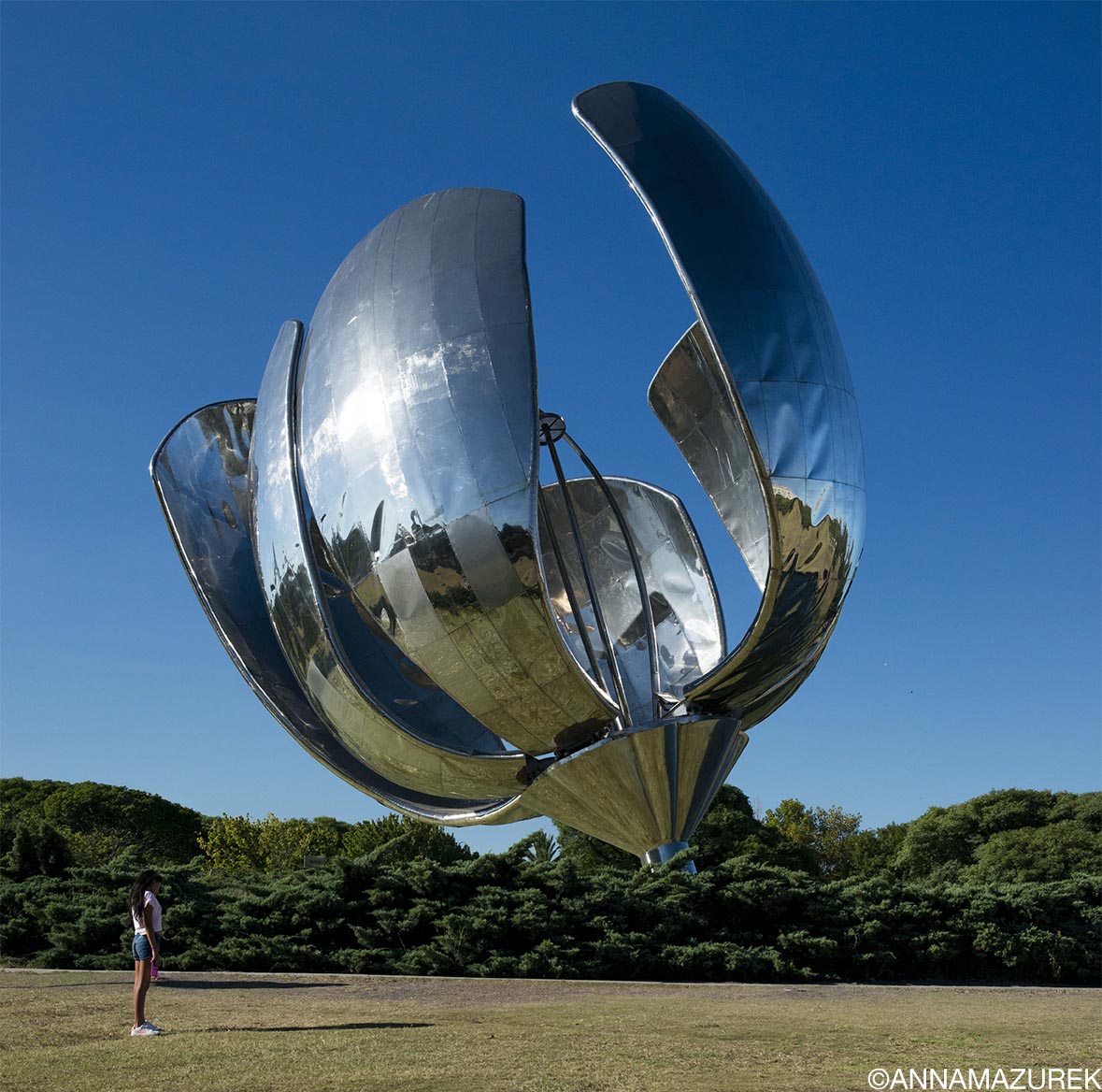 Floralis Genérica is an 18-ton alumiunum sculpture by Eduardo Catalano located in Plaza de las Naciones Unidas.
Floralis Genérica is an 18-ton alumiunum sculpture by Eduardo Catalano located in Plaza de las Naciones Unidas.
Where can you exchange money on the blue dollar rate in Buenos Aires?
If you are bringing U.S. dollars to exchange, make sure you have pristine (no marks or tears) $100 bills. In the past, I’ve used Enviarg Money Transfer, which has a location in Palermo Soho and two in Recoleta. I’ve never had to show a passport or ID to exchange money. I’ve only exchanged a max of $500 at one time. Since rates and regulations are constantly changing, be sure to ask the rate before any transaction.
Otherwise, there’s always Western Union. It’s best to send yourself money through their app (there are fees) because not every location exchanges cash. (This is a great option if you aren’t traveling with a ton of cash.)
Also, it can be tricky to find a Western Union branch that has the amount of money you need so you might be walking around for a while trying different branches. If you go this route, consider doing no more than $200.
While I’ve heard that counterfeits were an issue in the past, I’ve not had any issues. The only people who really look at the bills are store clerks.
Is it cheap to travel in Argentina now?
Argentina is still an affordable place to travel—especially if you are traveling on U.S. dollars—but more expensive than in previous years. This is due to inflation, austerity measures and the removal of public transport subsidies. The locals are the ones hurting the most with the high cost of living. (In early 2022, everything was half price because the blue dollar was so high. Long gone are the days of $37 steak dinners at the famous Don Julio!)
To make the most of your money, check rates before your trip to decide what’s best for you. It can’t hurt to have dollars with you.
Consider using cash to negotiate rates when you can. I’ve always paid cash for my apartments in Buenos Aires, which has enabled me to negotiate rates. The last time, I was able to get the price cut down by almost 30% from $1,400 USD to $950 USD for a spot in Recoleta!
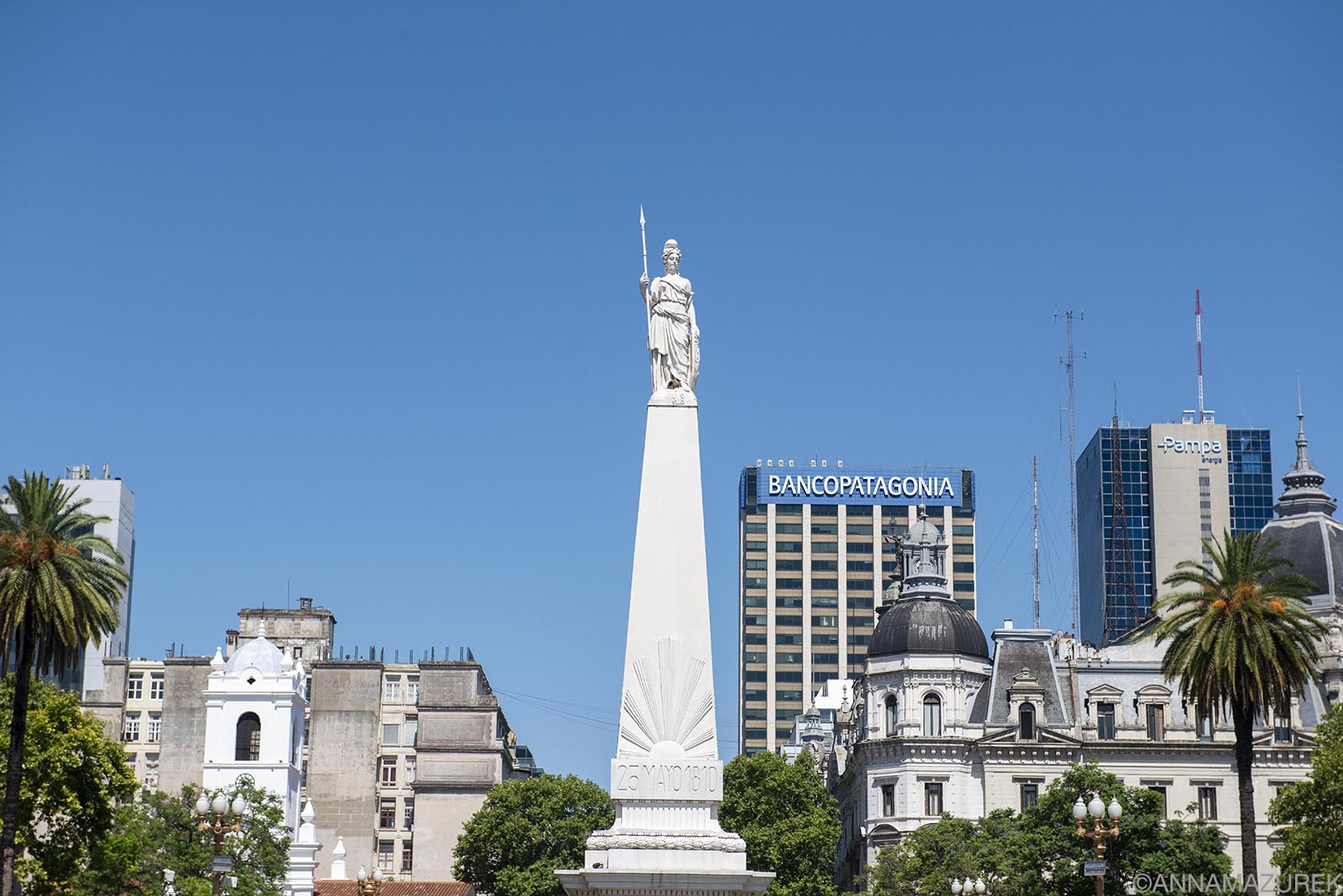 The white obelisk, Pirámide de Mayo, located in Plaza De Mayo, Buenos Aires’ oldest public square, was built to mark the first anniversary from Spain.[/caption]The white obelisk, Pirámide de Mayo, located in Plaza De Mayo, Buenos Aires’ oldest public square, was built to mark the first anniversary from Spain.
The white obelisk, Pirámide de Mayo, located in Plaza De Mayo, Buenos Aires’ oldest public square, was built to mark the first anniversary from Spain.[/caption]The white obelisk, Pirámide de Mayo, located in Plaza De Mayo, Buenos Aires’ oldest public square, was built to mark the first anniversary from Spain.
Is Buenos Aires Safe?
While the inflation is great for those with U.S. dollars, it’s a struggle for those without access. There are more homeless people and people trying to sell you socks and other random things while you are at dinner than there were on my previous trips. (To put it into perspective, the homeless situation in Austin, Texas is tremendously worse than what I’ve seen here lately.)
Petty theft is an issue in Buenos Aires. Watch your bags at all times. I always leave my purse strapped across my body at restaurants. I never put down bags either. (A friend of a friend had their backpack with their laptop swiped from a pub last week.) I don’t feel comfortable working at an outdoor café with my laptop. In 2015, someone tried to pick-pocket my phone out of my purse on the train, but I caught him and got my phone back. (I cornered him on the train and yelled at him until he dropped my phone. Otherwise, I would have jumped on him like a spider monkey.) I would avoid wearing fancy jewelry and Apple Watches.
I keep my passport and money locked in a safe in my apartment. I only take out the money that I need for the day. I also just work from my apartment, so I’m not taking my laptop out in public. When I have my camera, I keep it in my backpack most of the time and never walk around with it strung across my body. The La Boca area is one of the more dangerous ones for petty theft so be careful there. Also, be careful in San Telmo at night and Palermo really late at night.
Do you need travel medical insurance for Buenos Aires?
Yes, travel medical insurance is one of the most important things to purchase for any trip abroad, especially Thailand. It covers all the things that could go wrong from injuries to travel delays so that you don’t have to worry and can focus on traveling!
I use SafetyWing’s Nomad Insurance, which offers $0 deductible travel medical insurance coverage for over 180 countries for people aged 69 and under when traveling outside their home country. The best part is that it only costs a few dollars a day! If you get sick or injured abroad, you can visit any hospital or doctor.
Other benefits of Nomad Insurance include coverage for lost checked luggage, travel delays over 12 hours, motor accidents (if properly licensed, wearing all safety equipment and not intoxicated) and injuries from sports or leisure activities. You can even add adventure sports, electronics theft and U.S. coverage (for non-residents) to your policy.
If you’re abroad for 90 days, you can get 30 days of home-country coverage. (For the U.S. residents, it’s 15 days.) For more details about my experience using SafetyWing in Southeast Asia, read my SafetyWing Review.
Where’s the best place to buy a SIM card in Buenos Aires?
Buying a local SIM card in Argentina is tedious and time consuming because you have to buy it at a phone shop then add credit at a specific type of convenience store, which is hard to find. The easiest thing to do is buy an Argentina specific eSIM card from Airalo that will work instantly when you arrive. To save money, use these promo codes: New customers save 15% off with NEWTOAIRALO15 and existing users save 10% with AIRALOESIM10.
If you are traveling to multiple countries in South America on a short trip, then consider one of their Latin America Regional eSIM cards. Keep in mind it’s always cheaper to buy a country specific eSIM than a regional one.
Be sure to join the free Airalo Loyalty Program to earn 5% cash back for every purchase, which can be redeemed on future purchases! For more about eSIM cards, check out this post on the pros and cons of eSIMs!
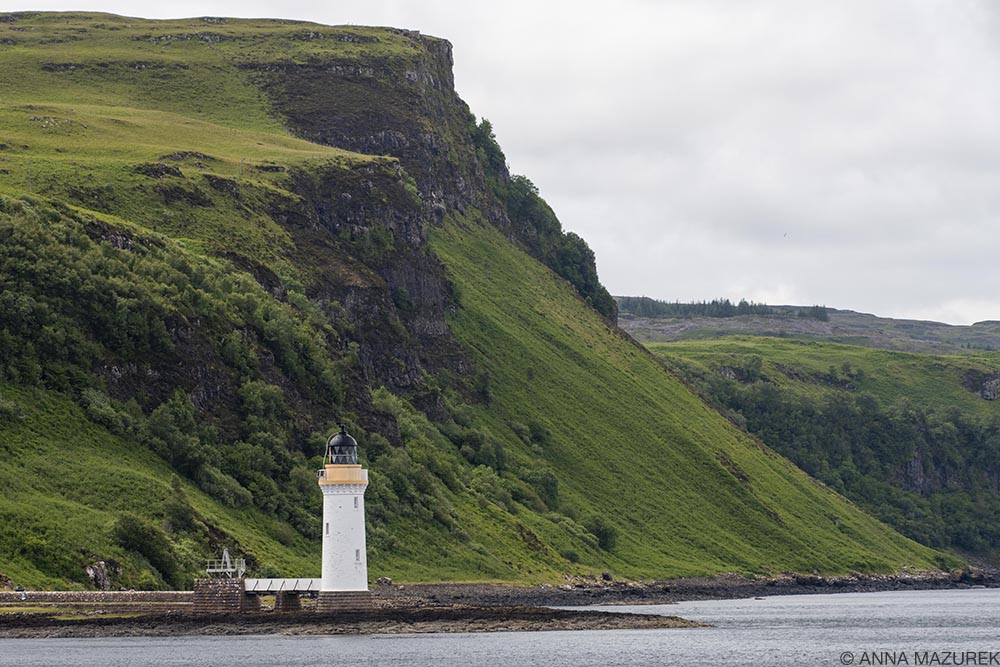
#ClaimYourAdventure with Flexible Travel Medical Insurance
 Tobermory Lighthouse on the Isle of Mull, Scotland.
Tobermory Lighthouse on the Isle of Mull, Scotland.
I live a very unconventional life—I travel most of the year for either work or fun. I am part vagabond, nomad and business traveler. Often, I’m gone for months and never quite know exactly when I’ll be flying back to the U.S. My life is a series of one-way flights, which makes it difficult to find flexible travel insurance since I never really know when my trip will end exactly. I’m a huge fan of SafetyWing’s flexible policies and monthly travel insurance options. They recently launched their new Nomad Insurance 2.0 with a lightning-fast claims process and new add-ons. Keep reading for the benefits of flexible travel insurance and #ClaimYourAdventure with SafetyWing!
Why do you need travel insurance?
Travel insurance covers all the worst-case scenarios—the flight delay that left you stranded in Istanbul for the night or the bout of food poisoning that hits a few hours before your flight home from Mongolia. Both are true stories from my travel adventures and not fun memories. I ALWAYS buy travel insurance for every trip, which only costs a few dollars a day no matter what brand you purchase.
Who is SafetyWing?
SafetyWing is a fully remote Norwegian startup based in California. It is run by nomads and expats providing insurance for budget travelers and nomads since 2018. (You don’t have to be a nomad or a budget traveler to use their insurance. It’s available to everyone under age 69.)
Why is flexible travel insurance important?
Travel requires a lot of planning, which can be exhausting. Thankfully, SafetyWing’s insurance policies help make things easier. Not all travel insurance companies cover one-way flights. If I don’t have a return flight booked, I always buy a recurring plan. SafetyWing offers reoccurring plans that renew monthly and can be stopped at any time. Then, the minute I get back in the U.S., I cancel the plan, and they provide a pro-rated refund. (Please note they currently offer U.S. coverage on plans for non-U.S. residents only. The reason I wait until I return to the U.S. to cancel is to ensure all my travel is completed with no delays.) SafetyWing’s customer service is 24/7, and you ALWAYS get a real human. It just takes a couple of minutes to cancel, and the refund shows up quickly.
If I know my set travel dates, I often just buy a policy for the entire time and pay upfront in full. I’m currently in Europe for three months mostly for work with a bit of personal travel. Since my travel dates are set, I paid in advance for the entire plan. If there’s even a chance I might extend my travel, then I’ll opt for a monthly travel insurance plan, which is what I’m doing for the fall. (In August, I’m heading to Asia for five months. I know I’ll be back in late February or March but will not book my return flight before I leave.)
Forget to buy travel insurance before you depart for your trip? One of the other great perks of SafetyWing policies is that you can buy it while you are traveling. Since I work for a travel company that covers me when I’m working. When I have a few days in between contracts, I’ll wait to buy policies until the eleventh hour. They offer same-day start dates. You can even buy policies if you’re already abroad and don’t know exactly where you are traveling.
SafetyWing Travel Insurance Options
SafetyWing offers two different times of travel insurance with global coverage. Their Nomad Insurance is travel medical insurance for people outside their home country. They recently added policy add-ons for extra coverage options include adventure sports coverage, electronics theft, and U.S. coverage (for non-U.S. citizens or residents). (U.S. residents do get 15 days of home country coverage for every 90 days of travel abroad as part of the policy without this add-on.)
One of the best benefits of SafetyWing is that they have 24/7 customer support with a REAL human! (I can vouch that they are excellent at assisting and will follow up with you afterward!) Check out the full details here!
What does SafetyWing Nomad Insurance 2.0 cover?
While it’s important to always read the full insurance policy, these are covered by SafetyWing. Each policy has a $250,000 USD max limit and a $100,000 USD max limit for US residents over 65.
- Emergency Accident & Sickness Expenses.
- Emergency Evacuation & Repatriation. (Evacuation to a better-equipped hospital when needed is included with a $100,000 USD lifetime max.)
- Trip Cancelation, Delay or Interruption. (Benefits kick in usually for delays after 12 hours. $100/day for two days)
- Baggage Delay & Damage. ($500/item with a $3,000 policy maximum)
- Injuries from leisure sports and activities.
- Motor Accidents. You must be properly licensed, not intoxicated and wearing safety equipment to be covered.($250,000 US max limit)
- Continued coverage in your home country after 90 days abroad. (30 days for non-U.S. residents and 15 for U.S. residents.)
- For more details, read the full policy on their website.
What’s not covered?
SafetyWing doesn’t cover pre-existing conditions, cancer treatment, lost or stolen personal belongings, trips that were canceled before you left and high-risk or professional sports activities.
Purchasing Process with SafetyWing
It just takes minutes to fill out the form online including your age, home address and countries you’ll be visiting. Their chat box makes it easy to ask questions and talk to a real human 24/7 within minutes. Their customer service can easily answer any questions quickly. They are also great about following up when needed. You can pay monthly or in full for policies. You can even set policies to auto-renew. When you cancel a policy you’ve paid for, they will give you a pro-rated refund.
How do you file a claim with SafetyWing’s Nomad Insurance 2.0?
Filing a travel medical insurance claim may feel overwhelming but it doesn’t have to be thanks to SafetyWing’s new Nomad Insurance claims. Fill out the simple new form in as little as five minutes and get reimbursed within 2.8 days!
- Type of Claim: Choose medical or non-medical claims (stolen electronics, travel delays, natural disaster evacuation)
- Medical Information: For medical claims, enter the location, date of service and total cost for the claim. The next two questions ask about preexisting conditions and if you’re covered by any other form of insurance.
- Personal Information: Enter your contact information and passport number
- Reimbursement: Add your bank account details and how you’d like to be paid for the claim.
- Upload Documents: This is one of the most important sections so be sure to have all of your documentation together before you leave the doctor’s office. A copy of your medical report (doctor’s notes about your symptoms, diagnosis and treatment.) Invoices and receipts to show the breakdown of the cost of the bill are also required. I recommend using the free Genius Scan app to make a PDF that can be exported easily.
- Review and Submit: Check over the information you have entered to ensure it is correct, especially your bank account information. This ensures the claim can be paid ASAP! You can always check your claim status anytime on the website.
If you have any questions about claims or buying a policy, SafetyWing’s 24/7 support can connect you with a REAL human instantly!
*Please note that some affiliate links are used in this post. If you make a purchase, I earn a small commission at no cost to you, which goes toward the cost of maintaining this blog. If you would like to support this blog and are ready to make a purchase, these links are one way to show your support. I only recommend products and companies I truly love and use. Please email me with any questions.
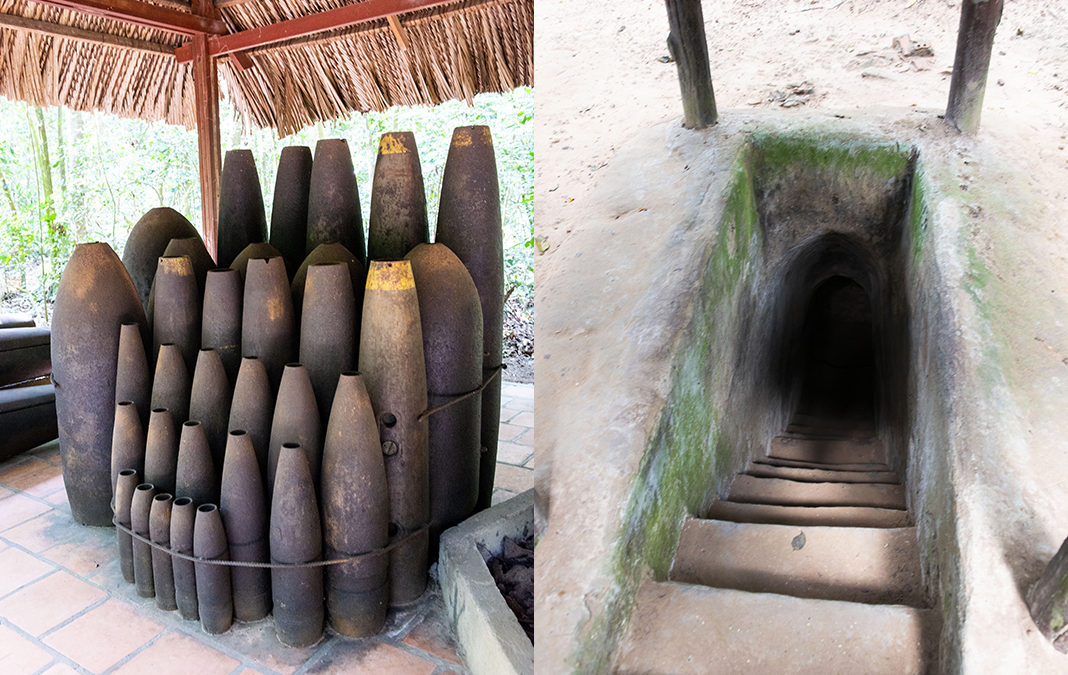
How to get to the Cu Chi Tunnels (Ben Douc) by Public Bus

(Please note this post was written in 2019 but some readers just did this trip in June 2024 and confirmed the bus numbers and route are the same!)
Why visit the Cu Chi Tunnels?
Cu Chi is a rural area about 30 to 40 km from Ho Chi Min that’s famous for a legendary spiderweb of tunnels used in the 1960s by the Viet Cong to control the area during the Vietnam War. There are two sets of tunnels: Ben Dinh and Ben Duoc. Ben Dinh is the most touristy one because it’s easier for tour buses to reach it. Ben Duoc is the best one in my opinion because it’s not touristy. There were only a handful of people when we went.
(I’ve found conflicting sources that state that Ben Dinh was constructed only for tourists and Ben Douc is part of the real tunnel network. I can’t find a reliable source to verify this. Lonely Planet says that Ben Douc was widened for tourists but is less touristy. (There are stairs going into some of the tunnels, which clearly can’t be original.) Once you are inside the tunnels, they are pretty tight!
While it’s easy to find tours to visit Ben Dinh, there aren’t many tours going to Ben Douc. I recommend taking the public buses (they have air conditioning!) to Ben Douc for a more authentic experience without the crowds!
Logistics:
Time: 6-8 hours
Total Cost:$5.15 USD
Bus – 32,000 dong roundtrip ($1.37 USD)
Entrance fee – 90,000 dong ($3.78 USD)
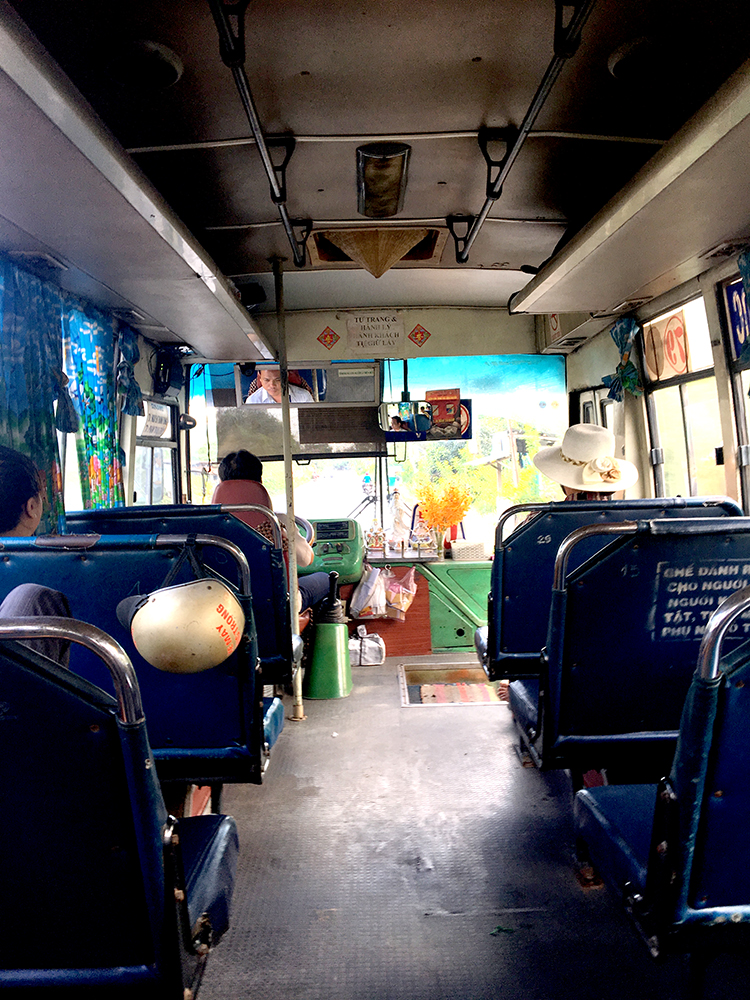
Bus Route to Ben Douc Tunnel From Ho Chi Minh City
First, take Bus 13 from Ho Chi Minh (Cong Vien 23/9 bus terminal in District 1). This station is just past the September 23rd park. It’s large so you can’t miss it so keep walking if you don’t see it yet. Here’s the address on Google Maps: 210Bis/, 7 Nguyễn Trãi, Phường Phạm Ngũ Lão, Quận 1, Hồ Chí Minh, Vietnam.
Take the bus to the end of the line, which is the suburban district of Cu Chi. Depending on traffic, it can take 1.5-2 hours. (Cost: 10,000 dong each way)
From Cu Chi, take Bus 79. Ask the driver to let you off at Ben Douc. (There will likely be a few other travelers on the bus so you won’t be alone. Plus, the driver knows that’s where all the foreigners are going.) This takes about 30-45 minutes. (Cost: 6,000 dong each way.)
Both buses had air conditioning! The total cost of both buses was $1.37 USD.
From the bus stop, follow the signs to the entrance. You’ll have to walk a little further to where the tour starts. The entrance fee is 90,000 dong ($3.78 USD). This is a really short walk – 10 minutes or so.
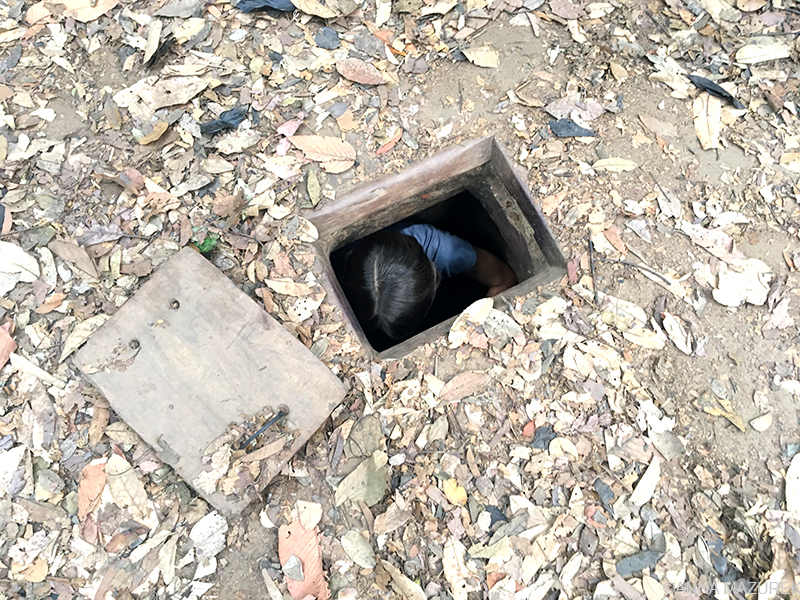
Ben Douc Tour Information
We did an English tour, and there were about 10 people on our tour. The tour follows a trail through the woods so it’s an easy walk to the different tunnels and displays. First, they show you a propaganda video. There are a lot of displays of the traps and models of how various rooms were used in the tunnels. The first tunnel is really short but worth doing. There are a few other tunnels you can go through and a 30-meter-long one at the end. If you’re claustrophobic, avoid the long one. The tunnels are tight – you’re hunched over most of the time. My backpack was in the way a bit, but the guide said not to leave it outside for safety reasons.
By the bus stops, there are a few small shops and a restaurant by the entrance. (Bring water and snacks with you since prices are higher here!) There are technically two roads to the entrance. We got dropped off at the farther entrance and walked back to the lower entrance. (See map at bottom of the post.) There are several old helicopters and tanks near this entrance on display. We only waited about 10 minutes for the return bus. I heard the last bus was around 7 p.m. but can’t verify that. Be sure to ask when you get off the bus!
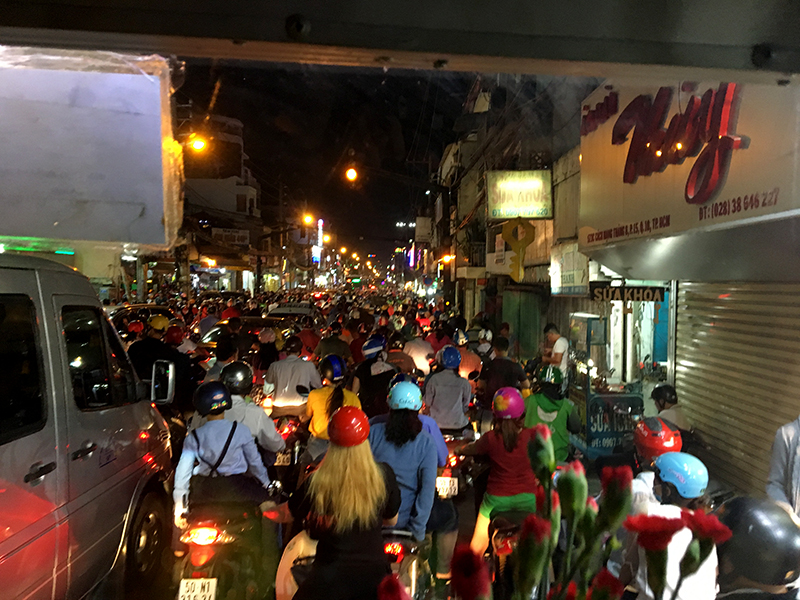
How long does it take to get to the Chu Chi Tunnels from Ho Chi Minh City?
We left about 10 a.m. and got back around 5-6 p.m. We got stuck in the worst traffic I’ve ever seen in my life on our way back. We sat still for about 30-45 minutes. We thought about walking but motorbikes were driving on the sidewalk so there was no point in trying to walk! (Check out the video in my Instagram story on Vietnam to see it!) I’d recommend going earlier in the day and getting back earlier.
Overall, it was one of the best days I had in Vietnam. It was a great way to escape the chaos of HCMC and avoid the mainstream tourist trail. It felt like a much more authentic visit. Plus, the bus was fun and a great way to see the area!

Download Offline Maps
I recommend downloading the free Maps.me app and saving the Vietnam map offline. I marked the Ben Douc tunnels on the map and followed our route so I knew when to get off. As long as you load the map BEFORE you start the trip, then it will still update even if you don’t have service. (The driver made sure to tell us where to get off. You won’t miss the stop even if you don’t have it on your phone because the driver’s are looking out for you!)
For more information about Vietnam, check out my guide about the best places to visit in Vietnam!
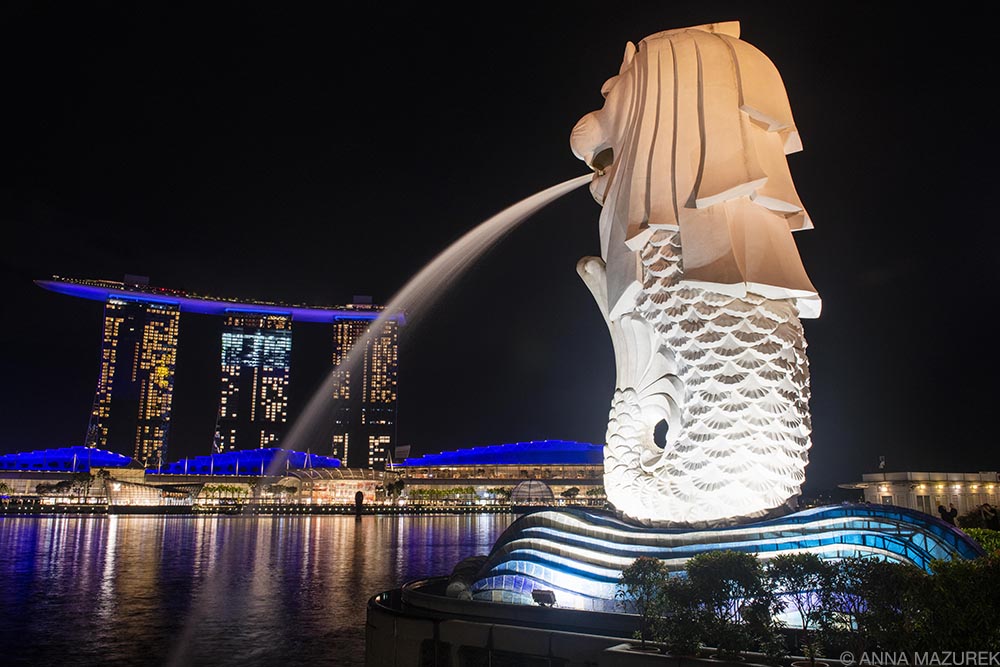
Best Things to Do in Singapore
 The iconic 8.6-meter Merlion statue is an icon of the Singapore skyline along with the Marina Bay Sands hotel across the bay.
The iconic 8.6-meter Merlion statue is an icon of the Singapore skyline along with the Marina Bay Sands hotel across the bay.
Why visit Singapore?
Singapore is a sleek tropical metropolis of high-rise buildings, shaded walkways and spotless public transport with elevators and escalators at each stop. It is essentially the New York City of Asia, except that it’s safer, cleaner and more efficient to explore than the Big Apple. Unlike NYC, every single train station has elevators and escalators to ALL platforms—a traveler’s dream! (Can you tell I have PTSD from dragging my suitcase up endless stairs in the NYC subway?) After a decade of visiting, I decided it was time to write my own post about things to do in Singapore.
Affiliate links are used in this post. If you make a purchase, I earn a small commission at no cost to you, which goes toward the cost of maintaining this blog.
Is Singapore a Country?
Yes, Singapore is a country and city-state in Southeast Asia. It declared independence from Malaysia on August 9, 1965.
The former British colony is a cultural melting pot with an ethnolinguistic population comprised of 75% Chinese followed by Malays and Indians. While the constitution lists four main languages (English, Malay, Tamil and Mandarin), everyone speaks English, and many locals speak two or more languages. This cultural fusion also means the food is top-notch. (Hello dim sum!)
One of the big surprises about this island nation is the amount of greenspace—47% of Singapore is parks and gardens. The public transport is efficient and affordable making exploration a breeze. Singapore is impeccably clean and extremely safe. It’s the only country in Southeast Asia where you can drink tap water!
While Singapore has a reputation for being expensive, there are plenty of ways to explore the city-state without draining your bank account. It also has the nicest airport in the world so it’s a great place for a short visit to break up a long journey!
I’ve been to Singapore over a dozen times in the last decade and visit at least once a year. (I was just there a few weeks ago!) Scroll down for my Singapore travel guide including a section on the best things to do in Singapore without breaking the bank.
Plan Your Trip
Currency: Singapore Dollar (SGD)
When to Go: Anytime. The climate is fairly consistent (hot with a chance of rain) but June and July are often the hottest months.
Travel Insurance: Protect yourself with SafetyWing travel medical insurance to cover accidents and travel delays.
Mobile eSIM Card: Get seamless connectivity worldwide with Airalo minus the hassle of physical SIM card.
The Best Free Things to do in Singapore on a Budget
 There’s a free light and sound show nightly in the Supertree Grove at Gardens by the Bay in Singapore.
There’s a free light and sound show nightly in the Supertree Grove at Gardens by the Bay in Singapore.
Merlion Park is home to the country’s unofficial mascot, an 8.6-meter-tall white statue of a Merlion, a creature with the head of a lion and the body of a fish, that doubles as a fountain. (Legend says an Indonesian prince came ashore and thought he saw a lion.) The name Singapore means “Lion City” in Sanskrit. It’s a great place to get photos of the skyline and Marina Bay Sands.
Gardens By the Bay is a must-visit green space comprised of three gardens and the famous Supertree Grove of metal tree-like structures that serve as vertical gardens. (While the gardens themselves are free, the two indoor gardens and the short walkway in the Supertree canopy are paid.) Stop by for one of the free sound and light shows, known as Garden Rhapsody, nightly at 7:45 and 8:45 p.m.
Marina Bay Sands is a three-towered hotel with a large cruise-ship-shaped structure spanning the top of the building, which looks like it belongs on the Vegas Strip. You can walk through the hotel at any time and most likely will have to in order to reach the Gardens by the Bay. It’s worth a splurge to have a drink on the rooftop bar for the view. There is also an attached mall.
 The colorful Hindu Sri Mariamman Temple, left, and teh Lian Shan Shuang Lin Monastery in Singapore are both free to visit.
The colorful Hindu Sri Mariamman Temple, left, and teh Lian Shan Shuang Lin Monastery in Singapore are both free to visit.
Stroll through Chinatown and stop at the photogenic Buddha Tooth Relic Temple and Museum and the colorful Sri Mariamman Temple, the country’s oldest Hindu temple built in 1872. The Lian Shan Shuang Lin Monastery is a beautiful Buddhist temple complex located away from downtown and the central tourist areas.
Haw Par Villa is a Buddhist hell park. Yes, you read that right. It’s a unique, interesting and slightly scary outdoor theme park with over a 1,000 statues. Admission is free.
Mustaffa is a six-story mall in Little India filled with literally everything imaginable. It’s an eye-opening experience to walk around the complex.
The Jewel at Changi Airport is home to the world’s largest indoor waterfall, the HSBC Rain Vortex. Located before airport security, The Jewel is a shopping mall portion of the airport connected by trains or walkways to the terminals.
 The Peranakan terrace houses on Jooh Chiat Road, left, and the Singapore Botanic Gardens, right, are two of the best photography spots in Singapore. Both are free to visit.
The Peranakan terrace houses on Jooh Chiat Road, left, and the Singapore Botanic Gardens, right, are two of the best photography spots in Singapore. Both are free to visit.
The Peranakan terrace houses on Joo Chiat Road are a series of colorful historic shophouses. (The term “Peranakan” is often used to refer to someone with both Chinese and Malay origins.) These homes are privately owned and not open to the public. For the best photos, visit in the morning. (Set your Google Maps to 19 Koon Seng Road or 287 Joo Chiat Road, which are both in the same block.)
Singapore Botanic Gardens is a UNESCO World Heritage site that’s home to the National Orchid Garden. (I got dragged here by a South African boy I had a crush on back in 2013 who loved orchids and was surprised at how lovely it was!)
Haji Lane is one of the country’s narrowest and most colorful streets filled with shops and restaurants. It’s a great photo spot.
The Best Parks, Walks and Nature Reserves in Singapore
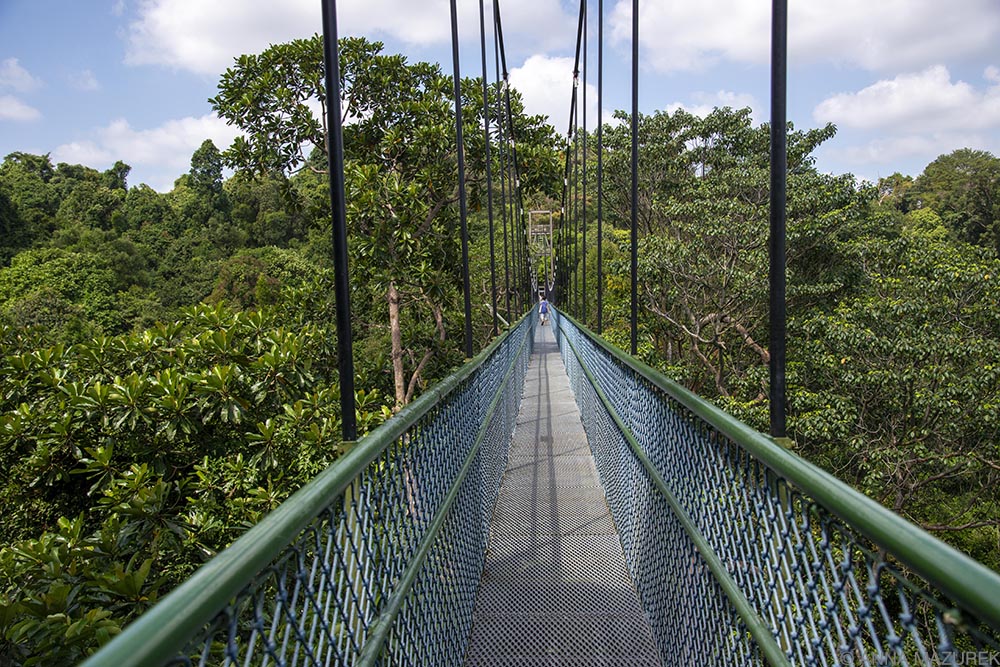 The TreeTop walk at MacRitchie Reservior is located in Central Catchment Nature Reserve, one of Singapore’s four nature reserves.
The TreeTop walk at MacRitchie Reservior is located in Central Catchment Nature Reserve, one of Singapore’s four nature reserves.
I love walking through Singapore’s plethora of parks and nature trails. (Over 47% of the island is green space!) Set out early to beat the heat. All of these trails are easily accessible from public transport.
Central Catchment Nature Reserve is home to the MacRitchie Reservoir, the largest in Singapore, and home of the famous Treetop Walk featuring a 25-meter suspension bridge and over 20 kilometers of trails.
The Southern Ridges is a 10-kilometer trail with a series of bridges including Henderson Waves, the highest bridge in the country and a series of bridges making up the forest and canopy walk. It’s best to start the trail at the Harbour Front MRT station so the final portion is downhill. Here is a map.
Fort Canning Park was home to the country’s first rulers due to its hill-top location. It later became the site of the British Government, a fort and the first botanic garden. Take a self-guided walk of the main attractions including nine historical gardens, sculptures and a Fort Gate, the only remains of the colonial fort. Instagramers will love the Fort Canning Tree Tunnel—be prepared to line up if you want a shot.
Since there are 350 parks and even more greenspaces, I can’t name them all. A few other notable ones are Labrador Nature Reserve and Bukit Timah Nature Reserve. Both are free and easily accessible by public transport. For more details on parks, visit https://www.nparks.gov.sg.
The Best Beaches in Singapore
 Sentosa Island is Singapore’s more popular beach destination with three man-made beaches (Siloso Beach, Palawan Beach, and Tanjong Beach).
Sentosa Island is Singapore’s more popular beach destination with three man-made beaches (Siloso Beach, Palawan Beach, and Tanjong Beach).
Fun fact: The majority of the beaches in Singapore are manmade. One of the most popular beach destinations is the island resort of Sentosa, which is home to Universal Studios and the aquarium. For those looking to avoid Sentosa, the next best option is Changi Beach, a narrow strip of white sand in Eastern Singapore that doubles as a park with running and cycling lanes.
The Best Museums in Singapore
Singapore has some excellent museums, but they are not free for foreigners except on special occasions during festivals and large events. I particularly enjoyed the Peranakan Museum, which digs into the culture of Southeast Asia’s Peranakan communities. I really think it’s a must-visit in terms of understanding the culture. The National Museum of Singapore, founded in 1849, is another great spot. (FYI: I don’t like zoos or theme parks, so you’ll never see those in one of my blog posts. Singapore has both.)
Where to Stay in Singapore

There is a free nightly light, water and sound show outside Marina Bay Sands that lasts 15 minutes. Shows are at 8 p.m. & 9 p.m. daily with an additional show at 10 p.m. on Friday and Saturday. Check out details here.
Accommodation is where Singapore gets expensive. The cheapest areas are Little India, Chinatown and Joo Chiat. Hostels will run around $30-40 SGD ($22-29/USD) and hotels will start around $200 SGD ($148 USD). I’ve most often stayed with friends, and the hostels I’ve tried haven’t been not worthy of mentioning.
For Singapore hotels, I really like 30 Bencoolen—it’s a modern, safe and clean hotel just steps from the Bencoolen MRT. (Plus, it has a pool, gym and laundry machines.) I really love the location of 30 Bencoolen because it’s only a 20–30-minute walk to Chinatown or downtown.
If you’re looking to splurge or cash in points for a luxury stay, then the most iconic hotels are Raffles Singapore, Fullerton Bay Hotel and Marina Bay Sands.
The Best Places to Eat in Singapore
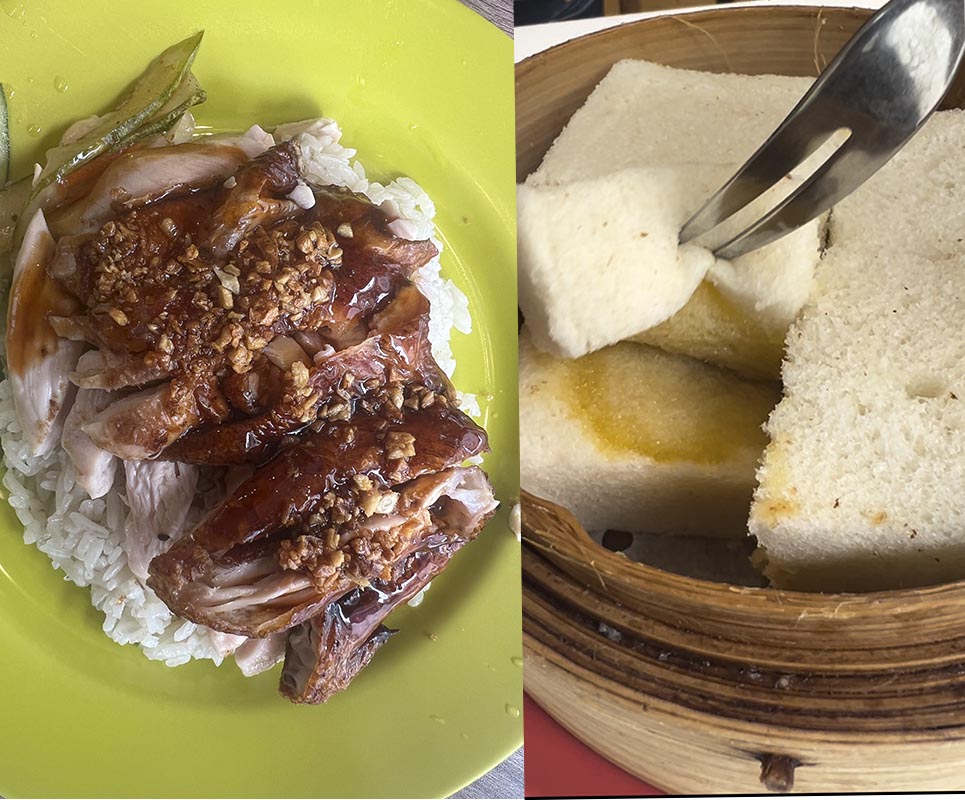 Chicken rice, left, and kaya toast, right, are must-try Singaporean classics.
Chicken rice, left, and kaya toast, right, are must-try Singaporean classics.
The cheapest places to eat in Singapore are hawker centers, a mixture of a community center and a food court wrapped into one. Classic Singapore dishes available at most hawker centers include Hainanese chicken rice (poached chicken with seasoned rice), kaya toast (toast with kaya, a coconut jam made with pandan), carrot cake (a radish omelet fried with garlic and no carrots), Laksa (spice noodle soup usually made with seafood).
Here are my favorite spots to eat in Singapore:
- Ya Yun Kaya Toast serves up a steamed rendition of a Singaporean classic—kaya toast—and other breakfast treats.
- Swee Choon Tim Sum Restaurant is my favorite dim sum spot. It’s huge, but there’s always a line that moves quickly. Cash only.
- Tiong Bahru Bakery is a French-style bakery for breakfast and lunch specializing in homemade croissants. Their granola is also tasty. There are multiple locations, but I really like the patio at the Fort Canning Park location.
- Tim Ho Wan is a Hong Kong chain, but their barbecue pork bao is some of the best. Skip the long line to eat inside and order from the to-go window.
- Chinatown Complex Food Center and the Maxwell Food Center are two well-known hawker centers in the Chinatown area.
The Best Craft Beer Bars in Singapore
Singapore has a bustling craft beer scene. Alcohol is not cheap in Singapore so seek out Happy Hours for a good discount. Beer is normally $16+ SGD ($12 USD) outside of happy hour. Consider buying any booze you’d like, including craft beer, from duty free at the airport. Here are my favorite spots to grab a pint:
- The Beer People Co. is a fairly new watering hole that has over 150+ bottles and cans of craft beer with a large selection of both local and Asian beers. They have happy hour and also serve up Thai food. It’s currently my favorite spot!
- Smith Street Taps is a 20-tap craft beer stall in the Chinatown Complex Food Center. It’s on the second floor of the open-air hawker center and feels like you’re drinking beer in a parking garage with a dive bar vibe that I love. It’s a must-visit opened by two of the countries craft beer pioneers.
- Tap has the cheapest craft beer in town with a $7-8 USD price range on 20 different taps. They serve food and have three locations.
- Druggists is a hip bar and eatery with a good variety of craft beer but a bit more pricey than the other locations mentioned.
Singapore FAQ
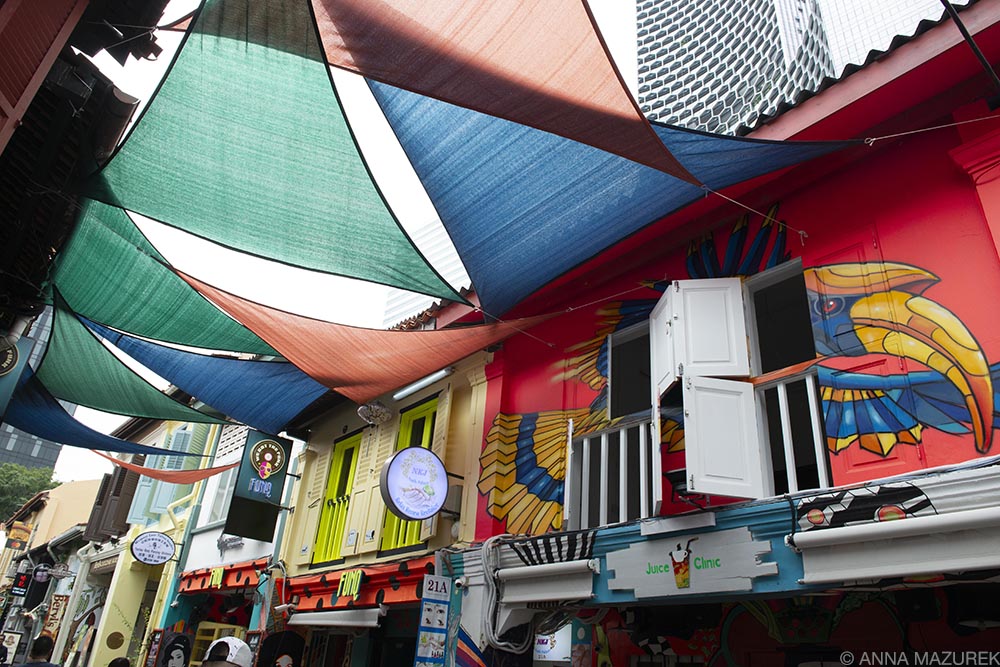 Colorful Haji Lane is a great shopping and dining hotspot in Singapore. It’s all next to the Sultan Mosque that’s open to visitors.
Colorful Haji Lane is a great shopping and dining hotspot in Singapore. It’s all next to the Sultan Mosque that’s open to visitors.
Do you need travel medical insurance for Singapore?
Yes, travel medical insurance is one of the most important things to purchase for any trip abroad. It covers all the things that could go wrong from injuries to travel delays so that you don’t have to worry and can focus on traveling!
I use SafetyWing’s Nomad Insurance, travel medical insurance coverage (with no deductible) for over 180 countries for people aged 69 and under when traveling outside their home country. The best part is that it only costs a few dollars a day! If you get sick or injured abroad, you can visit any hospital or doctor.
Other benefits of Nomad Insurance include coverage for lost checked luggage, travel delays over 12 hours, motor accidents (if properly licensed, wearing all safety equipment and not intoxicated) and injuries from sports or leisure activities. You can even add adventure sports, electronics theft and U.S. coverage (for non-residents) to your policy.
Does Singapore have public transport?
Singapore has an excellent public transport network of underground trains (MRT) and buses. You can get anywhere in the city in roughly 30 minutes, except the airport or the far west of the island. MRT fare is $1-3 USD a ride. (It cost me $2 USD from the airport to the Bencoolen MRT stop.) Simply use a contactless bank card to tap and go to avoid standing in queues. You can also buy passes.
Does Singapore have Uber?
No, there are taxis and Grab, the dominant rideshare company in Southeast Asia that works the same as Uber.
What is the cheapest place to get a SIM card in Singapore?
Avoid buying an overpriced SIM card at the Singapore airport, which ranges from $30-50 SGD ($22-37 USD!!!). Consider buying an e-sim from Airalo that will work instantly upon arrival. If your phone doesn’t have eSIM, then go into a 7-Eleven in town and buy one at a fraction of the cost ($14 SGD/$10 USD). Yes, e-SIM cards will work in Singapore, but you’ll likely have to buy a regional package through Airalo instead of an individual country.
For more, check out my guide to the Pros & Cons of eSIM cards!
How many days do you need in Singapore?
Give yourself two days to explore the marina and Chinatown and another if you want to visit any of the greenspaces. It’s easy to fill up a week if your budget can afford it. Singapore’s Changi Airport is the nicest airport in the world, so it’s a great stopover point to break up a long journey!
Is chewing gum illegal in Singapore?
Yes, chewing gum is banned in Singapore. Why? When the public trains system was first implemented, kids were putting gum on the door sensors which made the trains inoperable, which led the government to outlaw gum among other cleanliness concerns. While this might seem like an extreme reaction, it means the sidewalks are SPOTLESS—no nasty gum splotches anywhere. I think it’s the cleanest city in the world. Check out this BBC story for more details.
Does Singapore have strict laws?
When you land in Singapore, the pilot makes an announcement and says the penalty for drug trafficking can be death. Just don’t break their laws—which are standard worldwide laws because you should NOT be doing illegal things anyways—and you’ll be fine. To avoid fines, avoid littering, jaywalking, spitting and urinating in public.
Can you drink alcohol in public in Singapore?
Yes, you can drink alcohol in public places depending on the time. Drinking alcohol in public in Singapore is not allowed between 10:30 p.m. and 7 a.m. after a riot in Little India in 2013. There are additional restrictions in specific parts of town on weekends. For more details, check out this news story.

Antarctica Cruise Packing List
 Icebergs in the Gerlache Strait at sunset in Antarctica.
Icebergs in the Gerlache Strait at sunset in Antarctica.
Antarctica is the ultimate adventure—the wildlife and scenery are unbelievable. Deciding what to pack for an Antarctica trip is almost as important as when you go.
If you’ve got an Antarctica cruise coming up or are looking at booking one, here is a complete Antarctica cruise packing list. From boots to gloves, I’ve compiled a detailed list of what to pack for Antarctica. (For a little pre-trip inspiration, check out my Antarctica photo post with images of the month I spend there for work.)
Affiliate links are used in this post. If you make a purchase, I earn a small commission at no cost to you, which goes toward the cost of maintaining this blog.
What to Pack for an Antarctica Cruise
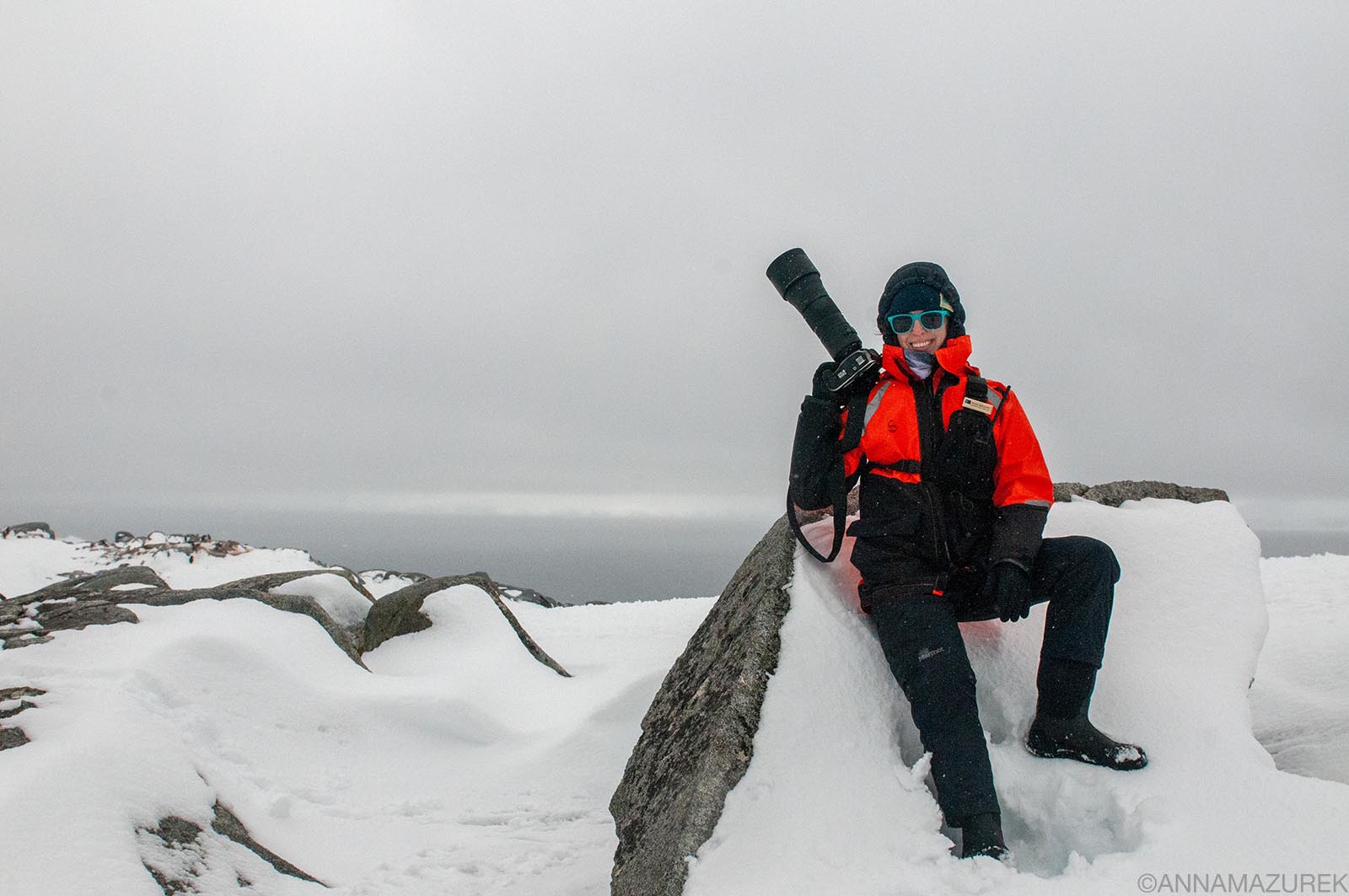 I’m wearing a float coat in this photo, which doubles as a life jacket. Underneath, I’ve got on an ultralight down jacket, two thermal tops, one tank top, two pairs of thermal bottoms, rain pants, two pairs of wool socks and waterproof boots. Also, I’m wearing a fleece buff, fleece hat with ear warmers and waterproof gloves.
I’m wearing a float coat in this photo, which doubles as a life jacket. Underneath, I’ve got on an ultralight down jacket, two thermal tops, one tank top, two pairs of thermal bottoms, rain pants, two pairs of wool socks and waterproof boots. Also, I’m wearing a fleece buff, fleece hat with ear warmers and waterproof gloves.
I packed terribly, so I want you to learn from my mistakes when packing for your Antarctica cruise. Most days the weather was right around freezing, give or take a few degrees. Some days the sun was shining, and other days, it was pouring snow. I am very cold natured so keep that in mind when reading this list!
Biosecurity in Antarctica
Waterproof and water-resistant are not the same thing. Everything you pack for Antarctica should be waterproof. Due to biosecurity reasons (to prevent invasive plant species), you must wash off your boots and vacuum all your clothing before your first shore landing. Then, you must wash and sanitize your boots or anything that touches the ground between landings, which is so much easier when you have waterproof clothes/bags.
Antarctica Cruise Packing List
- Waterproof hooded raincoat: If you’re takinga cruise, they will most likely give you a warm insulated jacket. If not, you’ll want a very warm waterproof jacket or one you can put warmer layers under. I’m a big fan of Marmot’s raingear, which can be used as a shell to layer under. Buy a size bigger than normal if you plan to layer under.
- Insulated Boots: These need to be waterproof, insulated and knee-high. I recommend either Muck Boots or Boggs. You can possibly rent these through your cruise company.
- Waterproof pants: These need to be wide enough to go OVER your boots. I recommend pants that have a full zip along the leg, which makes them easier to take on or pull off. I typically buy Marmot’s pants. Buy a size bigger than needed so you can comfortably wear layers under them.
- Ultra-light hooded down jacket: This saved me! If your outer jacket isn’t not insulated, then add a fleece over this. I wore a Uniqlo lightweight down jacket under a Columbia fleece. Since Uniqlo doesn’t make the same style I have, I recommend Patagonia’s Nano Puff or Nano-Air hooded jackets.
- Thermal tops: Packing three or four thermal long-sleeve tops. I layered two of these tops most days. I like these Patagonia Capilene and Columbia Omni-Heat styles, which they make for both women and men.
- Thermal bottoms: Pack 2-3 pairs. I wore a pair of Patagonia Capilene thermals underneath a pair of fleece-lined leggings every day. (My fleece-lined leggings were discontinued from Athleta but these Arc’teryx Essent Warm ones are similar.) Some days I put a pair of fleece jogger sweatpants over them. Then, my waterproof pants on top.
- Merino Wool Socks: Pack at least four pairs. I wore two pairs most days. I find Darn Tough socks to be the most comfortable and love their lifetime warranty.
- Gloves: Pack 2-3 pairs. I love the Seirus Soundtouch Xtreme All Weather Gloves but also had a pair of lightweight gloves and a pair of wool ones as a backup. Make sure you can operate your camera or phone with any gloves you buy.
- Fleece buff: I had two of the Buff brand ones just in case one was wet.
- Hat with ear covers or flaps: An insulated warm beanie hat is critical for colder days—consider adding ear warms on top of your beanie! For sunny days, I wear a Columbia water-resistant baseball hat (similar to this one) with ear warmers over it to keep it from blowing off in the wind or on a zodiac ride.
- Sunglasses and ski goggles for snowy Zodiac rides (I was so jealous of everyone who had googles.)
- Sunscreen and Chapstick with SPF: You will get sunburned in Antarctica. I really love Sun Bum’s natural SPF chapstick and Bare Republic’s matte face SPF because it doesn’t leave your hands greasy, so there’s less chance of SPF getting on my camera.
- Dry bag backpack: The most common brand I saw was Overboard. I took a normal backpack with a rain cover, which was a huge mistake.
- Lightweight dry bag for your camera and phone: I used a 13-liter Sea to Summit for my camera with wide lens and kept my phone in this one-liter Sea to Summit dry bag in my jacket pocket. My second camera body with the zoom lens was on my backpack.
- Hiking poles or walking stick: Your cruise ship might have these, but they are really helpful in the deep snow.
- Hand and foot warmers: Two pairs for each day of the trip, excluding sea days. While the easiest thing to buy are the disposable HotHands brand, consider a more environmentally-friendly rechargeable hand warmers.
- Meclizine Sea Sickness Medicine: We had 20-foot waves on the Drake Crossing, which is an average crossing. Most ships will provide these but consider taking the medicines that work best for you.
- Nuun electrolytes: Hydration is important, especially after being in the sun all day or dealing with rough seas. Nuun is my favorite brand because they are low sugar and taste great. (I like the lemon-lime flavor.)
 Gentoo penguins swimming near Useful Island, Antarctica.
Gentoo penguins swimming near Useful Island, Antarctica.
The Best Camera Gear for Antarctica
Due to IAATO rules, you can’t get closer than 15 feet to penguins and other animals. You need at least a 500-600mm lens for wildlife shots. I recommend having two camera bodies—one with a wide lens and another with a zoom, so you aren’t changing lenses in the extreme weather. (Consider renting gear through LensRentals.com. I’ve used them before for many shoots.) There’s really no need to bring a tripod.
- Wide angle-lens (Recommended: 24-70 mm f/2.8)
- Zoom 500-600mm: I bought this Sigma Nikon 150-600mm lens because it was the lightest weight zoom I could find. While it was very sharp, the focus was very slow. I’d almost recommend shooting a Nikon 70-200 with the 1.4x teleconverter and/or a Nikon 500mm prime because the focus is faster. You can rent these cheaply from LensRentals.com.
- Rain covers: I recommend the LensCoat RainCoat in both the large and small sizes.)
- Camera Dry Bags: I used this lightweight Sea to Summit bag for one camera body with a wide-angle lens.
- Circular polarizing filter: This really helps with reflections and reducing glare on the water and snow.
- I highly recommend the PeakDesign’s Slide camera straps, wrist straps or Capture clip that attach to your backpack strap.
Best Time to go to Antarctica
The best time to take an Antarctica cruise is from November to March. Based on what you want to see or do, consider the following:
Penguins: They will be nesting early in the season and have eggs by mid-December usually. Some will start hatching at the end of December. January and beyond is the best time to see chicks in their fledgling stage, where they look like little feather dusters. If you want to see baby penguins, go in January to be safe.
Whales: February and March are when whale numbers are at their peaks. The January trips that ran after my December trips saw a very large number of whales. (We saw a good number of killer whales in December, along with some humpbacks.)
Fast Ice and Snow Activities: There’s always more snow earlier in the season in November and early December. If you want a chance to see fast ice (sea ice that’s fastened to the coastline) and walk around on it, going earlier in the season (November to mid-December) is your best chance. Sometimes, you can still find it in January, but it’s never guaranteed.

